Preprint/open for discussion/submitted |
|
Cardoni S, Piredda R, Grimm GW, Santorsola M, Denk T, Schulze E-D, De Luca D, Simeone MC. 2024.
Pruning the tree: comparing OTUs and ASVs for processing High-Throughput Sequencing 5S-IGS nuclear ribosomal DNA
in phylogenetic studies.
Authorea doi:10.22541/au.173437938.80481043.
— Data and supplement @ figshare |  |
|
|
Worth JRP, Grimm GW, Ihara-Udino T, Li P, Papageorgiou A, Simeone MC, Shanjani P, López-Sáez J, Chiang Y-C,
Kitamura K, Tomaru N, Denk T. . 2025. Whole chloroplast genomes reveal a complex genetic legacy of lost
lineages, past radiations and secondary contacts in the dominant temperate deciduous tree genus Fagus
bioRxiv doi: 10.1101/2025.06.03.653586
— Open access —
— Supplement files collected in figshare project Worth JRP, Grimm GW, Denk T. 2005 (eds). Supplement to Worth et al. (2025) Reticulate history of beech. |  |
Printed |
|
Denk T, Grimm GW, Cardoni S, Csilléry K, Kurz M, Schulze E-D, Simeone MC, Worth JRP. 2024. A subgeneric
classification of Fagus (Fagaceae) and revised taxonomy of western Eurasian beeches.
Willdenowia 54:151–181
— Green Open access —
— Data and supplement @ figshare |  |
|
|
Denk T, Grimm GW, Hipp A, Bouchal JM, Schulze ED, Simone MC. 2023. Niche evolution in a northern temperate tree lineage:
biogeographic legacies in cork oaks (Quercus sect. Cerris).
Annals of Botany 131: 769–787.
— Open access —
— Data and scripts, supplementary files @ A. Hipp's GitHub repository — Mirrored data and supplement as published (v.1.0-1) @ zenodo |  |
|
|
Cardoni S, Piredda R, Denk T, Grimm GW, Papageorgiou AC, Schulze E-D, Scoppola A, Shanjani PS, Suyama Y,
Tomaru N, Worth JRP, Simeone MC. 2022. 5S-IGS rDNA in wind-pollinated trees (Fagus L.) encapsulates 55 million
years of reticulate evolution and hybrid origins of modern species.
The Plant Journal 109: 909–926.
— Open access —
— Access to pre-proof PDF via Wiley Sharing Link — Data and supplement @ figshare [orig. data dump] — Preprint @ bioRxiv — Related Res.I.P. post A fully resolved, and perfectly misleading species tree | 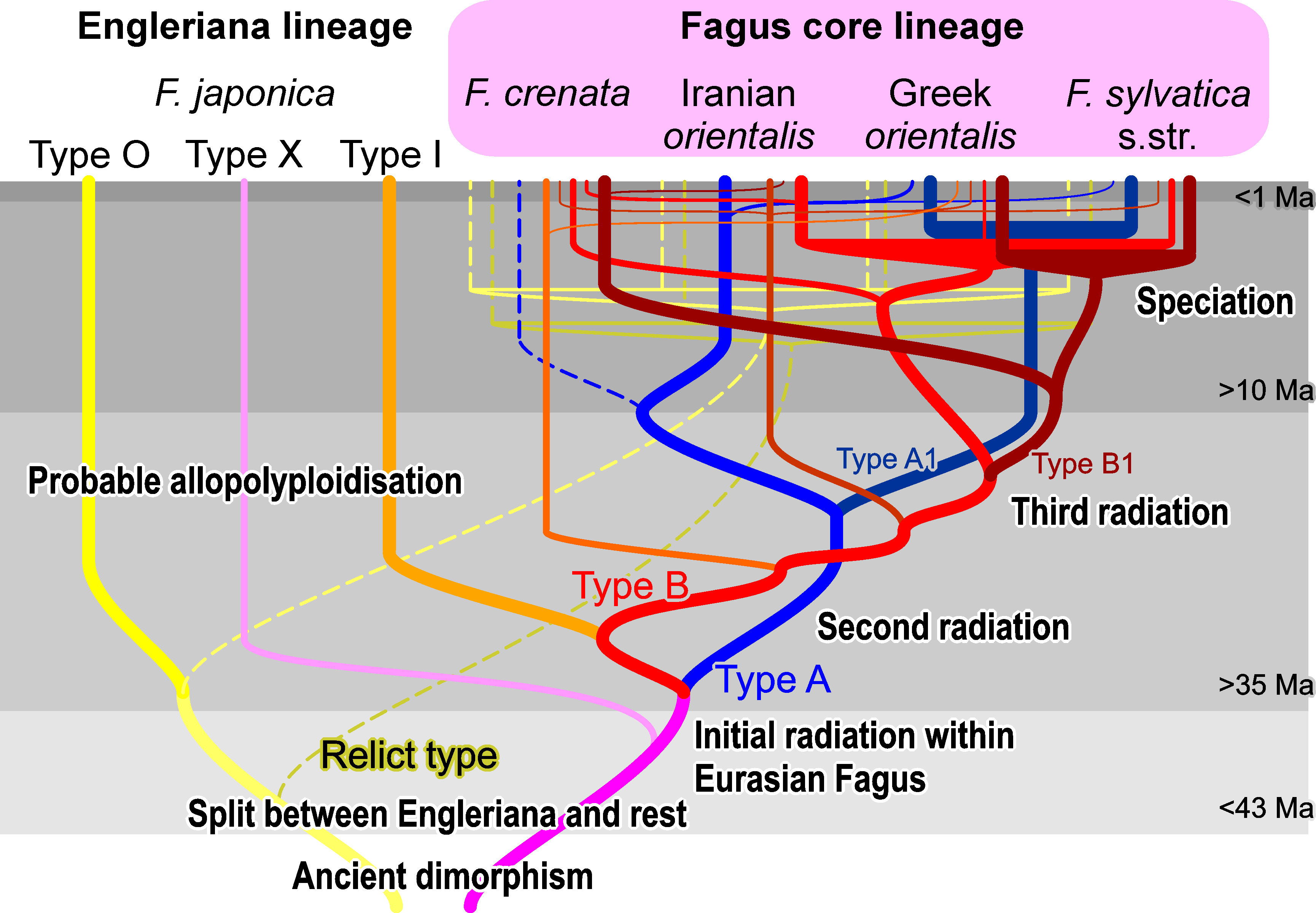 |
|
|
Piredda R, Grimm G, Schulze E-D, Denk T, Simeone M. 2021. High-throughput sequencing of 5S-IGS in oaks - exploring intragenomic variation
and algorithms to recognize target species in pure and mixed samples.
Molecular Ecology Resources 21: 495–510.
— Data available via figshare — Pre-print @ Authorea doi: 10.22541/au.158696014.43811940 — Open access — | 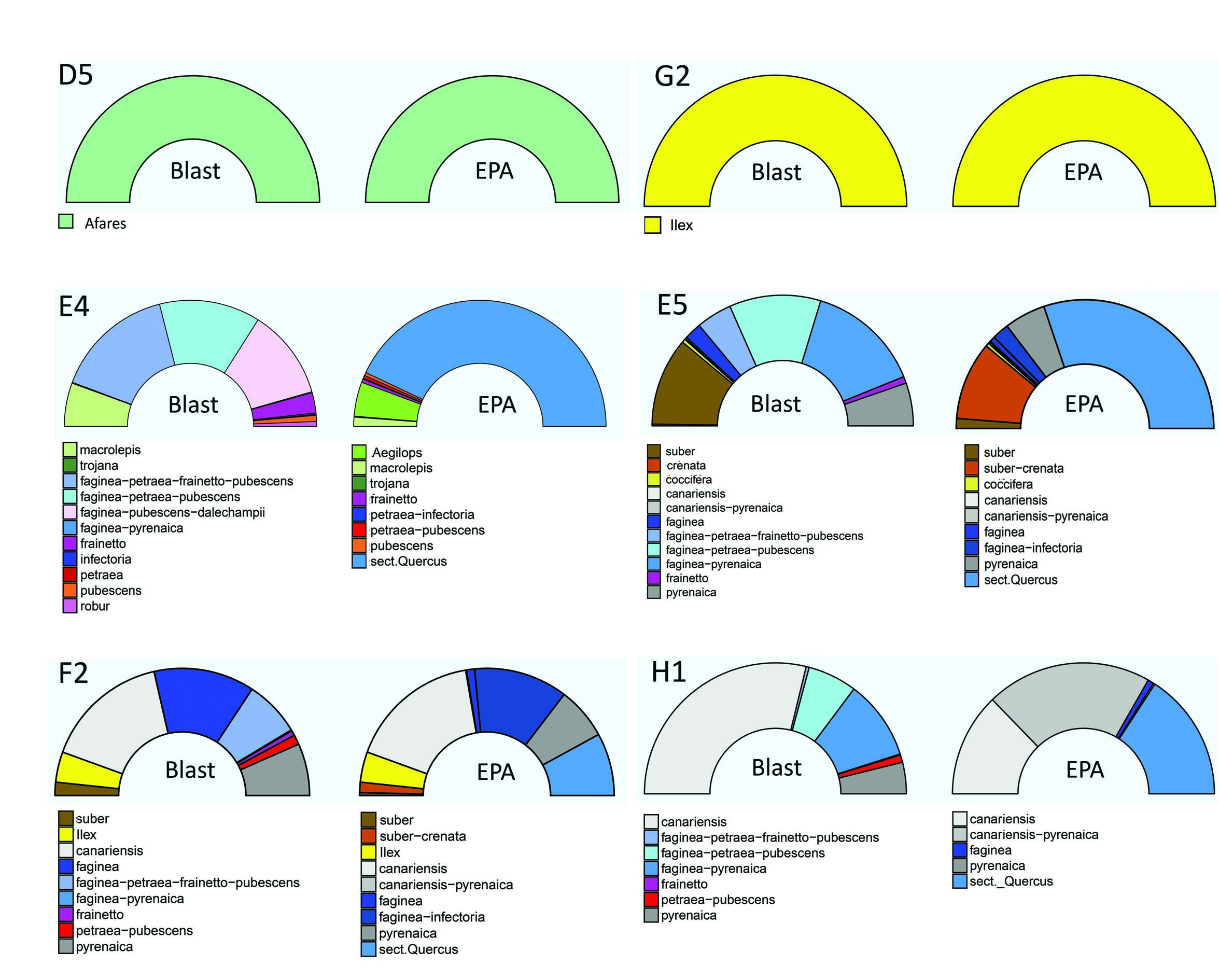 |
|
|
Liede-Schumann S, Grimm GW, Nürk NM, Potts AJ, Meve U, Hartmann HEK(†). 2020. Phylogenetic relationships in the
southern African genus Drosanthemum (Ruschioideae, Aizoaceae).
PeerJ 8: e8999.
— Open access —
— Data available via Datadryad — Pre-print @ bioRxiv — Related post @ Genealogical World of Phylogenetic Networks: Trees informing networks explaining trees | 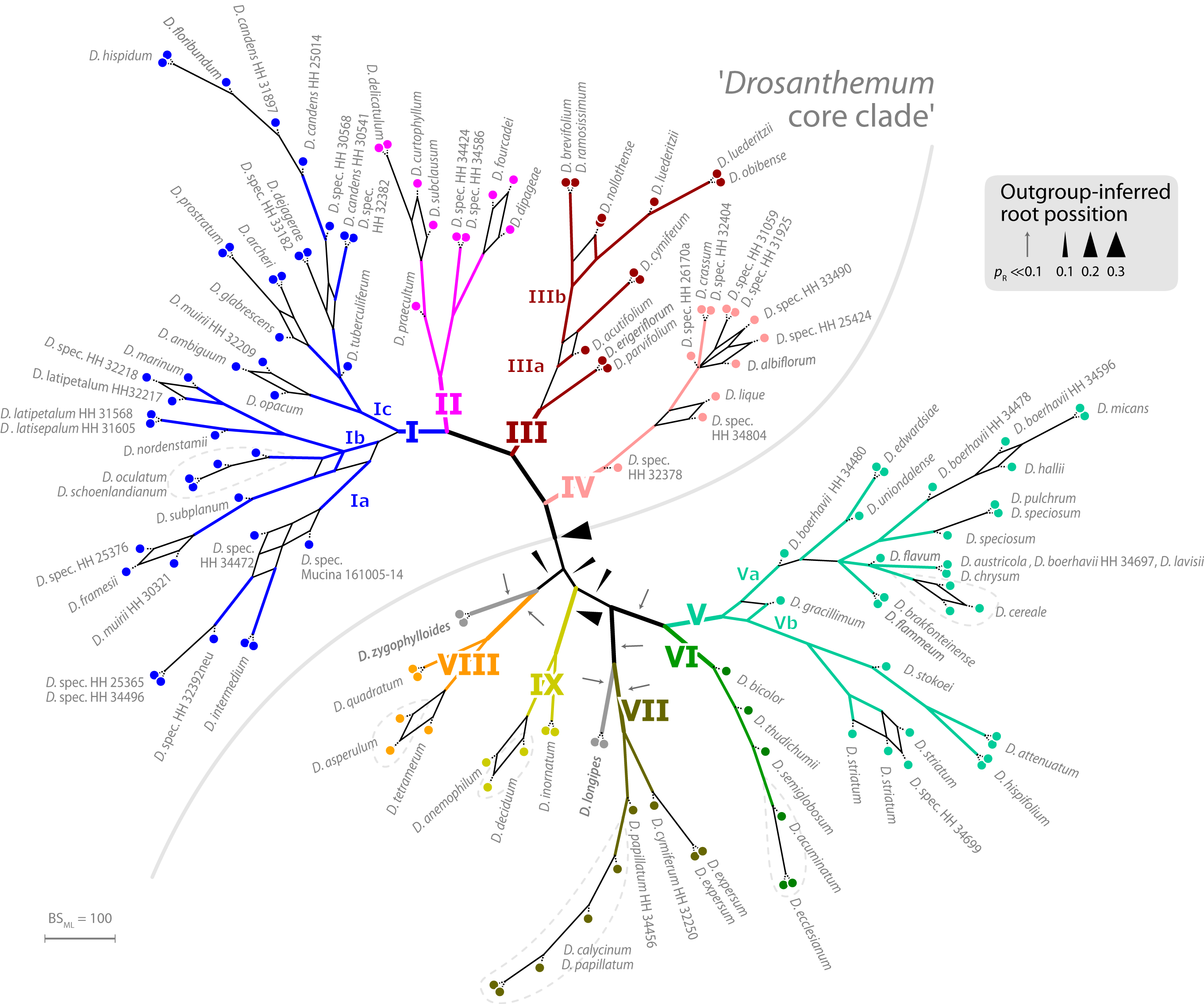 |
|
Power JM, Grimm GW, List JM. 2020. Evolutionary dynamics in the dispersal of sign languages.
Royal Society Open Science 7: 191100.
— Open access —
| 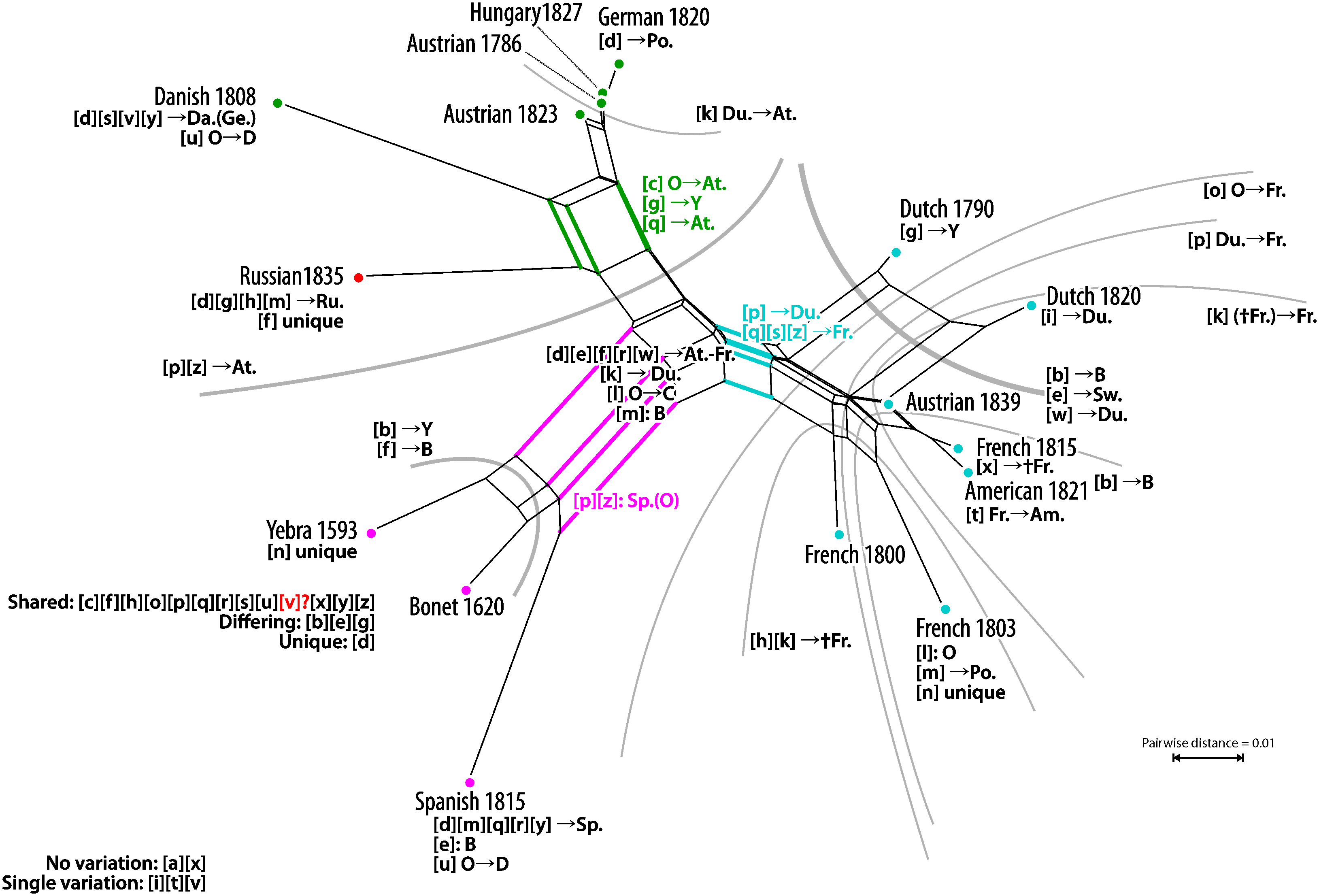 |
|
|
Hipp AL, Manos P, Hahn M et al. [+ 21 authors incl. me]. 2019. Genomic landscape of the global oak
phylogeny.
New Phytologist doi: 10.1111/nph.16162.
— Open access —
— Pre-print @ bioRxiv doi: 10.1101/587253 — Related post @ Genealogical World of Phylogenetic Networks: Next generation neighbor-nets. — Press release by Morton Arboretum via phys.org | 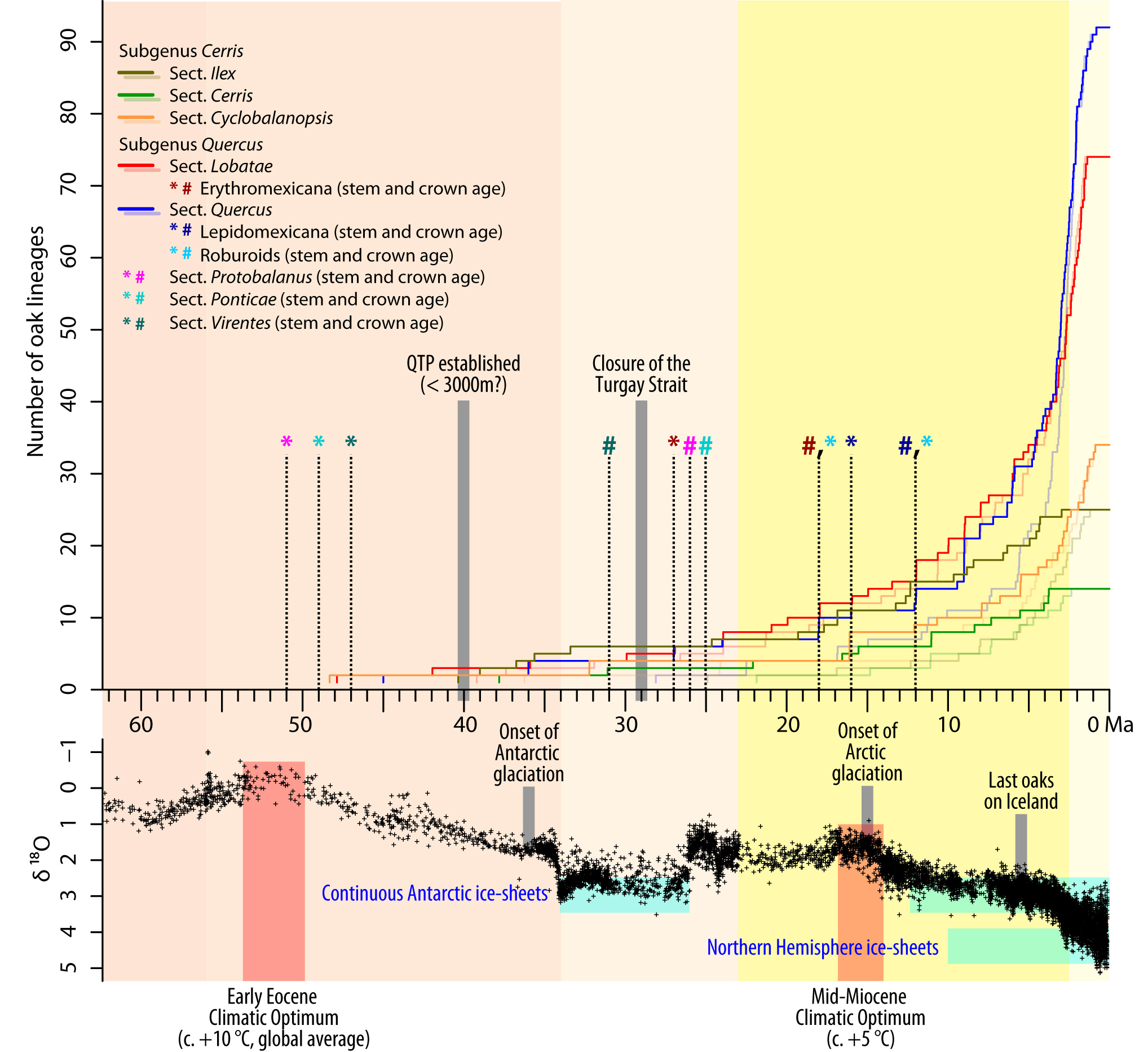 |
|
| Liede-Schumann S, Meve U, Grimm GW. 2019. New species in Drosanthemum (Aizoaceae: Ruschioideae). Bradleya 2019: 226–239. | 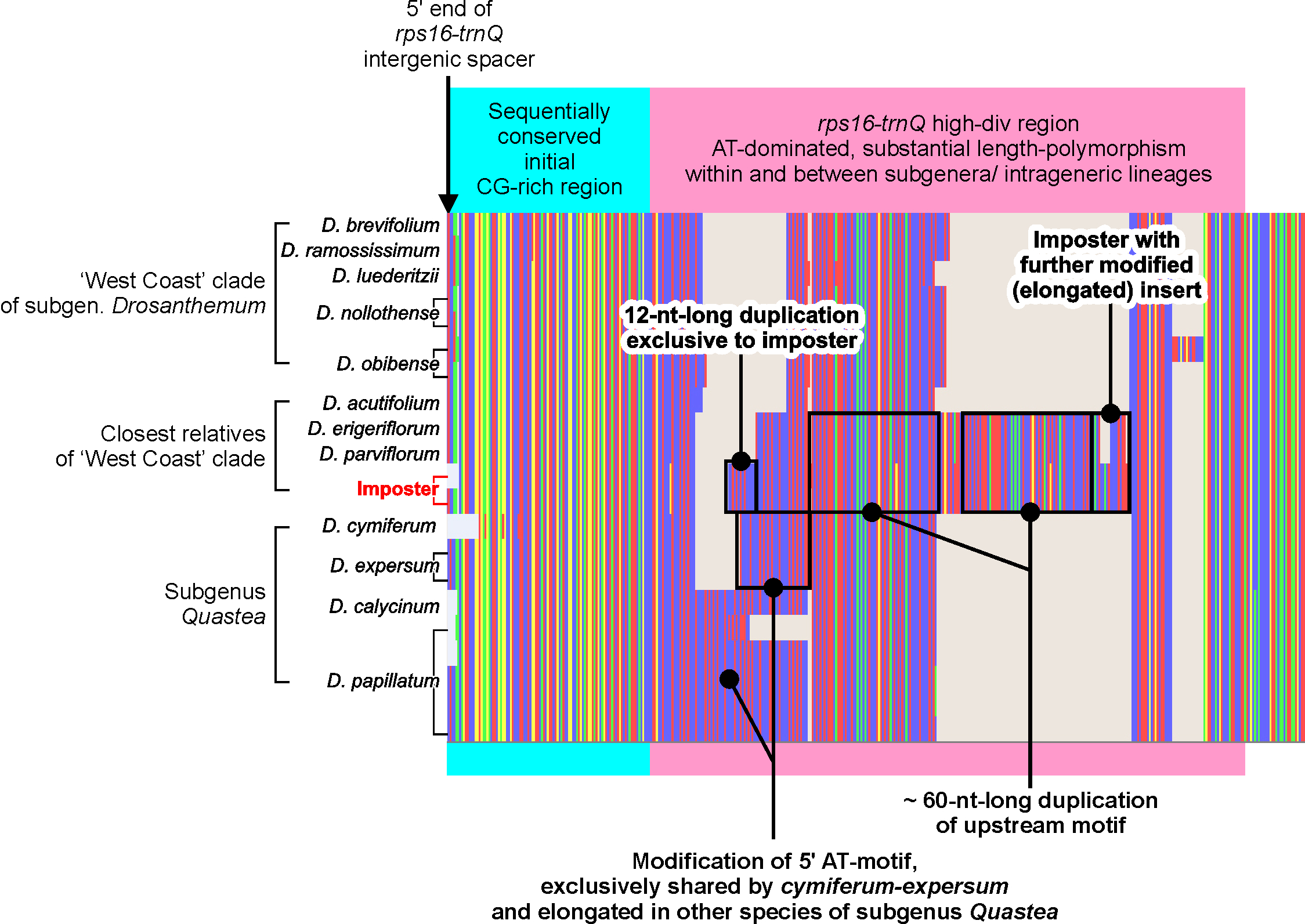 |
|
| Denk T, Zohner CM, Grimm GW, Renner SS. 2018. Plant fossils reveal major biomes occupied by the late Miocene Old-World Pikermian fauna. Nature Ecology & Evolution doi: 10.1038/s41559-018-0695-z | 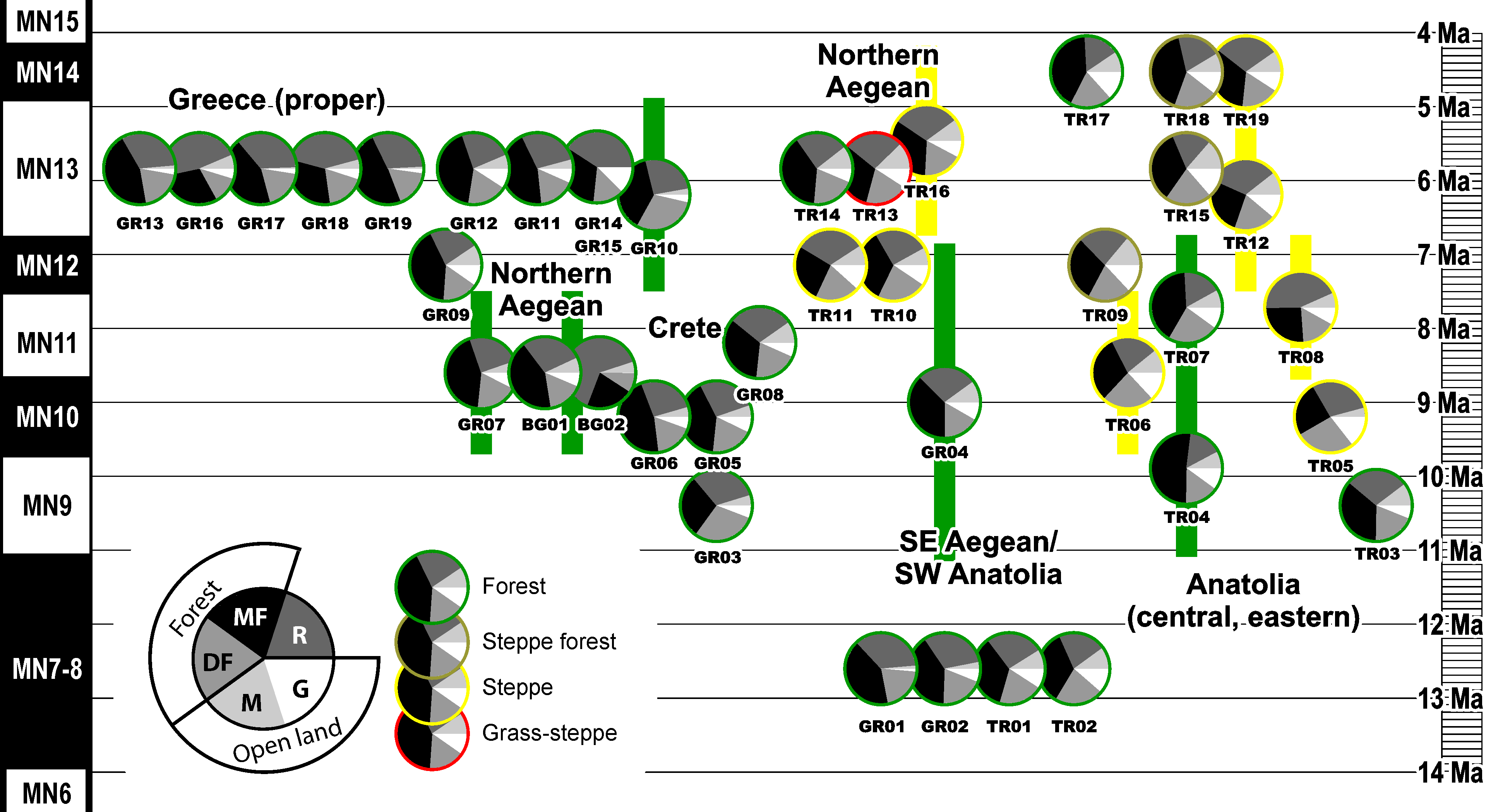 |
|
|
Grímsson F, Grimm GW, Potts AJ, Zetter R, Renner SS. 2018. A Winteraceae pollen tetrad from the
early Paleocene of western Greenland, and the fossil record of Winteraceae in Laurasia and Gondwana.
Journal of Biogeography 45: 567–581.
— "Bronze" (read-only) open access
— Supplementary Data Archive including mirrored online appendices (orginal file formats instead of PDFs), ML analysis files, and R-scripts/files for the probabilistic character mapping (Potts & Grimm 2017) and establishment of semi-quantitative Köppen signatures for generic lineages within modern Winteraceae. — Related reference [please cite this, too, when re-using the according R-script]: Potts AJ, Grimm GW. 2017. Ancestral state reconstruction of seven continuous and 20 categorical pollen traits scored for extant Winteraceae. Supplement to Grímsson et al. "A Winteraceae pollen tetrad from the early Paleocene of western Greenland, and the fossil record of Winteraceae in Laurasia and Gondwana". http://rpubs.com/AlastairPotts/WinterIsComing | 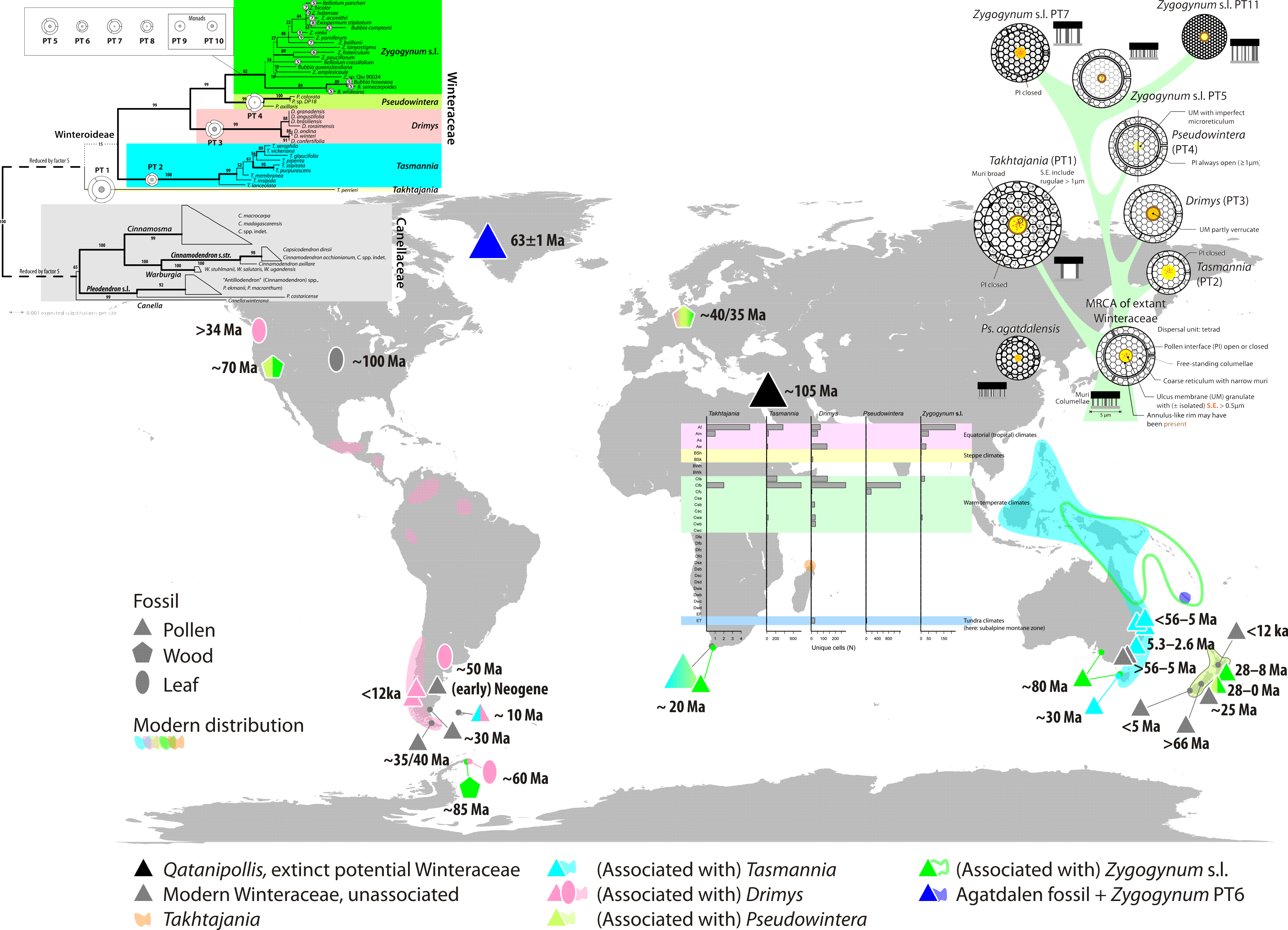 |
|
|
Grímsson F, Grimm GW, Zetter R. 2018. Evolution of pollen morphology in Loranthaceae.
Grana 57: 16–116.
— Open access funded by FWF —
— Mirror of the Online Supplementary Archive (OSA) including Files S1–S7 and various subfolders (see ReadMe.txt). File S6 [ PDF] is a re-analysis of the Loranthaceae and sistergroups subset included in Su et al., Taxon, 2015. See also my posts @ Genealogical World of Phylogenetic Networks: Using consensus networks to understand poor roots and @ Res.I.P.: Trivial but illogical – reconstructing the biogeographic history of the Loranthaceae (again) Info. File S6 has little relevance for the paper but became necessary to counter uninformed comments on the quality of my phylogenetic reconstructions and used data by one of the original reviewers, and a third anonymous reviewer (an “expert on phylogeny” according to the editor) recruited for the second round of reviews. | 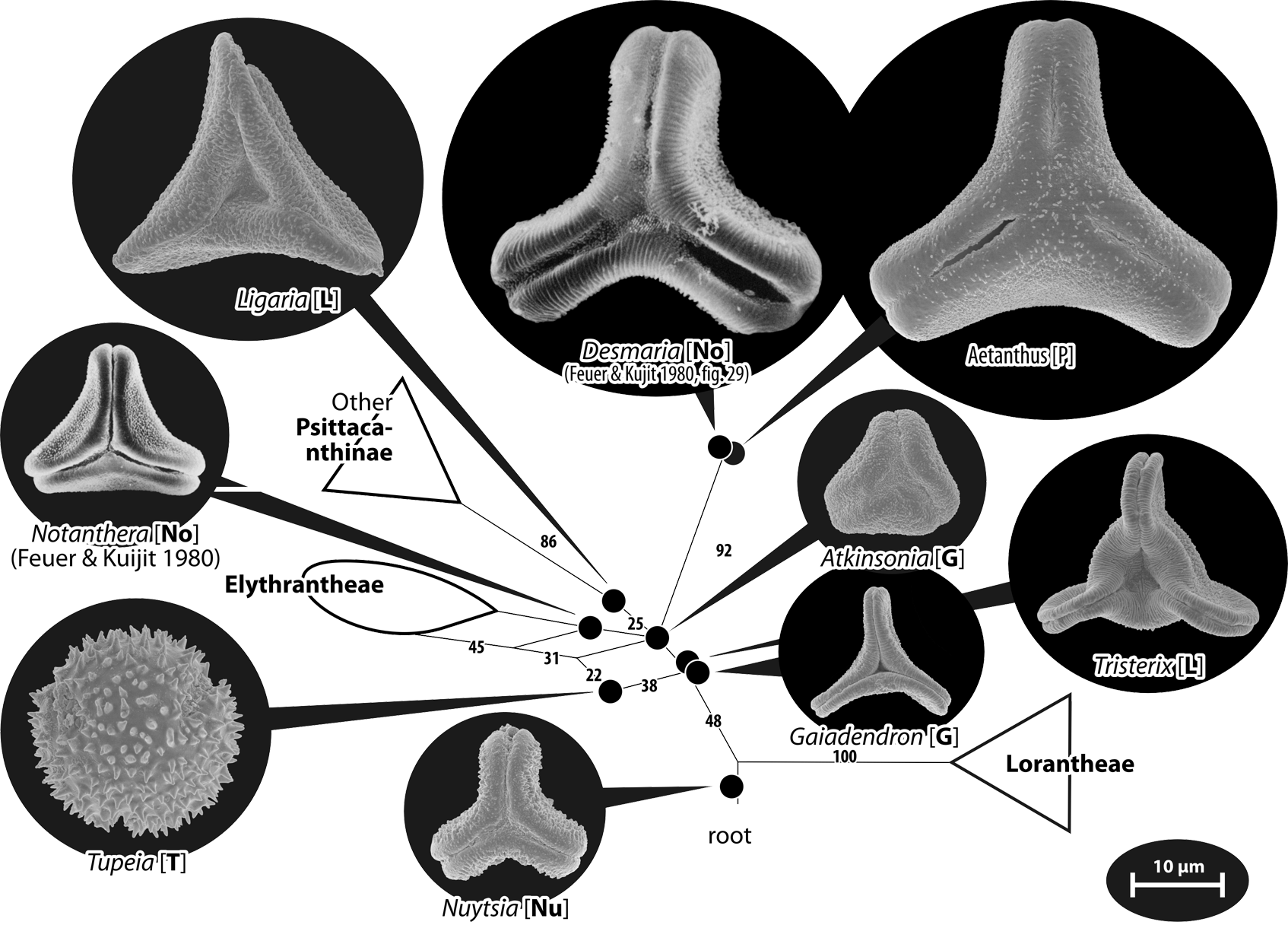 |
|
|
Simeone MC, Cardoni S, Piredda R, Imperatori F, Avishai M, Grimm GW, Denk T. 2018.
Comparative systematics and phylogeography of Quercus Section Cerris in western Eurasia: inferences from
plastid and nuclear DNA variation.
PeerJ 6: e5793. https://doi.org/10.7717/peerj.5793
— Open access —
— Link to preprint. — Primary data and analysis files included in the Online Supplemantary Archive, doi: 10.7287/peerj.preprints.26995v1/supp-4. See Readme.txt included in the topfolder of the archive. — Related post @ Genealogical World of Phylogenetic Networks: Reticulation at its best. | 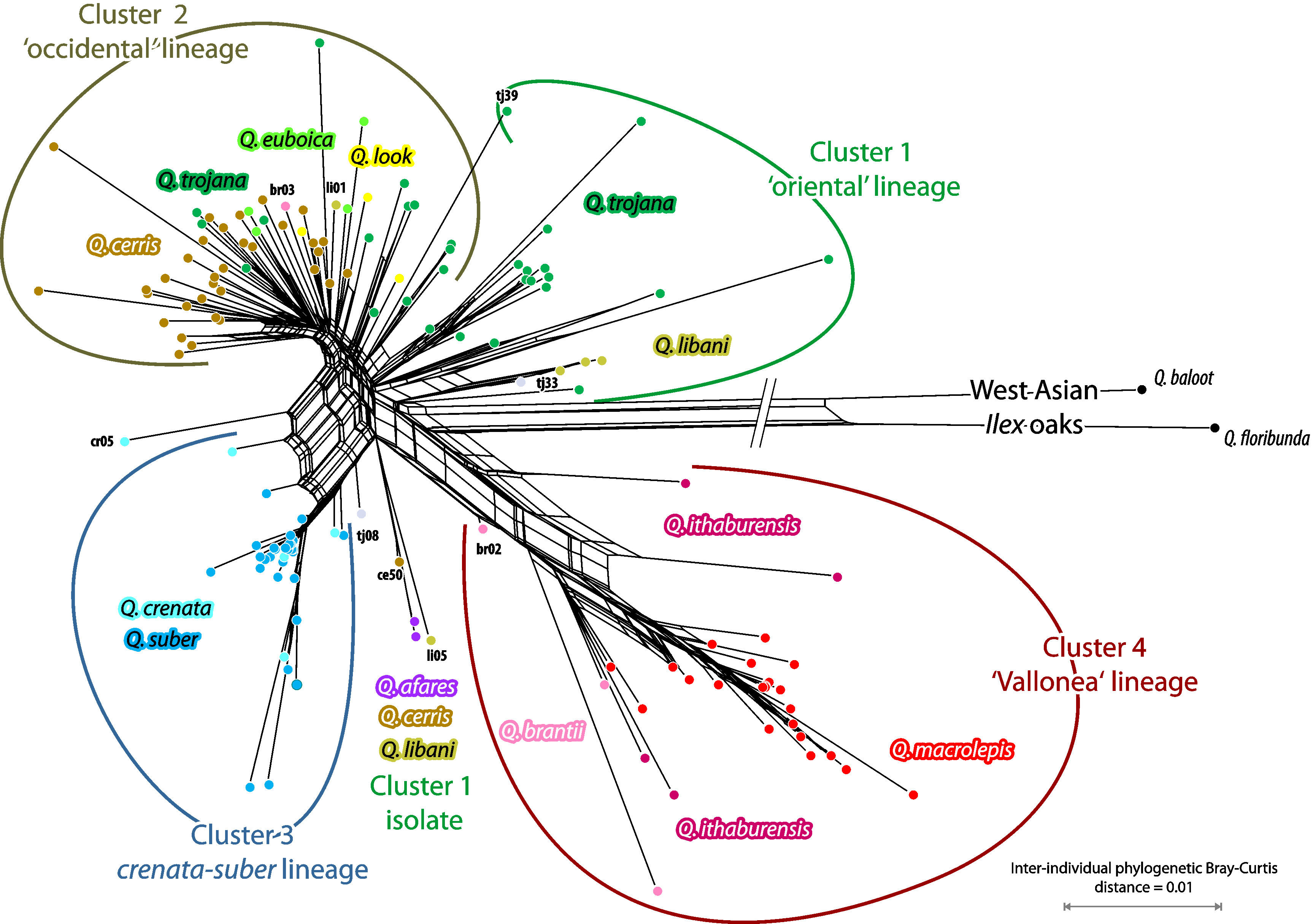 |
|
|
Banag CI, Mouly A, Alejandro GJD, Bremer B, Meve U, Grimm GW, Liede-Schumann S. 2017. Ixora
(Rubiaceae) on the Philippines - crossroad or cradle?
BMC Evolutionary Biology 17: 131 [e-pub].
— Open access —
— Electronic supplementary data archive ESA including all primary data and analysis files. — TreeBase entry for those who are fine with just a matrix and a tree. — Related post @ Genealogical World of Phylogenetic Networks | 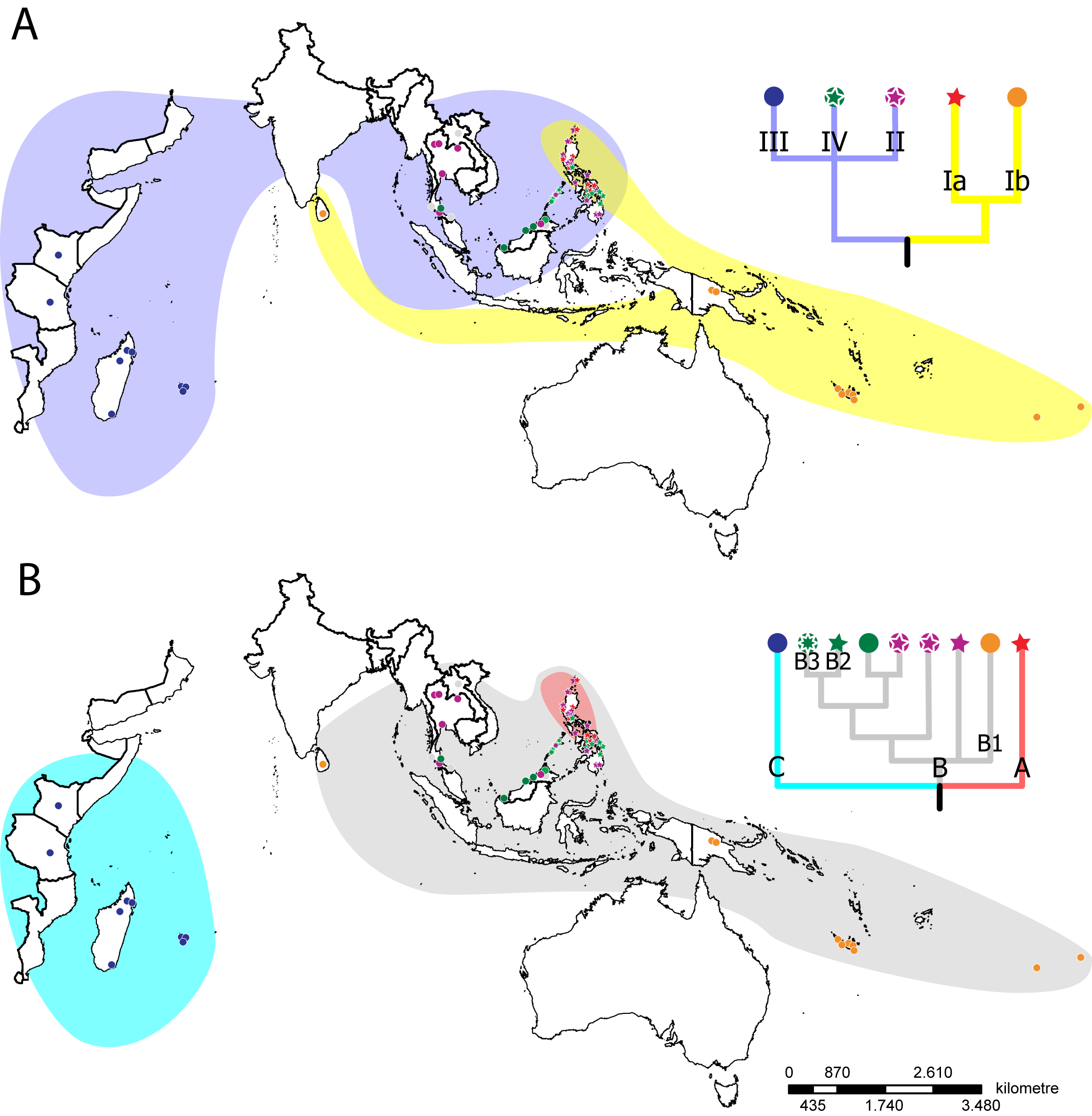 |
|
|
Bomfleur B, Grimm GW, McLoughlin S. 2017.
The fossil Osmundales (Royal Ferns)—a phylogenetic network analysis, revised taxonomy, and evolutionary
classification of anatomically preserved trunks and rhizomes.
PeerJ 5: e3433 [e-pub].
— Open access —
— Supplementary data archive — Related post @ Genealogical World of Phylogenetic Networks: Stacking neighbour-nets: A real-world example | 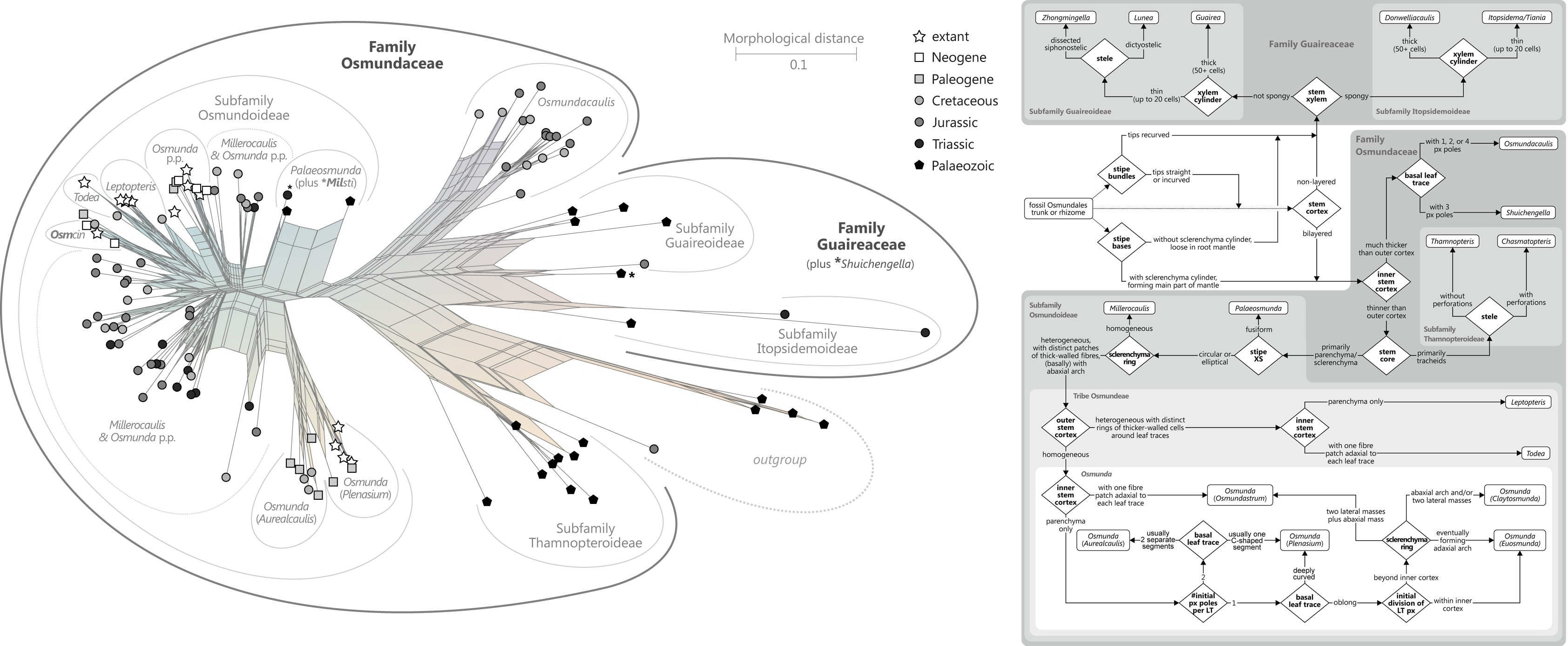 |
|
|
Denk T, Grimm GW, Manos PS, Deng M, Hipp AL. 2017. An updated infrageneric classification of the oaks:
review of previous taxonomic schemes and synthesis of evolutionary patterns.
In: E Gil-Pelegrín, JJ Peguero-Pina & D Sancho-Knapik
(eds): Oaks Physiological Ecology. Tree Physiology, vol. 7. Springer, Cham, p. 13–38.
— [Preprint@bioRxiv] — Appendix (comprehensive taxonomic table) as open data @ figshare. In case you have comments, suggestions for enhancing the information in the table, please contact the first author. | 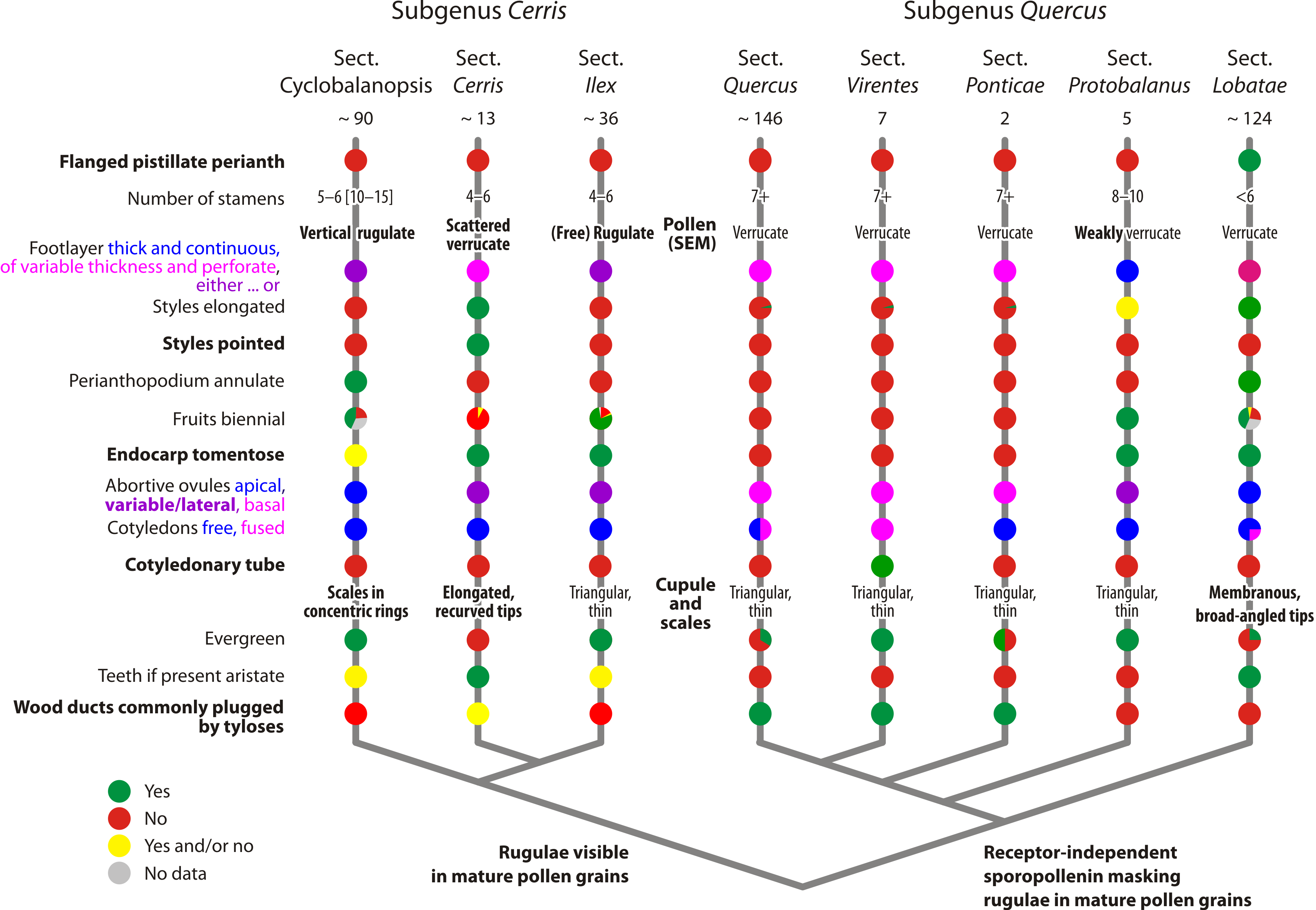 |
|
|
Denk T, Velitzelos D, Güner HT, Bouchal JM, Grímsson F, Grimm GW. 2017. Taxonomy and
palaeoecology of two widespread western Eurasian Neogene sclerophyllous oak species: Quercus drymeja Unger
and Q. mediterranea Unger.
Review of Palaoebotany & Palynology 241: 98–128.
*Disclaimer: Credits for eventual wrong links to ES files in this PDF, and any other error go to Elsevier's thoroughly incompetent (and annoying) but obviously cost-effective proof-editing, which is amazingly innovative regarding adding errors during every step of copy-editing and proof-setting. |  |
|
| Grímsson F, Grimm GW, Zetter R. 2017. Tiny pollen grains: first evidence of Saururaceae from the Late Cretaceous of western North America. PeerJ 5: e3434 [e-pub]. — Open access — | 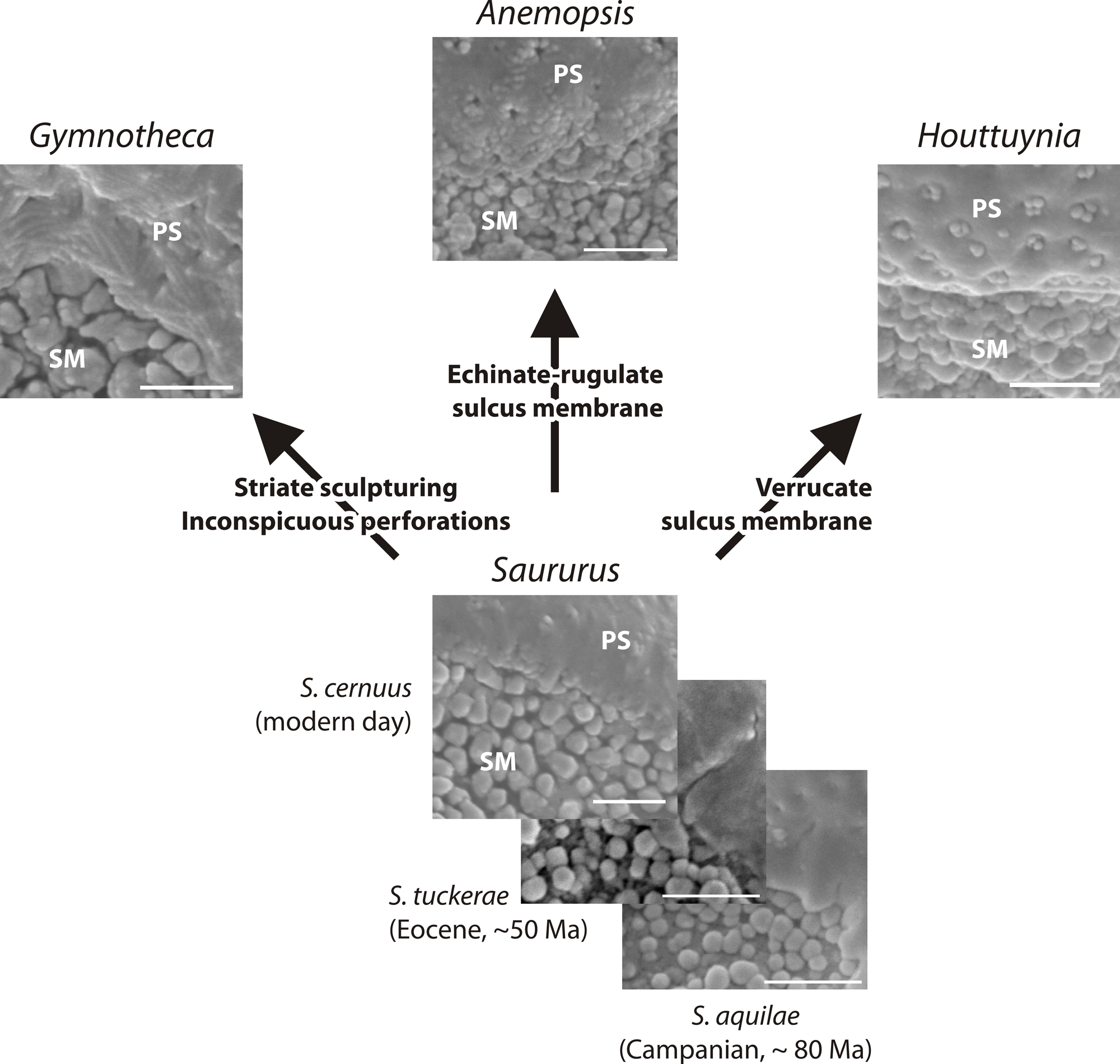 |
|
|
Grímsson F, Kapli P, Hofmann C-C, Zetter R, Grimm GW. 2017. Eocene Loranthaceae pollen pushes back
divergence ages for major splits in the family.
PeerJ 5: e3373 [e-pub].
— Open access —
— Data and analysis files provided as online supplementary archive in the supplemental information (citable DOI: 10.7717/peerj.3373/supp-8). — Related post @ Res.I.P.: Trivial but illogical – reconstructing the biogeographic history of the Loranthaceae (again) | 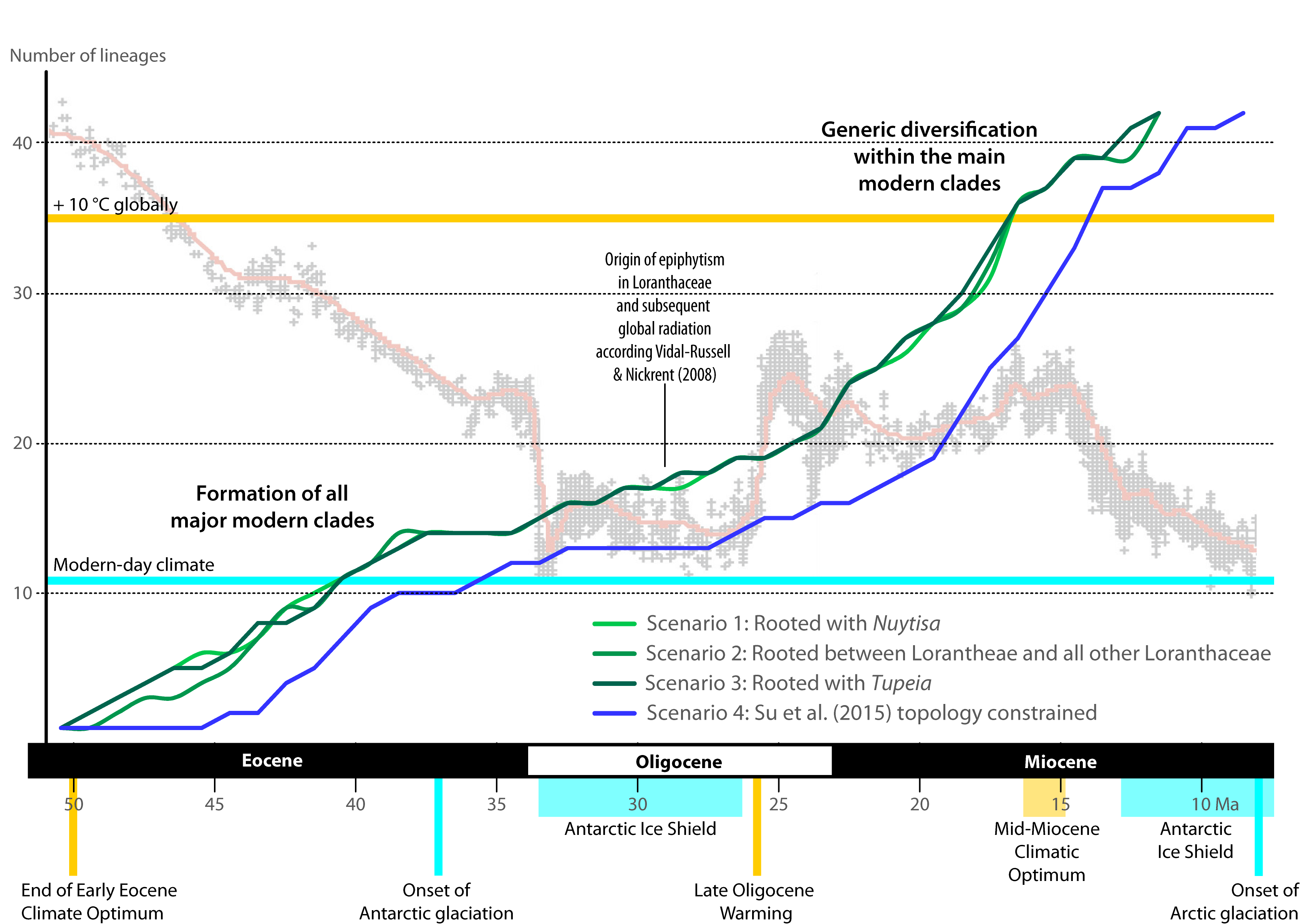 |
|
|
Schliep K, Potts AJ, Morrison DA, Grimm GW. 2017. Intertwining phylogenetic trees and networks.
Methods in Ecology & Evolution 8: 1212–1220. — Open access —
— Vignette introducing the new functions implemented in the phangorn library for R. Feel free to cite this paper and Schliep (2011) when making use of them. — github access to the phangorn library files. — Archive including the analysis files for the bear data example used in the paper. — (Spartanic) preprint @ PeerJ Preprints — David's post on his network blog. | 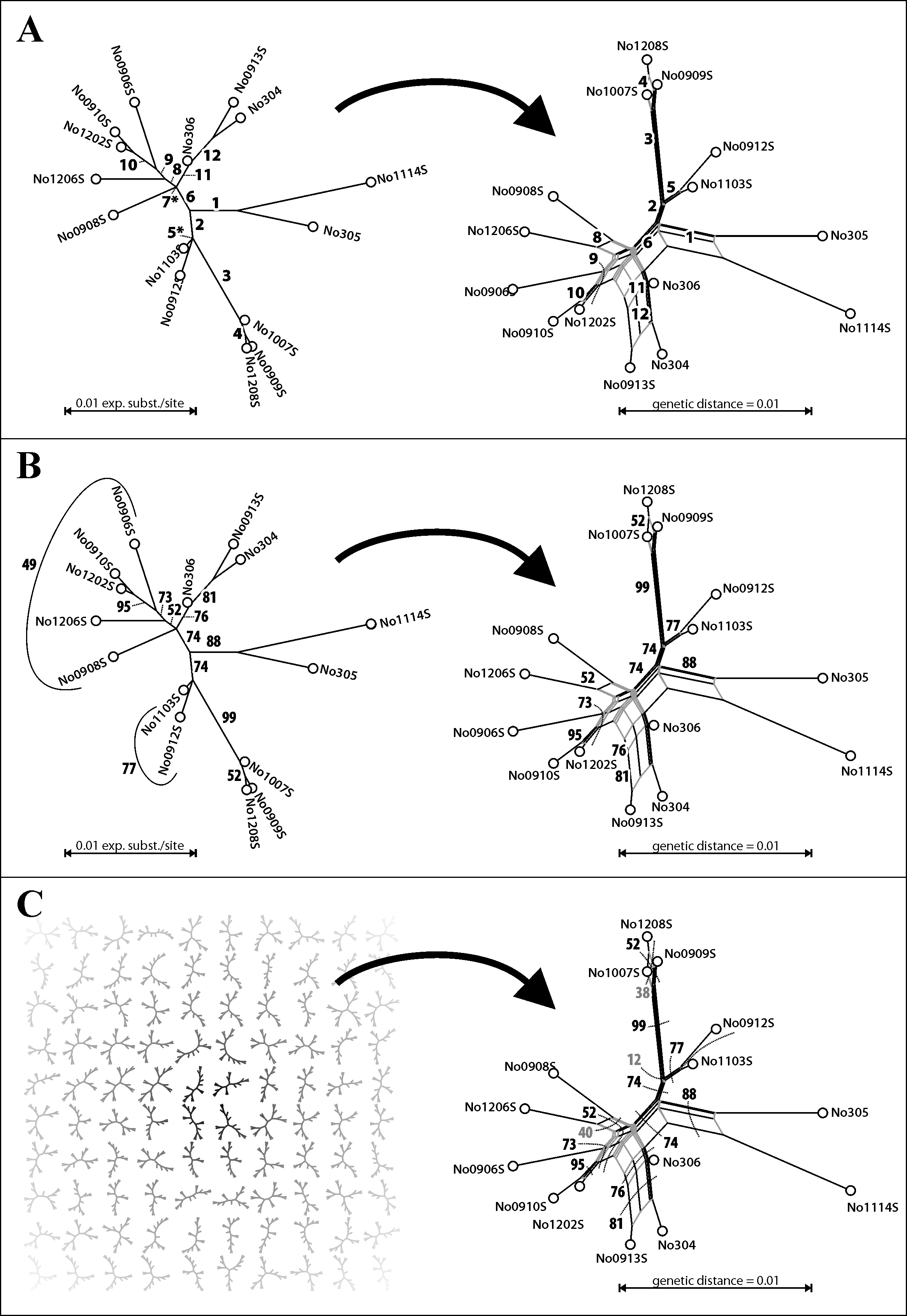 |
|
| Vitelli M, Vesella F, Cardoni S, Pollegioni P, Denk T, Grimm GW, Simeone MC. 2017. Phylogeographic structuring of plastome diversity in Mediterranean oaks (Quercus Group Ilex, Fagaceae). Tree Genetics & Genomes 13: 3 [e-pub] | 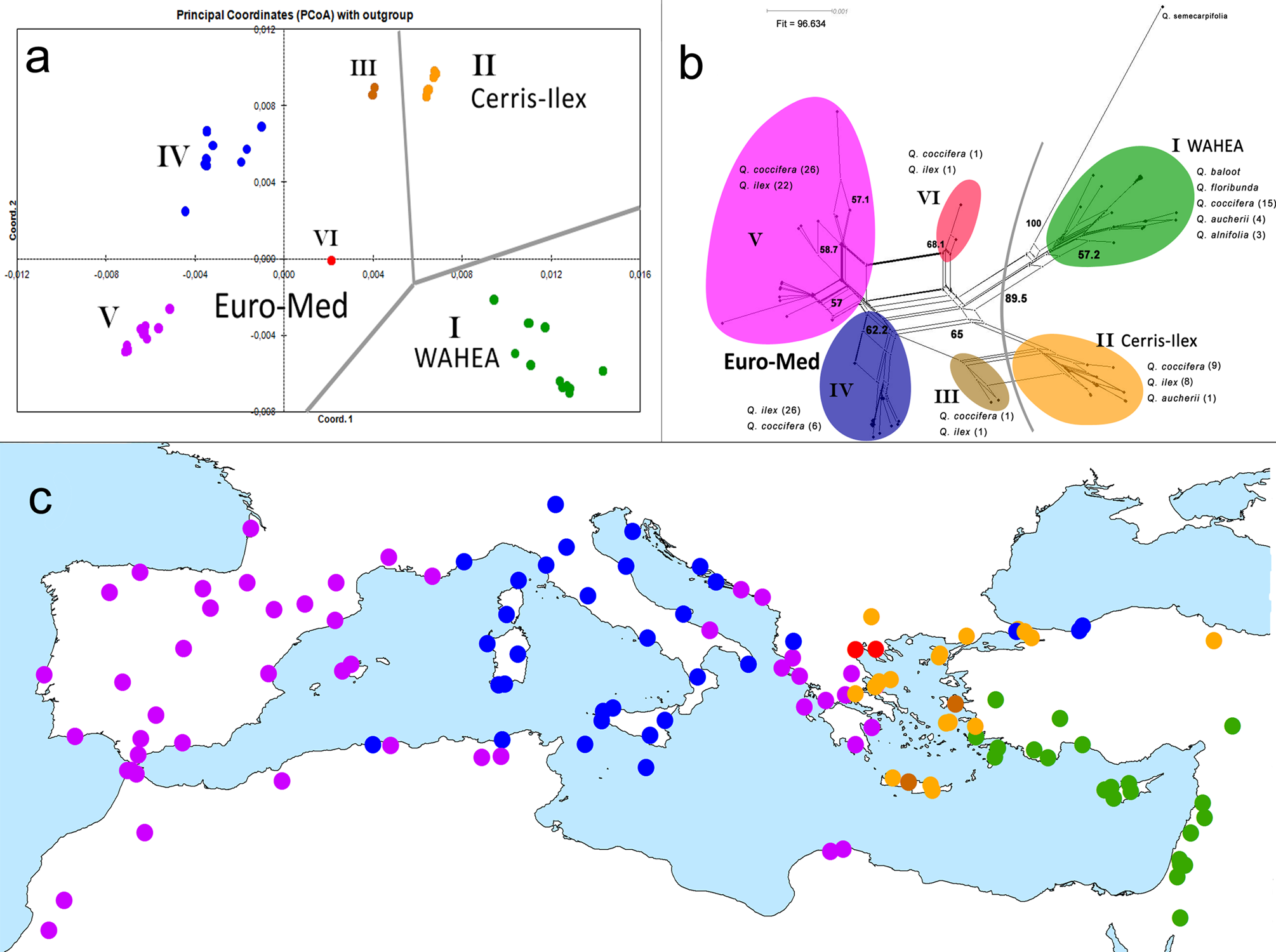 |
|
|
Grimm GW, Potts AJ. 2016. Fallacies and fantasies: the theoretical underpinnings of
the Coexistence Approach for palaeoclimate reconstruction.
Climates of the Past 12: 611–622.
— Open access funded by the FWF —
— Open review: Climates of the Past Discussion 11: 5727–5754. — The "Coexistence Approach", a "standard method in palaeoclimate reconstructions": unvalidated, theoretically flawed, poorly applied, but as long as peer review process remains "confidential" its fans can pretend all's well. Related posts on Res.I.P.: Business as usual – PPP keeps on publishing Coexistence Approach pseudo-results Trying to disperse the Impermeable Fog #2: Editors who "entertain" and are not "answerable" Note.This is the follow-up paper to the next one, submitted nine months later but published earlier because of the fact that the journal follows an open-review policy with strict guidelines. I invited all authors of the Utescher et al. (2014) paper to use the opportunity to comment on the paper (CoP Disscussion) in the two-month open-for-discussion phase. | 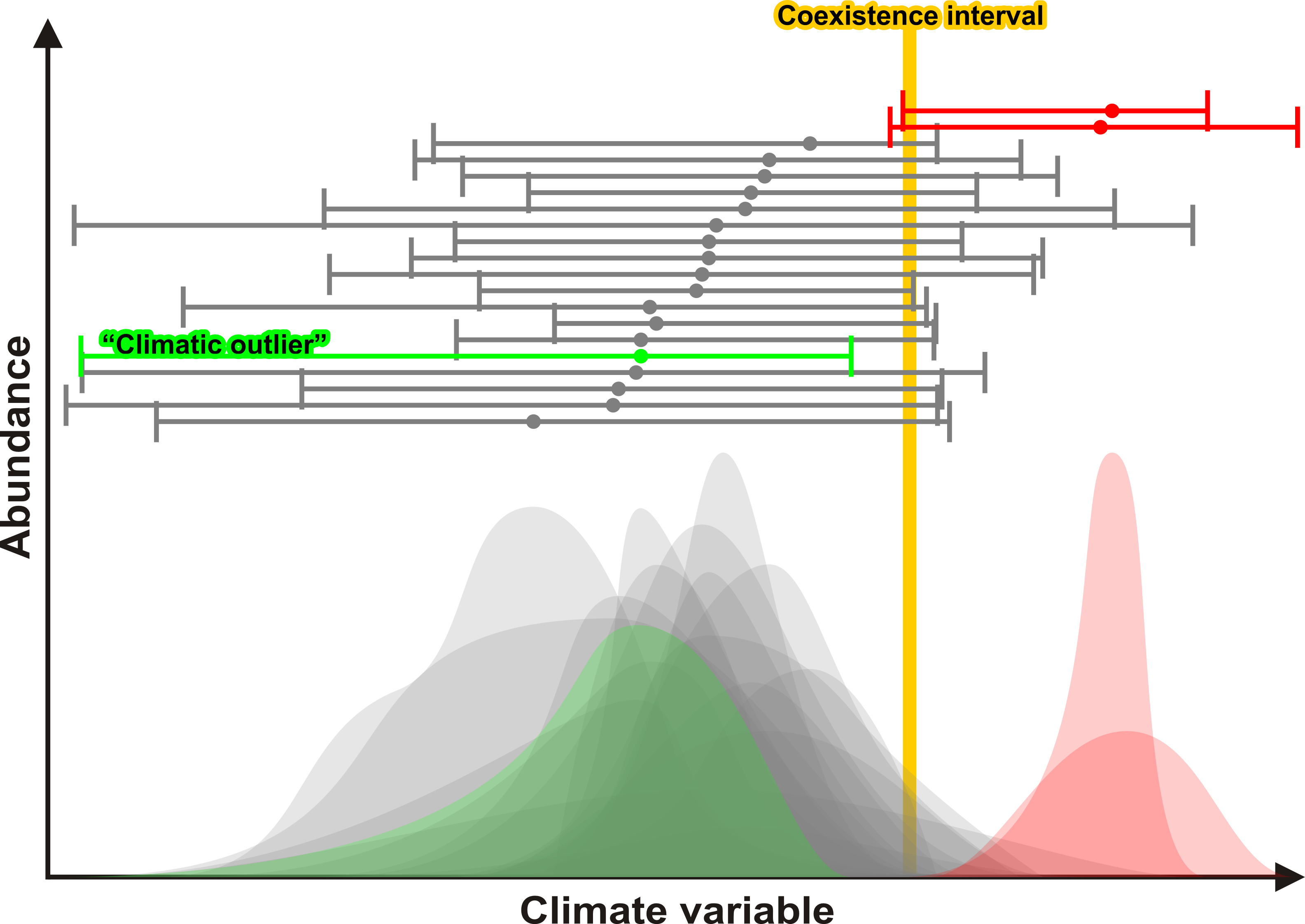 |
|
|
Grimm GW, Bouchal JM, Denk T, Potts AJ. 2016. Fables and foibles: a critical analysis
of the Palaeoflora database and the Coexistence approach for palaeoclimate reconstruction.
Review of Palaeobotany & Palynology 233: 216–235.
— Online Supplementary Archive (OSA) including Files S1–S6, Tables S1–S4. — Preprint@bioRxiv — Open access — Background info. This paper has been in review for 450 days as the editors struggled hard to acquire a second review due to the "complexity" of the paper (and was then accepted with minor revisions). The complexity being that the paper reveals the striking gap between the purported theory and actual application of the Coexistence Approach based on the so-far only CA/Palaeoflora study (Quan et al., Palaegeogr. Palaeoclim. Palaeoecol. [P^3], 2012) providing full documentation of the used data. Our in-depth comparison reveals that the famed precision of CA/Palaeoflora studies is based on poor climate data riddled by inconsistencies such as smaller family intervals than those of their constituent genera, erroneous or dubious fossil-NLR associations, inconsistent, partly illogical taxon filtering, and frequent violations of some or all four basic assumputions by those NLRs that actually define coexistence intervals. Probably to obscure these severe deficiencies, CA/Palaeoflora studies generally refrained from adequate documentation of the used data, albeit Utescher et al., P^3, 2014, recommend themselves to document all used climate data and NLR associations (however, not done in any CA/Palaeoflora paper co-authored by Utescher and colleagues in 2015 or 2016) | 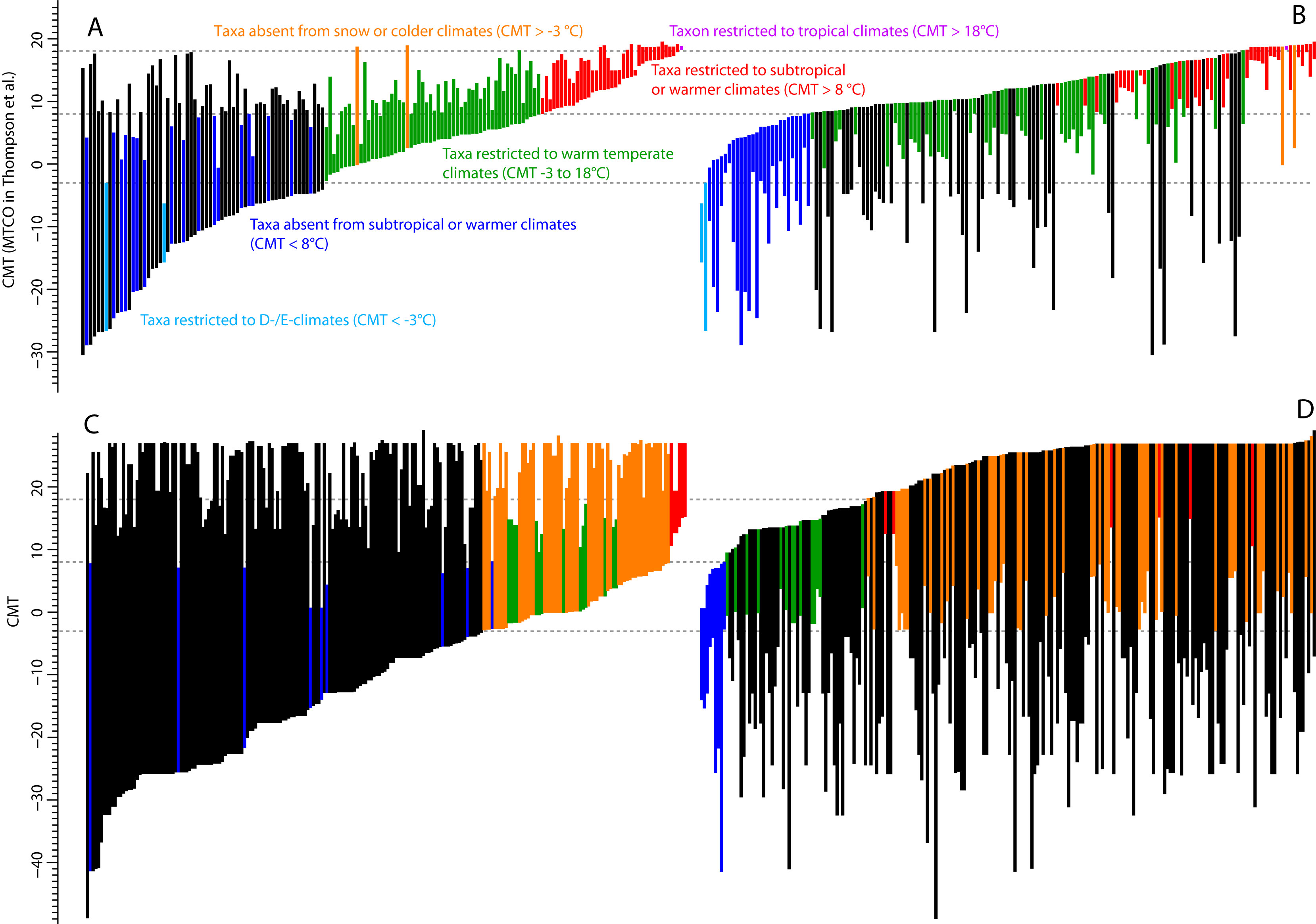 |
|
|
Grímsson F, Grimm GW, Meller B, Bouchal JM, Zetter R. 2016. Combined LM and SEM study of the
middle Miocene (Sarmatian) palynoflora from the Lavanttal Basin, Austria: Part IV. Magnoliophyta 2 –
Fagales to Rosales.
Grana 55: 101–163.
— Open access funded by the FWF —
— Electronic Supplementary File S1: Tabulation of Köppen signatures of potential modern analogues of fossil taxa described in the paper. | 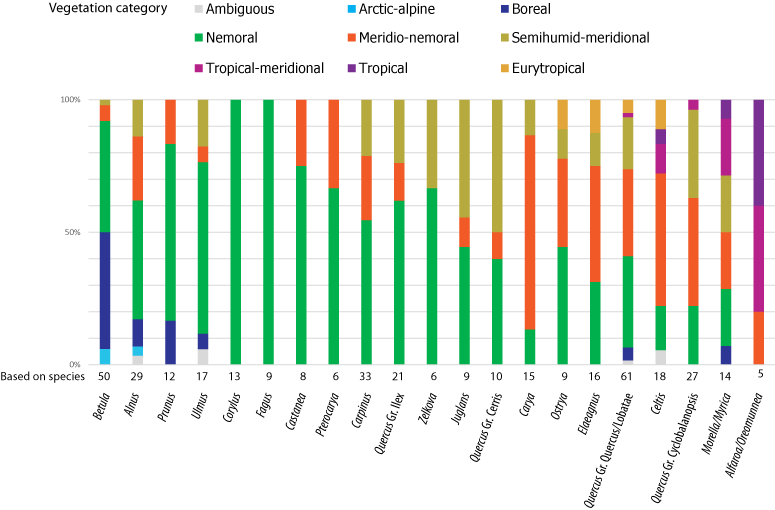 |
|
|
Grímsson F, Grimm GW, Zetter R, Denk T. 2016. Cretaceous and Paleogene Fagaceae from North America
and Greenland: evidence for a Late Cretaceous splits between Fagus and the remaining Fagaceae
Acta Palaeobotanica 56: 247–305.
— Open access —
— Archive (OSA) including Supplement Files S1–S4. — Related post @ Res.I.P. The challenging and puzzling ordinary beech – a (hi)story | 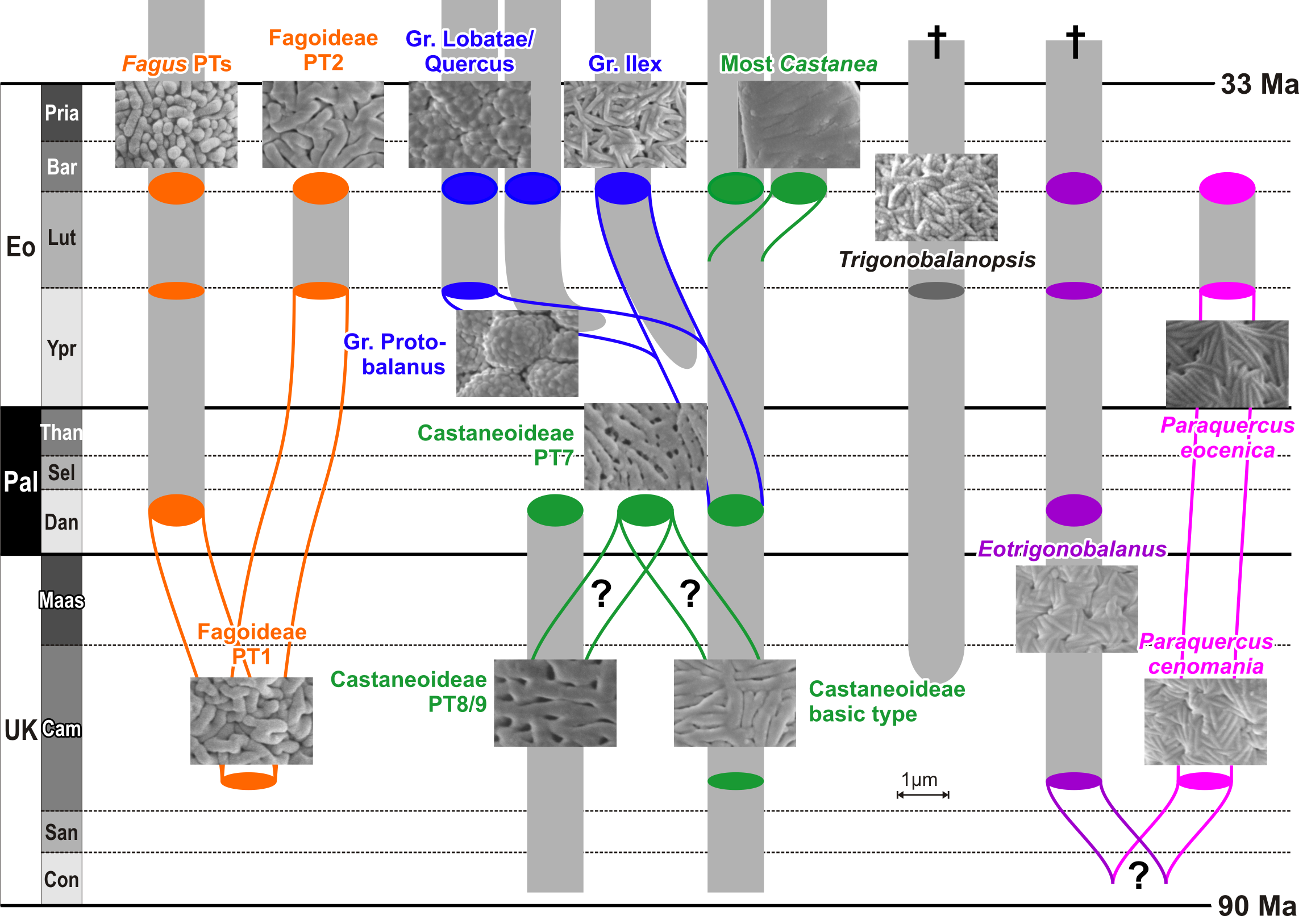 |
|
| Grímsson F, Krarup Pedersen G, Grimm GW, Zetter R. 2016. A revised stratigraphy for the Paleocene Agatdalen flora (Nuussuaq Peninsula, western Greenland): correlating fossiliferous outcrops, macrofossils and palynological samples from phosphoritic nodules. Acta Palaeobotanica 56: 307–327. — Open access — | 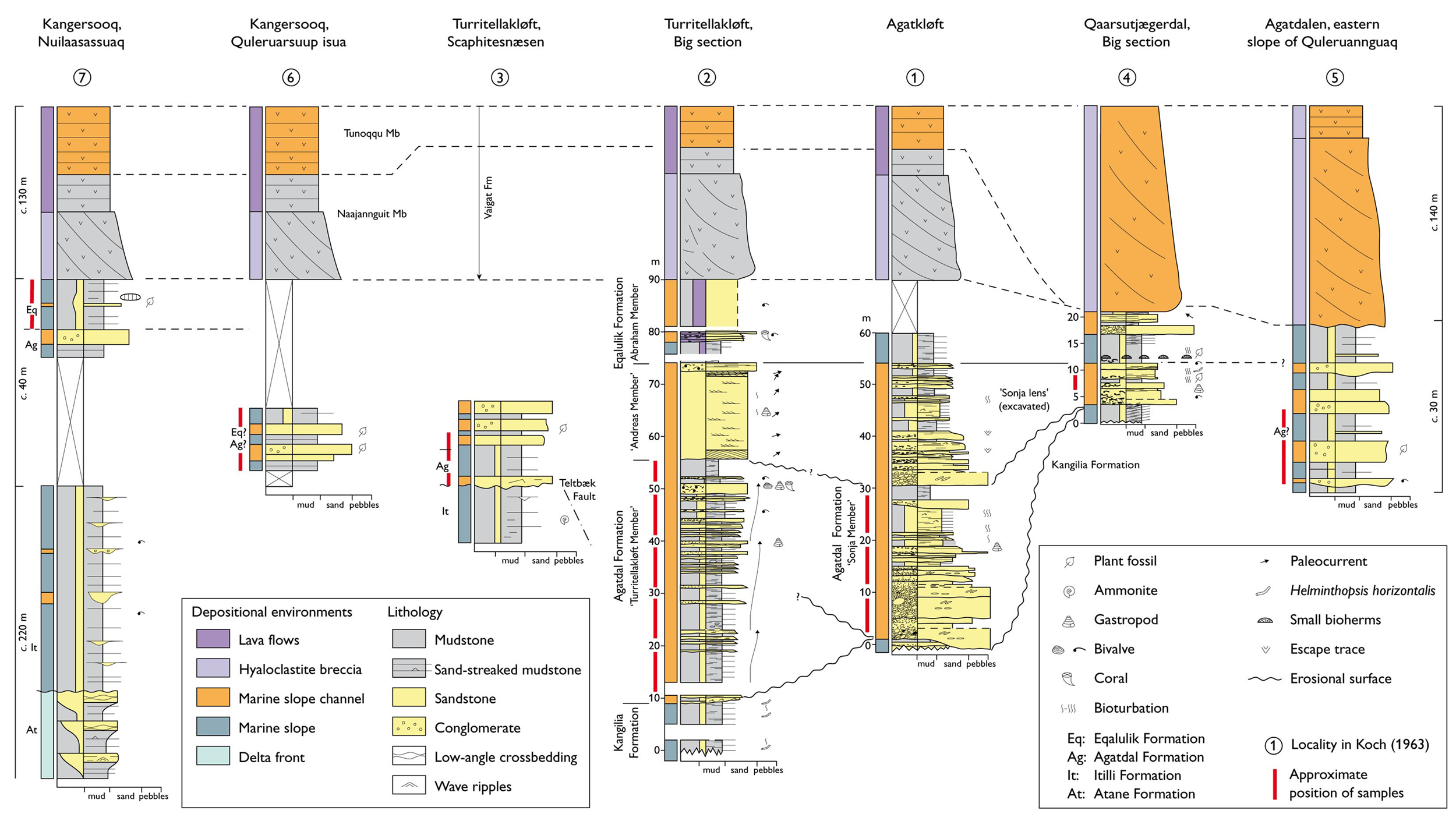 |
|
|
Khanum R, Sureswaran S, Meve U, Liede-Schumann S. 2016. Cynanchum (Apocynaceae:
Asclepiadoideae): A pantropical Asclepiadoid genus revisited.
Taxon 65: 467–486.
NOTE: Retreated from coauthorship during final review phase to protest [PDF] against editorial policies. See also this Res.I.P. post: What I was not allowed to show #2. — Online Supplementary Archive (OSA) including supplement files and files for analysis (Bayesian inference, maximum likelihood). [This is a mirror of the archive submitted with the original and 1st and 2nd revised versions of the paper, check the finally accepted version of the paper for link to final OSA.] | 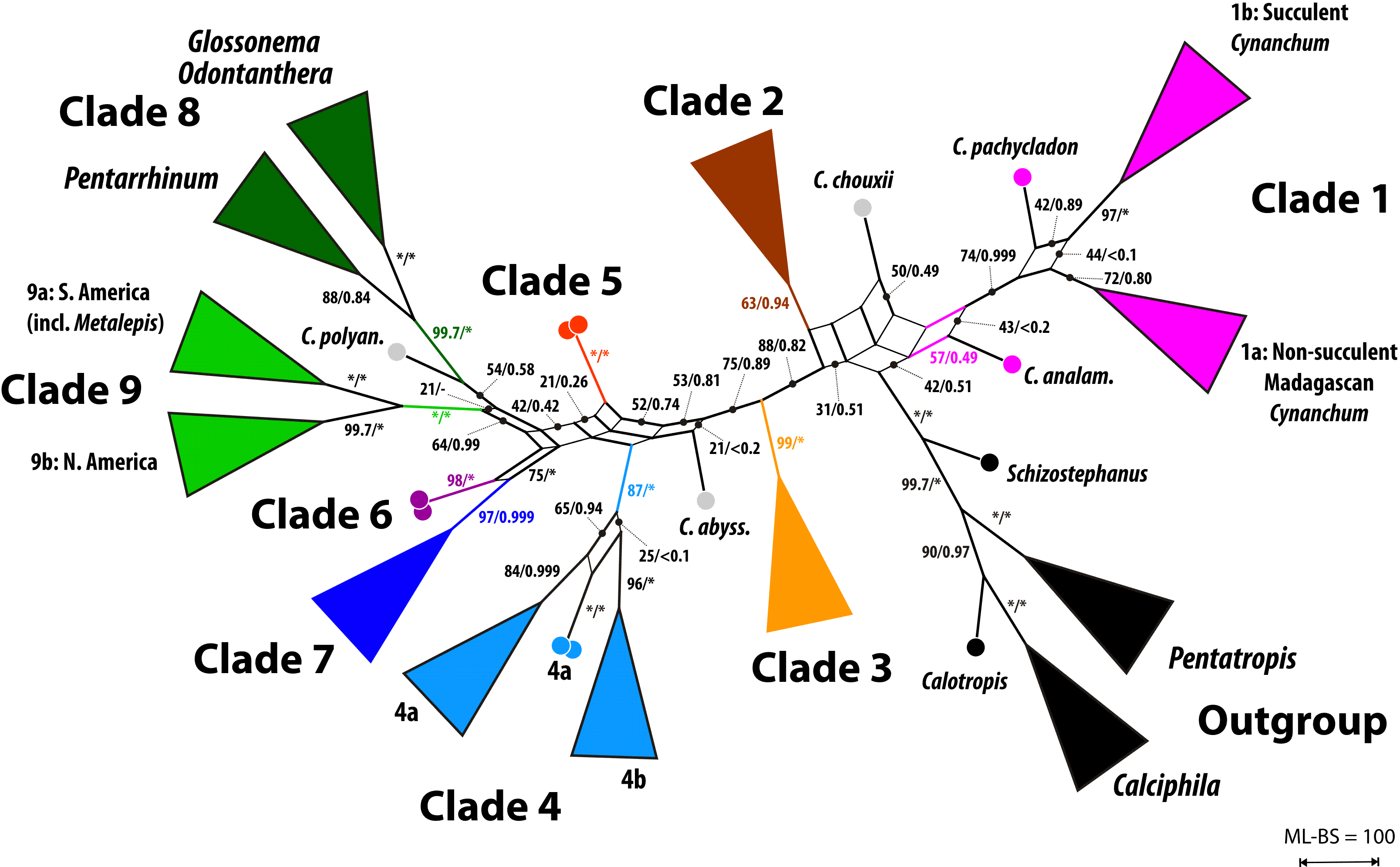 |
|
|
Renner SS, Grimm GW, Kapli P, Denk T. 2016. Species relationships and divergence times in beeches:
new insights from the inclusion of 53 young and old fossils in a birth-death clock model.
Philosopical Transactions of the Royal Society B 371: 20150135, doi: 10.1098/rstb.2015.0135.
— Related post @ Res.I.P. The challenging and puzzling ordinary beech – a (hi)story | 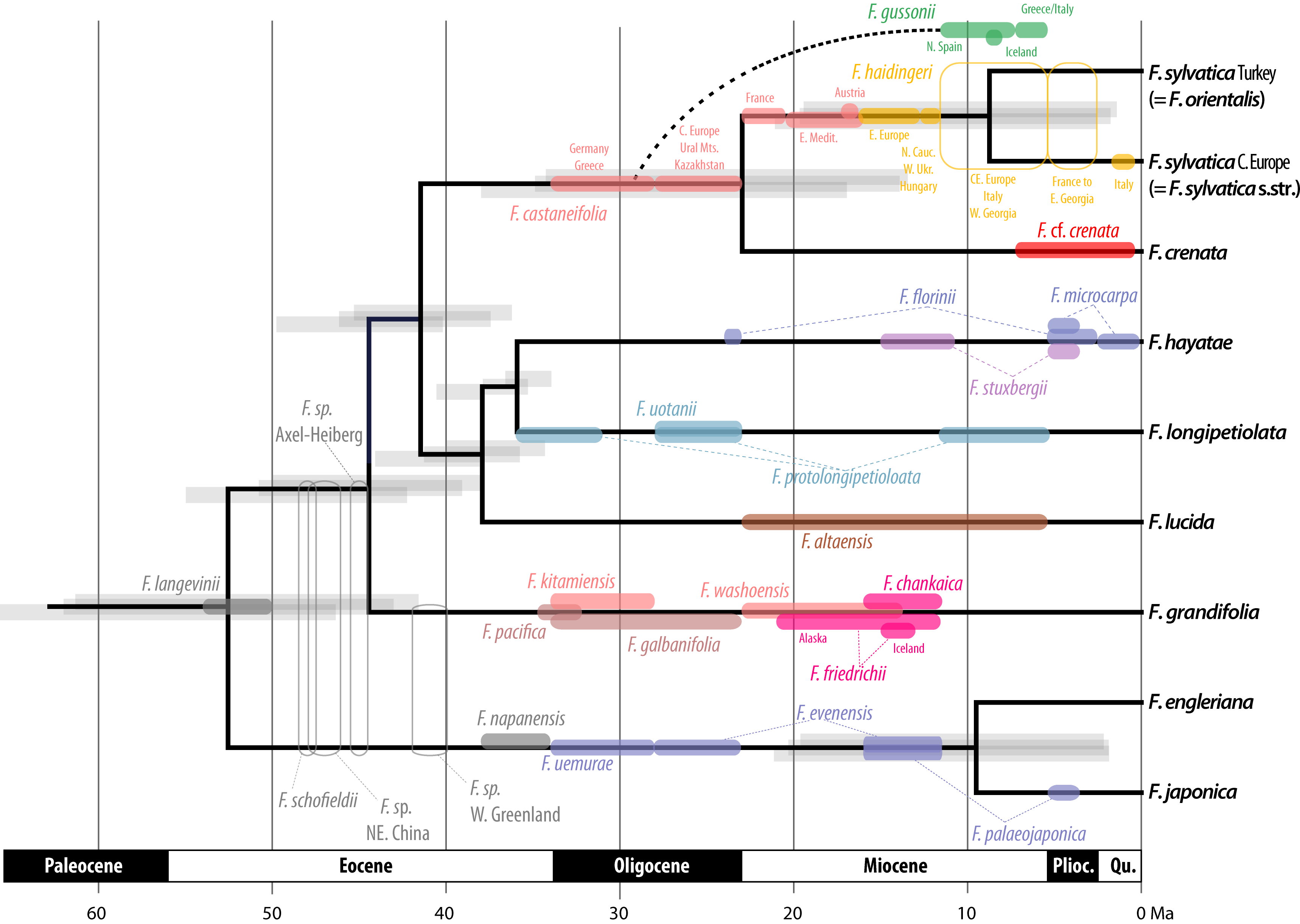 |
|
| Schulze ED, Aas G, Grimm GW, Gossner MM, Walentowski H, Ammer C, Kühn I, Bouriaud O, von Gadow K. 2016. A review on plant diversity and forest management of European beech forests. European Journal of Forest Research 135: 51–67. — Open access — |  |
|
|
Simeone M, Grimm GW, Papini A, Vessella F, Cardoni S, Tordoni E, Piredda R, Franc A, Denk T. 2016.
Plastome data reveal multiple geographic origins of Quercus Group Ilex.
PeerJ 4: e1897.
— Open access —
— Online Supplementary Archive (OSA) including Files S1–S3, background data (character matrix, distance tables), and files for analysis (tree inference using maximum likelihood, median-joining networks). | 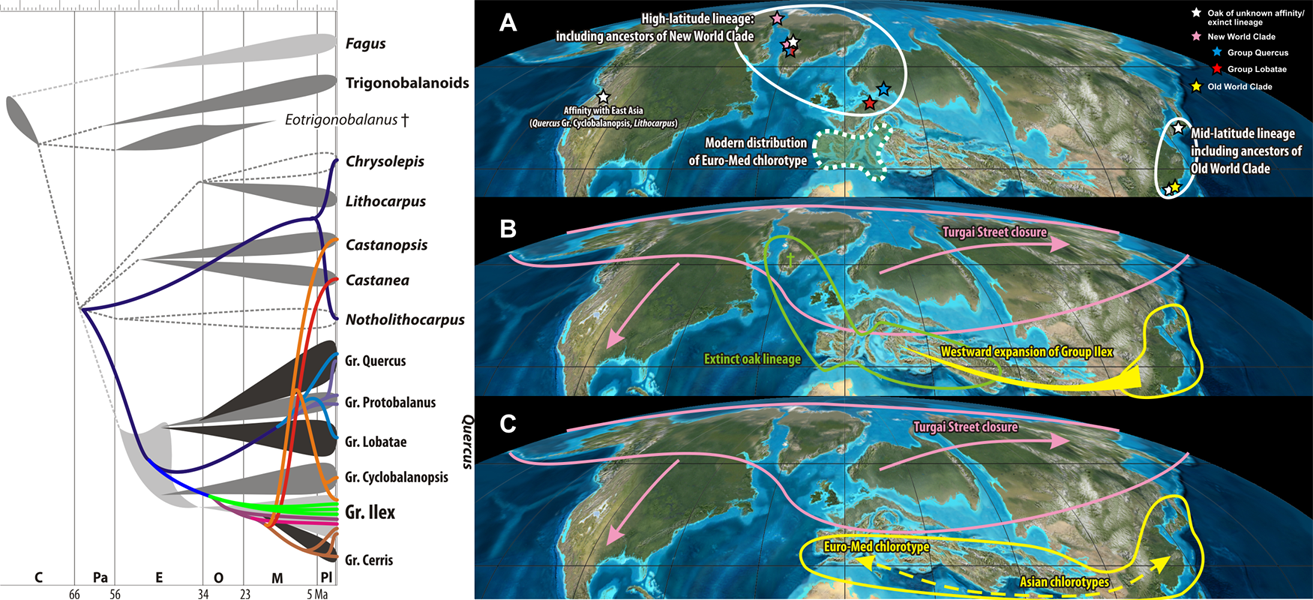 |
|
|
Bomfleur, Grimm GW, McLoughlin S. 2015. Osmunda pulchella sp. nov. from the Jurassic of
Sweden—reconciling molecular and fossil evidence in the phylogeny of modern royal ferns (Osmundaceae).
BMC Evolutionary Biology 15: 126.
— Open access —
— Electronic Supplementary Archive (ESA) including Files S1&S2, Figures S1–S3 and various data folders (genetic and morphological matrices, phylogenetic inference files) — [Preprint@bioRxiv] | 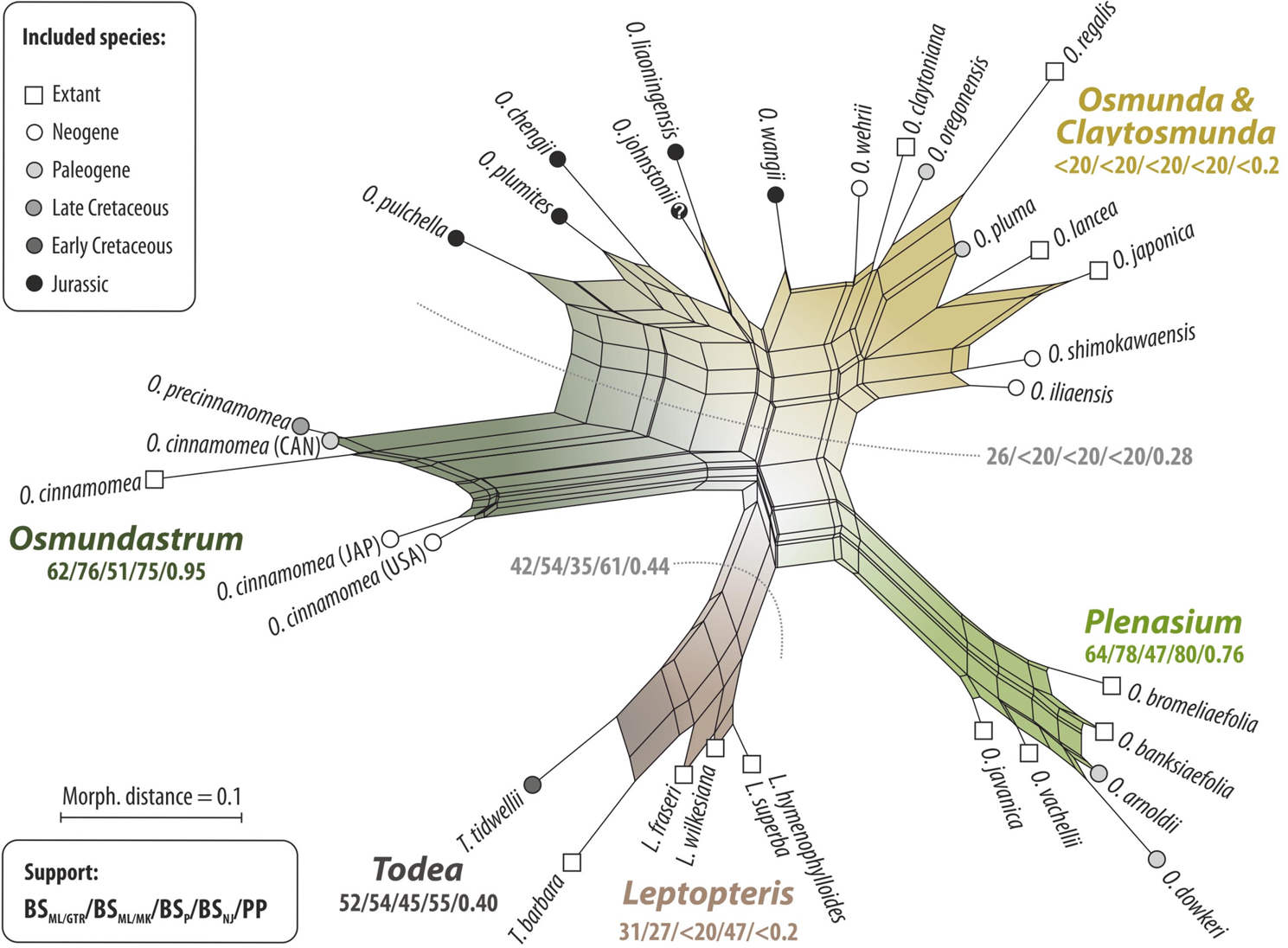 |
|
|
Chen LY, Grimm GW, Wang QF, Renner SS. 2015. A phylogeny and biogeographic analysis for the cape-pondweed
family Aponogetonaceae (Alismatales).
Molecular Phylogenetics & Evolution 82: 111–117.
— Electronic Supplementary Archive (ESA) including Files S1–S3, genetic matrices, and ML analysis folder. | 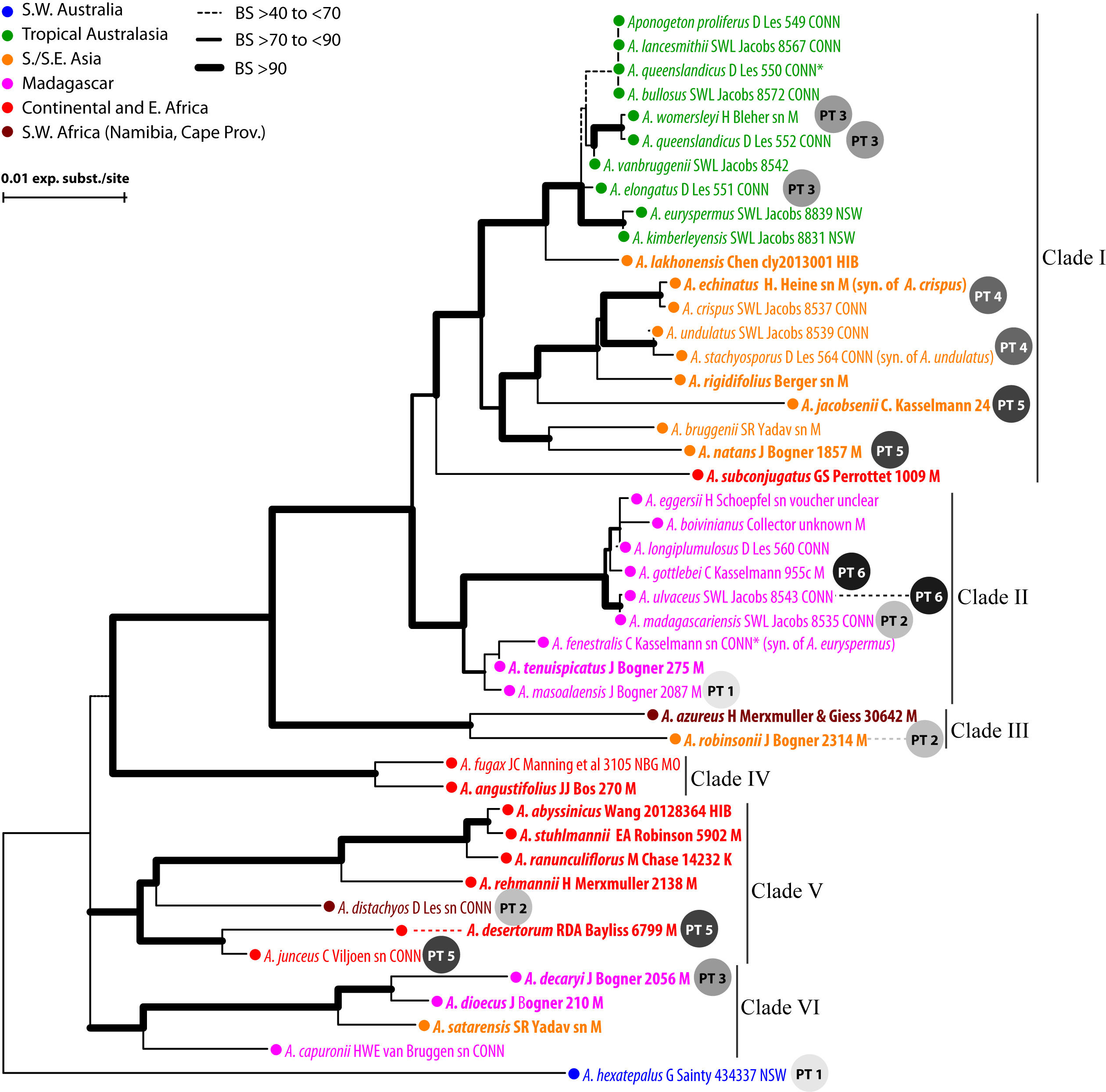 |
|
|
Friis EM, Grimm GW, Mendes MM, Pedersen KR. 2015. Canrightiopsis, a new Early Cretaceous
fossil with Clavatipollenites type pollen bridge the gap between extinct Canrightia and
extant Chloranthaceae.
Grana 54: 184–212.
— Open access —
— Archive including Electronic Supplement Files S1–S3 (genetic and morphological matrices used for trait mapping) and phylogenetic inference result files. | 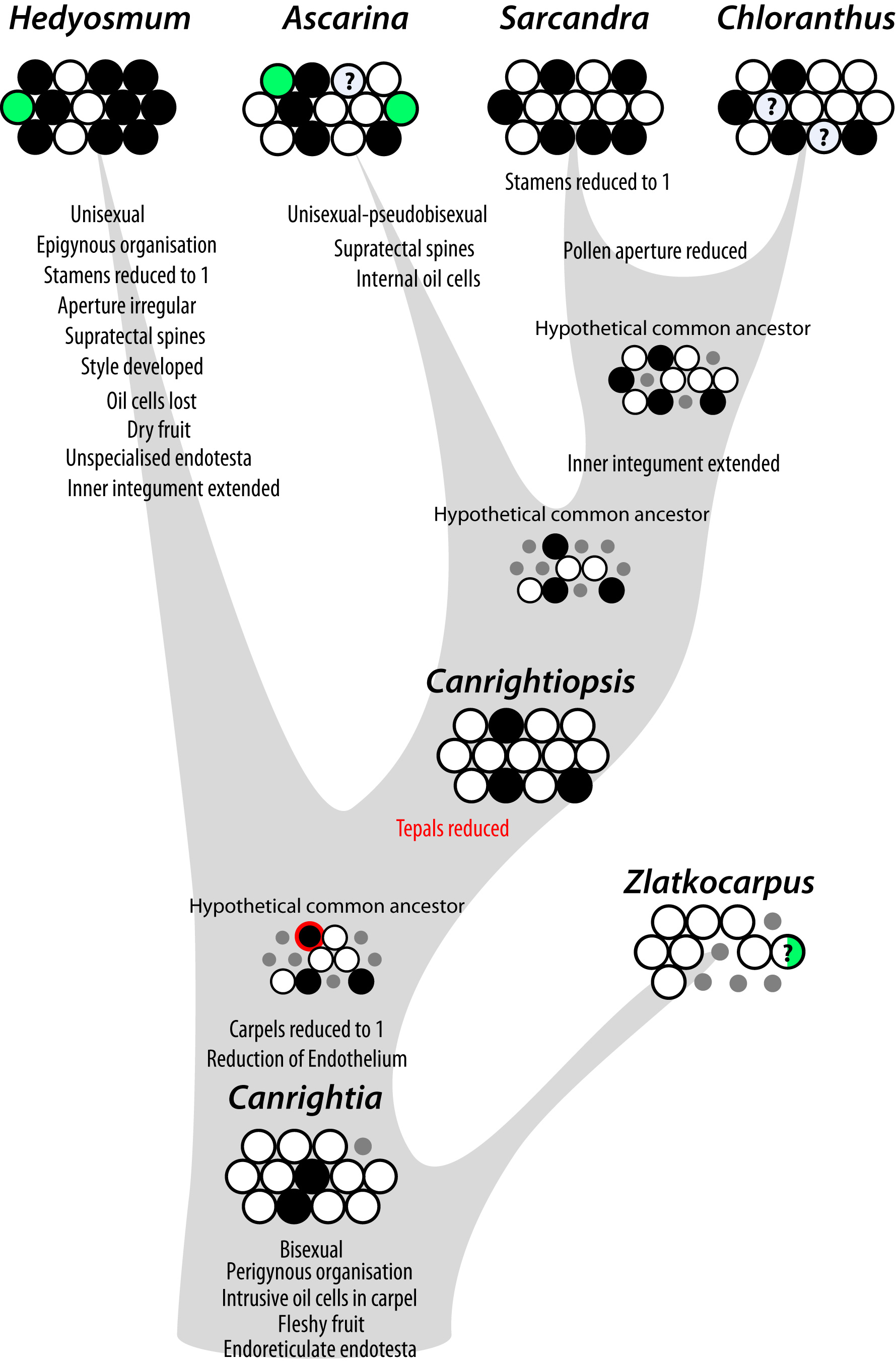 |
|
|
Grimm GW, Kapli P, Bomfleur B, McLoughlin S, Renner SS. 2015. Using more than the oldest fossils:
Dating Osmundaceae by three Bayesian clock approaches.
Systematic Biology 64: 396–405.
— Open access —
[PDF] [Data] [Preprint@bioRxiv] | 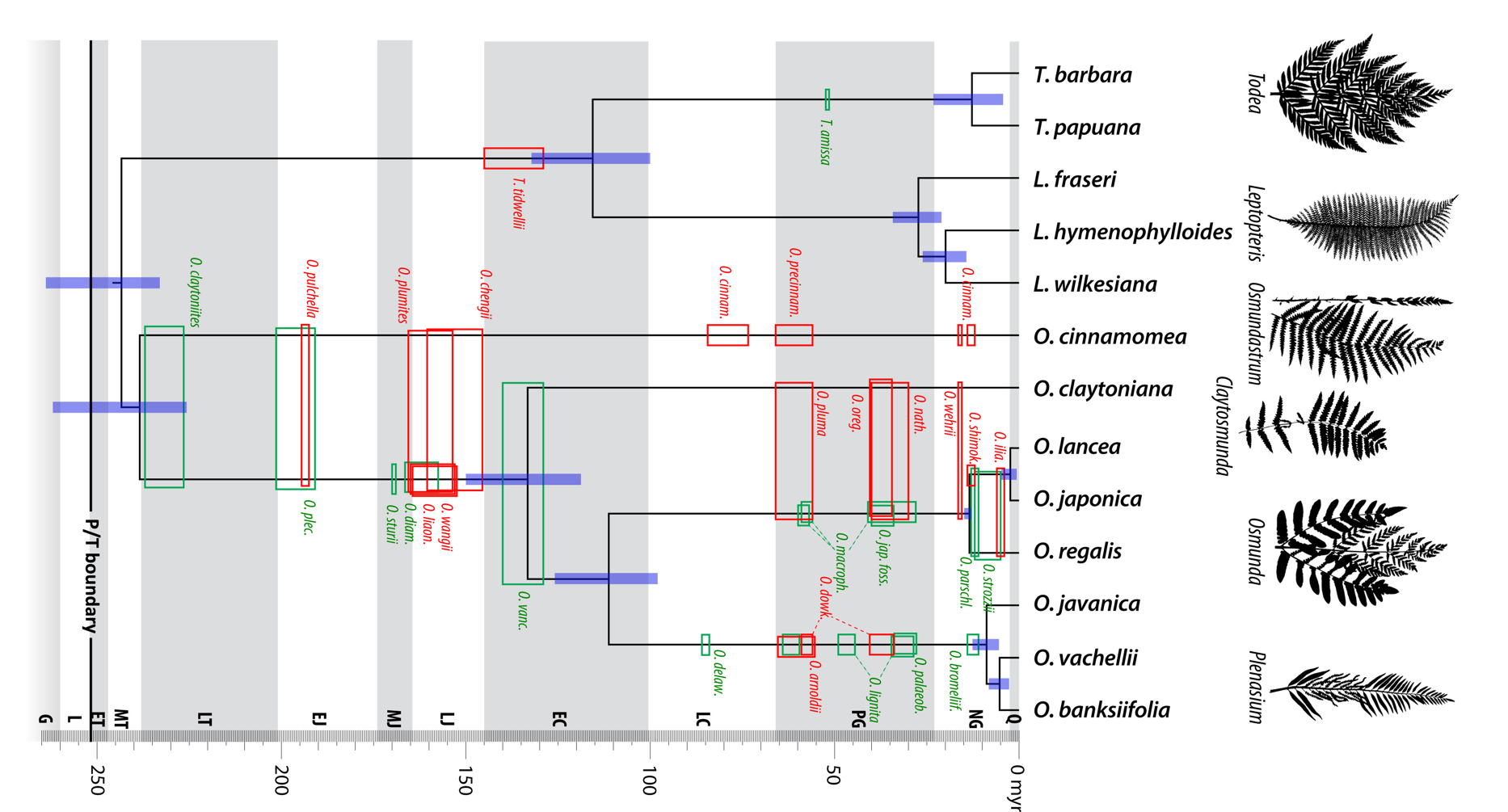 |
|
| Grímsson F, Zetter R, Grimm GW, Pedersen GK, Pedersen AK, Denk T. 2015. Fagaceae pollen from the early Cenozoic of West Greenland: revisiting Engler's and Chaney's Arcto-Tertiary hypotheses. Plant Systematics & Evolution 301: 809–832. — Open access — |  |
|
| Denk T, Güner HT, Grimm GW. 2014. From mesic to arid: Leaf epidermal features suggest preadaptation in Miocene dragon trees (Dracaena). Review of Palaeobotany & Palynology 200: 211–228. | 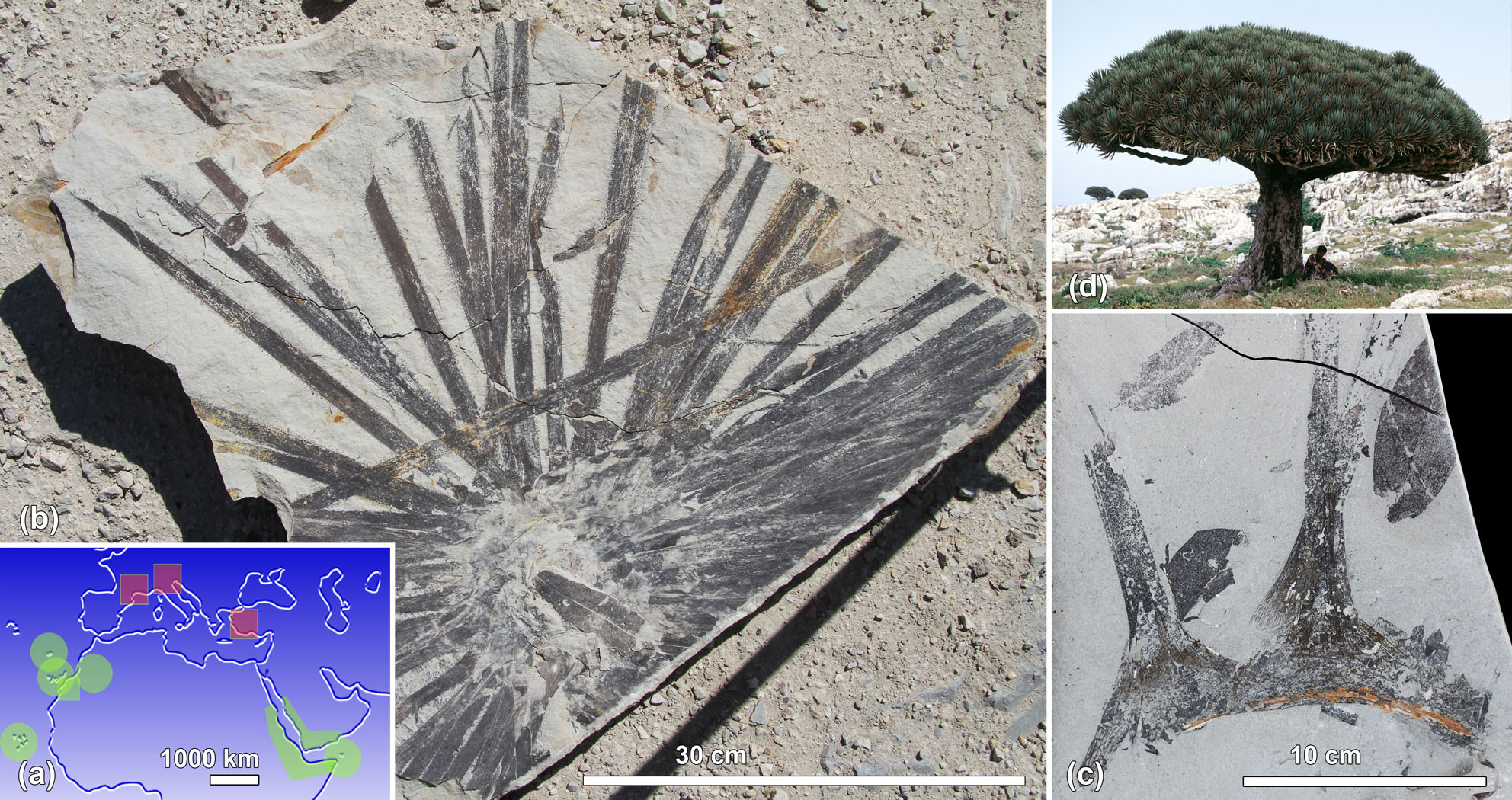 |
|
|
Grimm GW, Denk T. 2014. The Colchic region as refuge for relict tree lineages: cryptic
speciation in field maples.
Turkish Journal of Botany 38: 1050–1066. — Open access —
— Electronic Supplementary Archive (ESA) including Files S1&S2, Figures S1–S3 and data folder (ITS-based matrices, phylogenetic inference files) | 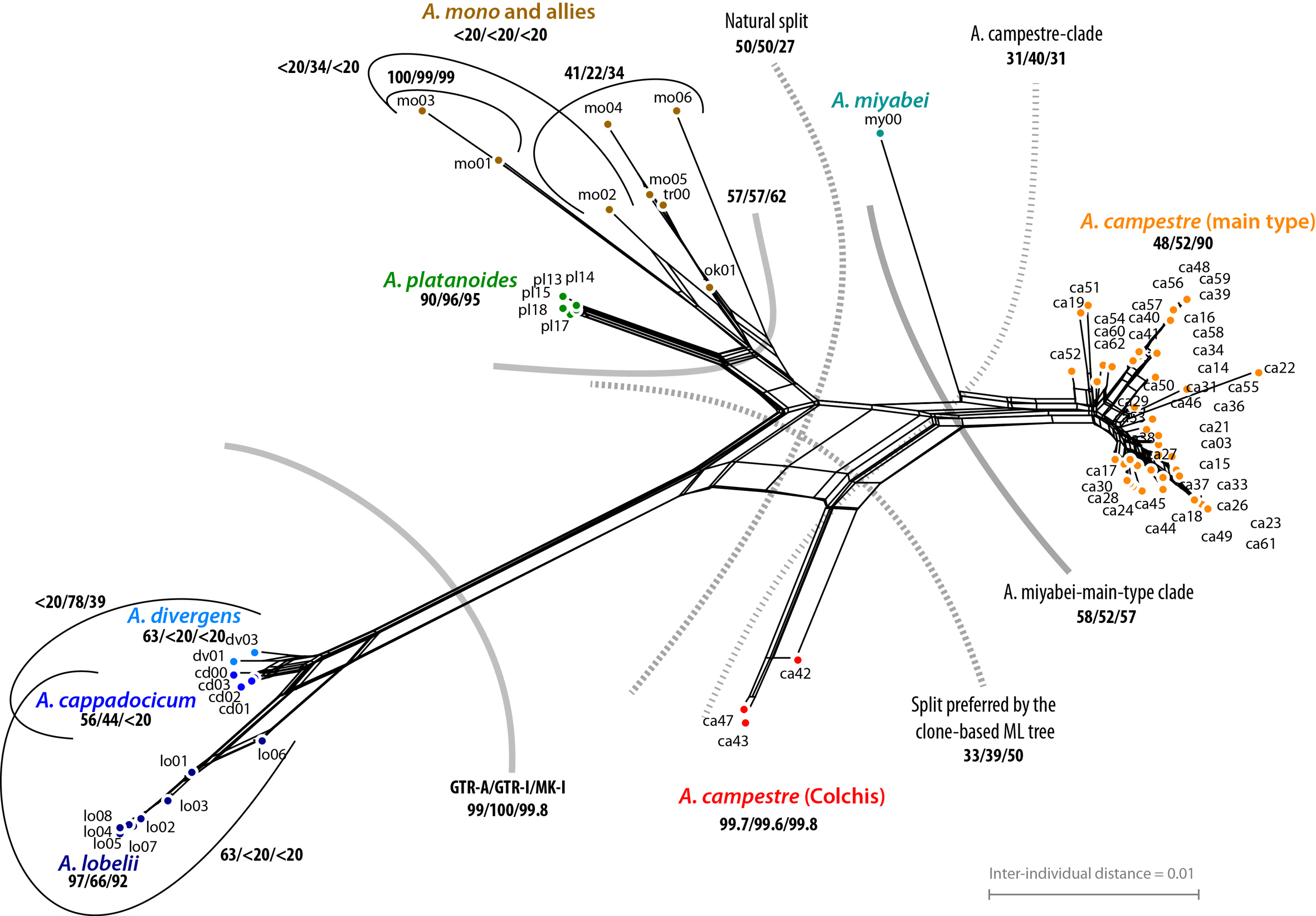 |
|
|
Grímsson F, Zetter R, Halbritter H, Grimm GW. 2014. Aponogeton pollen from the
Cretaceous and Paleogene of North America and West Greenland: implications for the origin and
palaeobiogeography of the genus.
Review of Palaeobotany & Palynology 200: 161–187.
— Open access —
— Archive including Supplementary Information (Fig. S1, Plates S1, S2), genetic and morphological matrices and inference result files. | 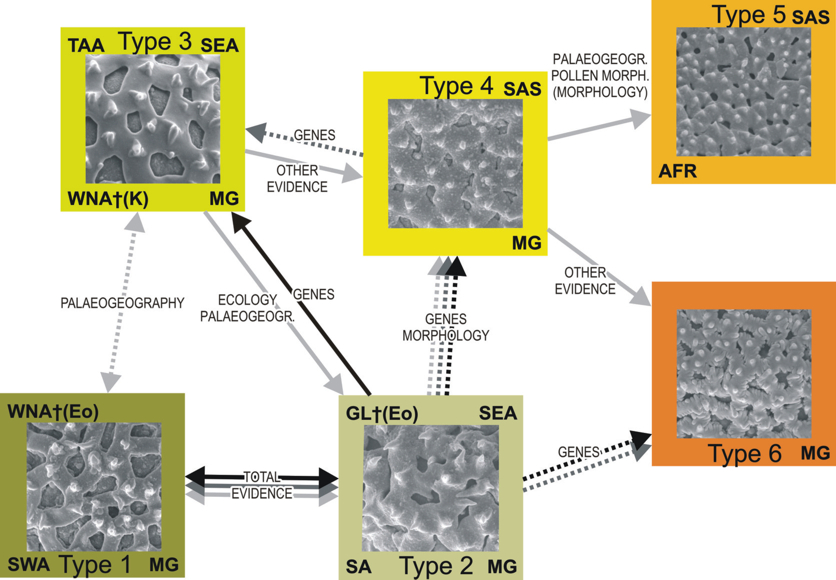 |
|
| Hubert F, Grimm GW, Jousselin E, Berry V, Franc A, Kremer A. 2014. Multiple nuclear genes stabilize the phylogenetic backbone of the genus Quercus. Systematics & Biodiversity 12: 405–423. | 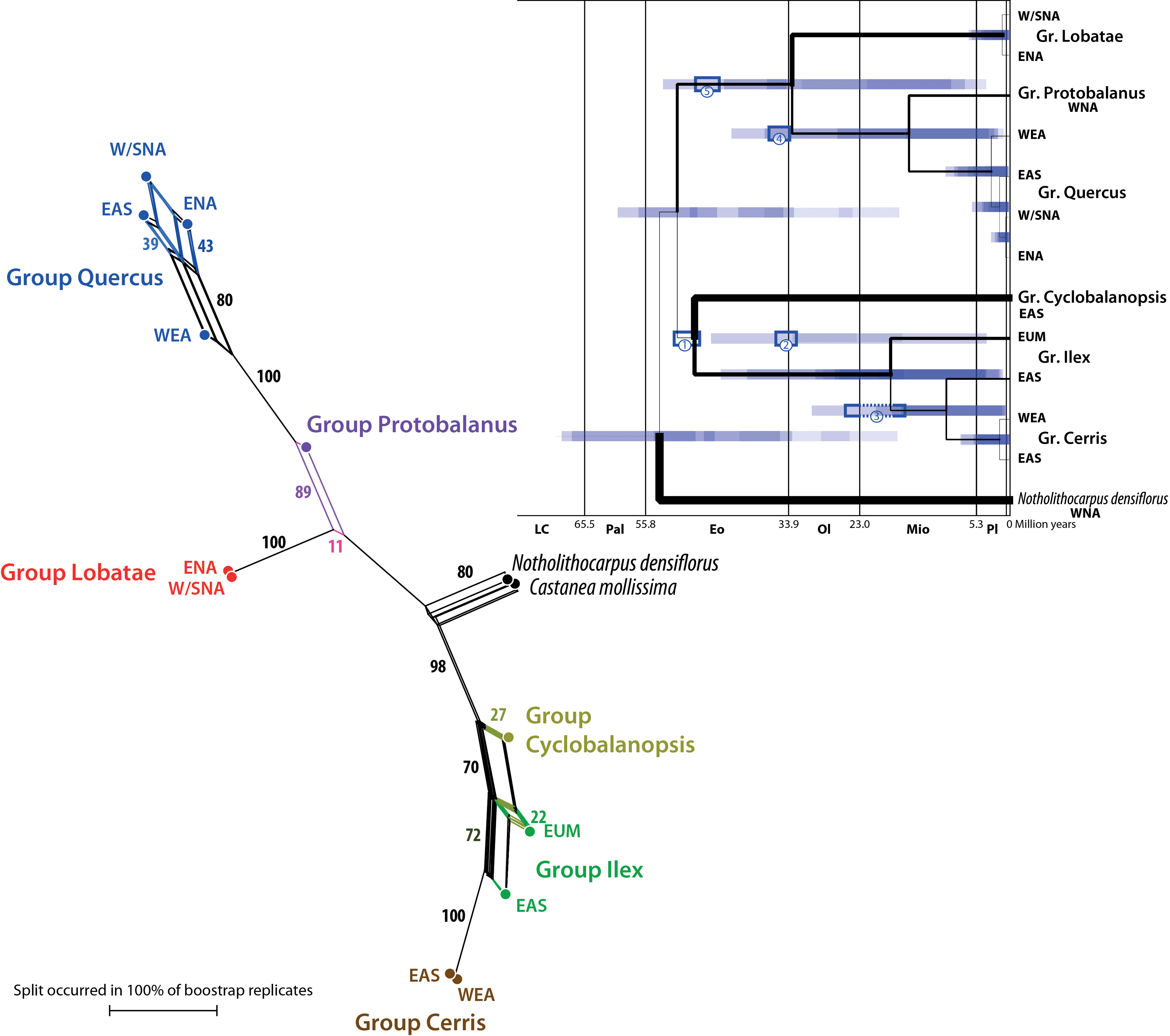 |
|
|
Mendes MM, Grimm GW, Pais J, Friis EM. 2014. Fossil Kajanthus lusitanicus gen. et sp . nov
from Portugal: Floral evidence for Early Cretaceous Lardizabalaceae (Ranunculales, basal eudicot).
Grana 53: 283–301.
— Open access —
— Archive including Electronic Supplement Files S1–S3, genetic and morphological matrices and phylogenetic inference result files. | 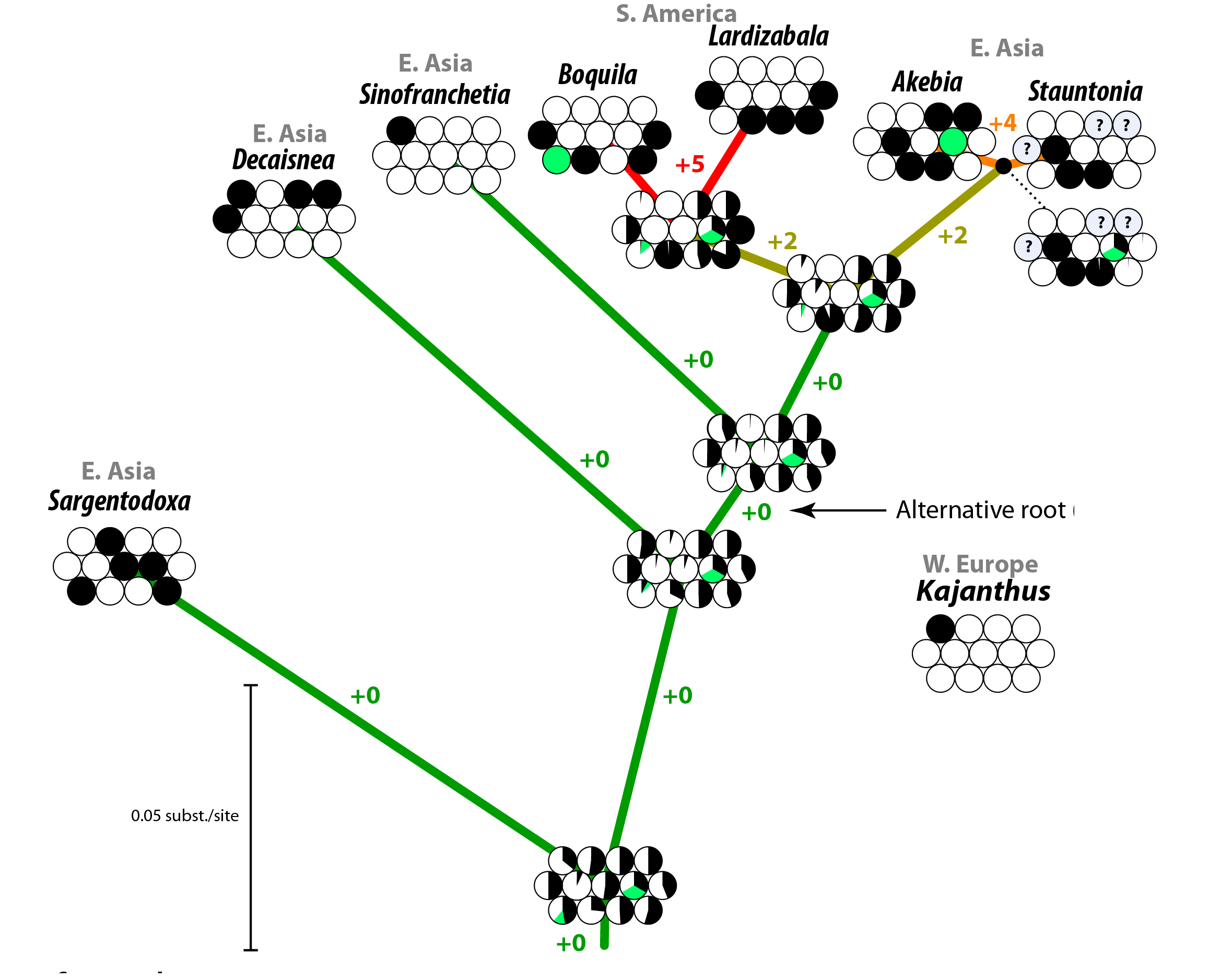 |
|
| Potts AJ, Hedderson TA,
Grimm GW. 2014. Constructing phylogenies in the presence of intra-individual site polymorphisms (2ISPs) with
a focus on the nuclear ribosomal cistron.
Systematic Biology 63: 1–16.
[Abstract] [PDF] [Data] | 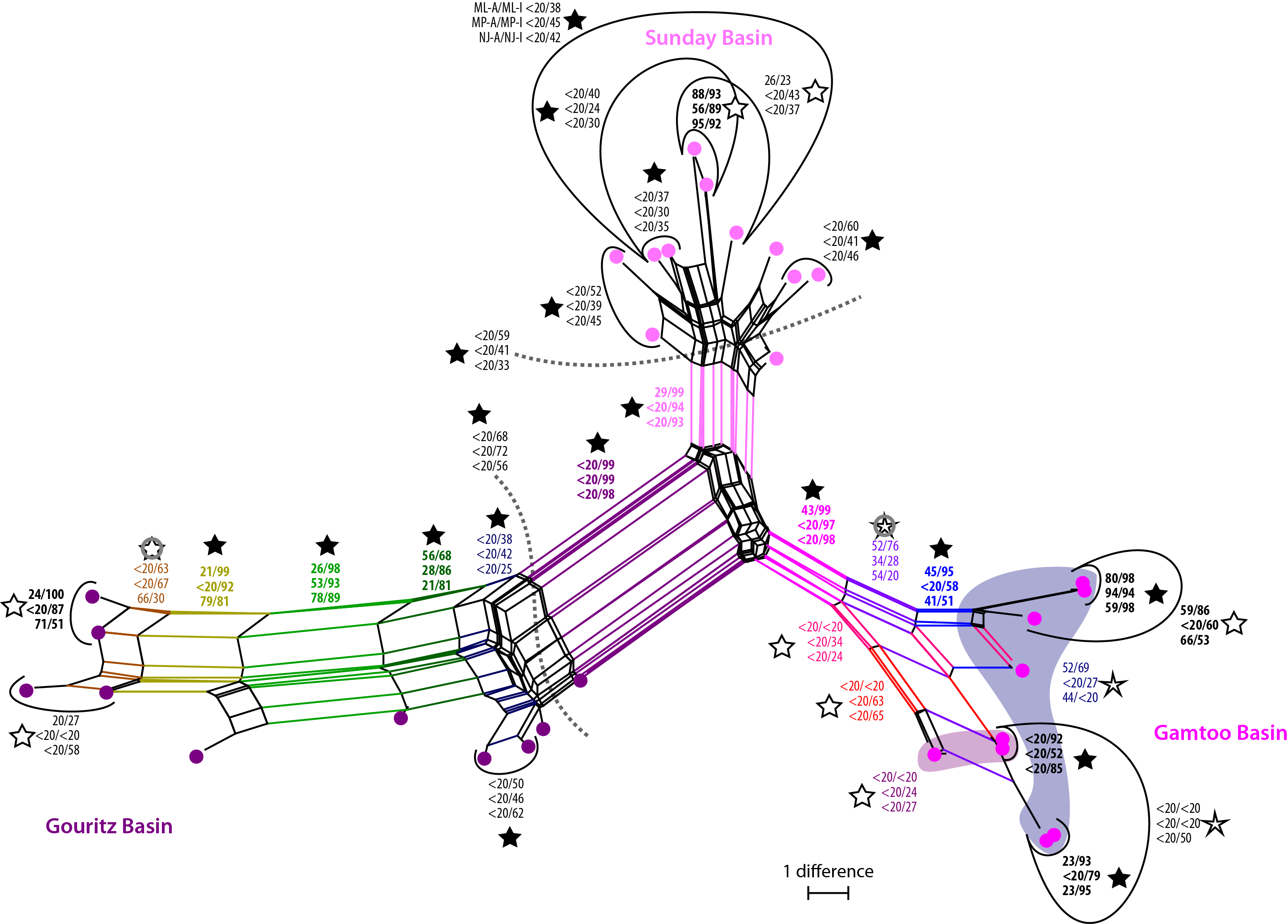 |
|
| Surveswaran S, Sun M,
Grimm GW, Liede-Schumann, S. 2014. On the systematic position of some Asian enigmatic genera of Asclepiadoideae
(Apocynaceae).
Botanical Journal of the Linnean Society 174: 601–619.
— ESA (Electronic Supplementary Archive) including genetic matrices RAxML, GARLI, MrBayes input and output files. |  |
|
| Wanntorp L, Grudinski M, Forster PI,
Muellner-Riehl AN, Grimm GW. 2014. Reconstructing complex evolutionary and biogeographic patterns in the
wax plants Hoya, Apocynaceae).
Taxon 63: 89–102.
— Archiv including electronic supplement files (ES1–ES3) and inference result files (data matrix not included). — Median networks and genera post @ Genealogical World of Phylogenetic Networks — Graphs that got lost during review @ Res.I.P. |  |
|
| Weiner AKM, Weinkauf MFG, Kurasawa A, Darling KF, Kučera M, Grimm GW. 2014. Phylogeography of the tropical planktonic foraminifera lineage Globigerinella reveals isolation inconsistent with passive dispersal by ocean currents. PLoS ONE 9: e92148. — Open access — | 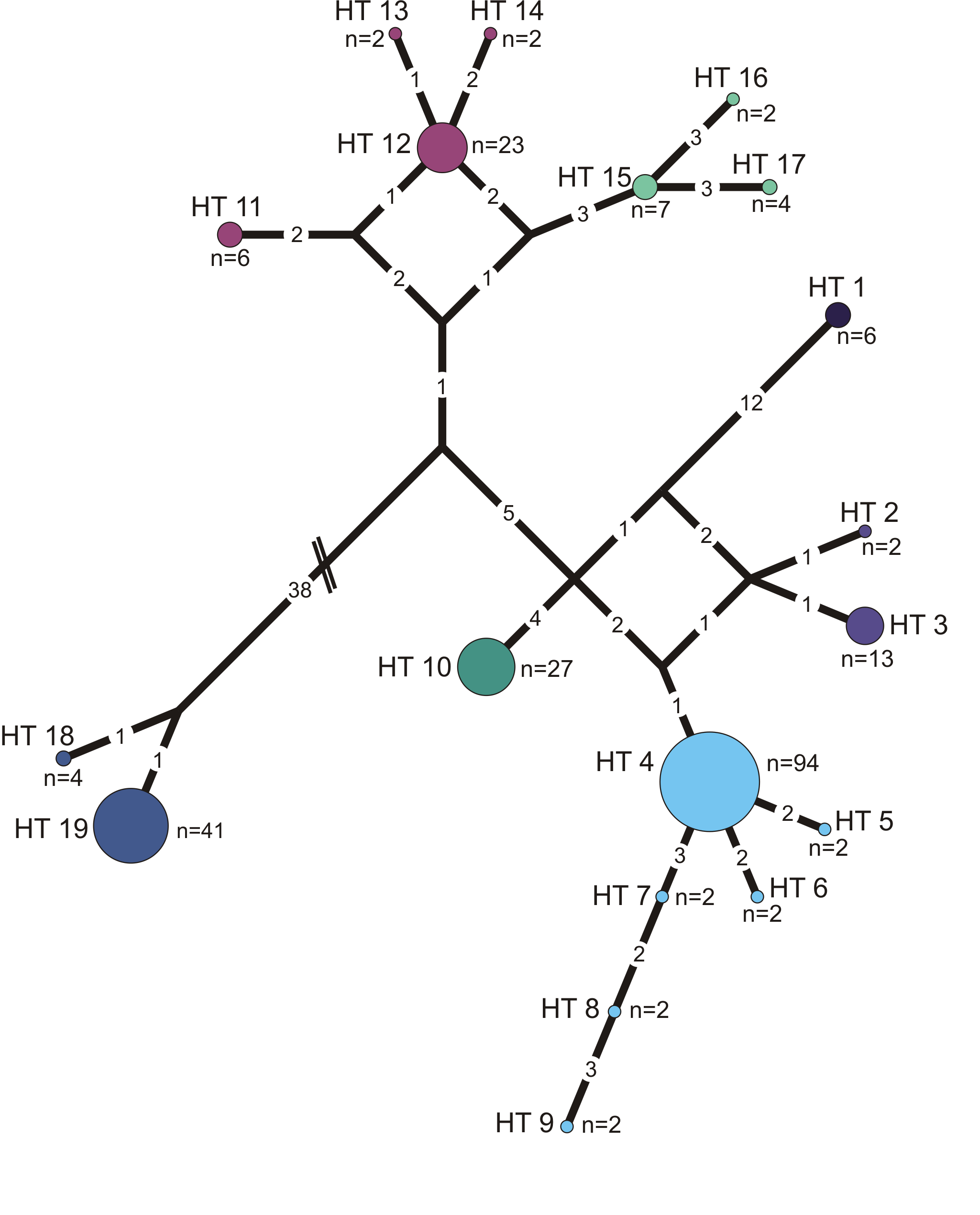 |
|
|
Denk T, Grimm GW, Grímsson F, Zetter R. 2013. Evidence from "Köppen signatures" of fossil plant
assemblages for effective heat transport of Gulf Stream to subarctic North Atlantic during Miocene cooling.
Biogeosciences 10: 7927–7942. — Open access —
— Supplement including ClimGrim v.0.2 database (mirrored on the journal's homepage) |  |
|
| Grimm GW, Renner SS. 2013.
Harvesting GenBank for Betulaceae sequences to generate a new chronogram for the family.
Botanical Journal of the Linnean Society 172: 465–477.[Pre-print
PDF]
— OSA (Online Supporting Archive) including matrices and inference result files — Archive including the Supporting Information (SI) files | 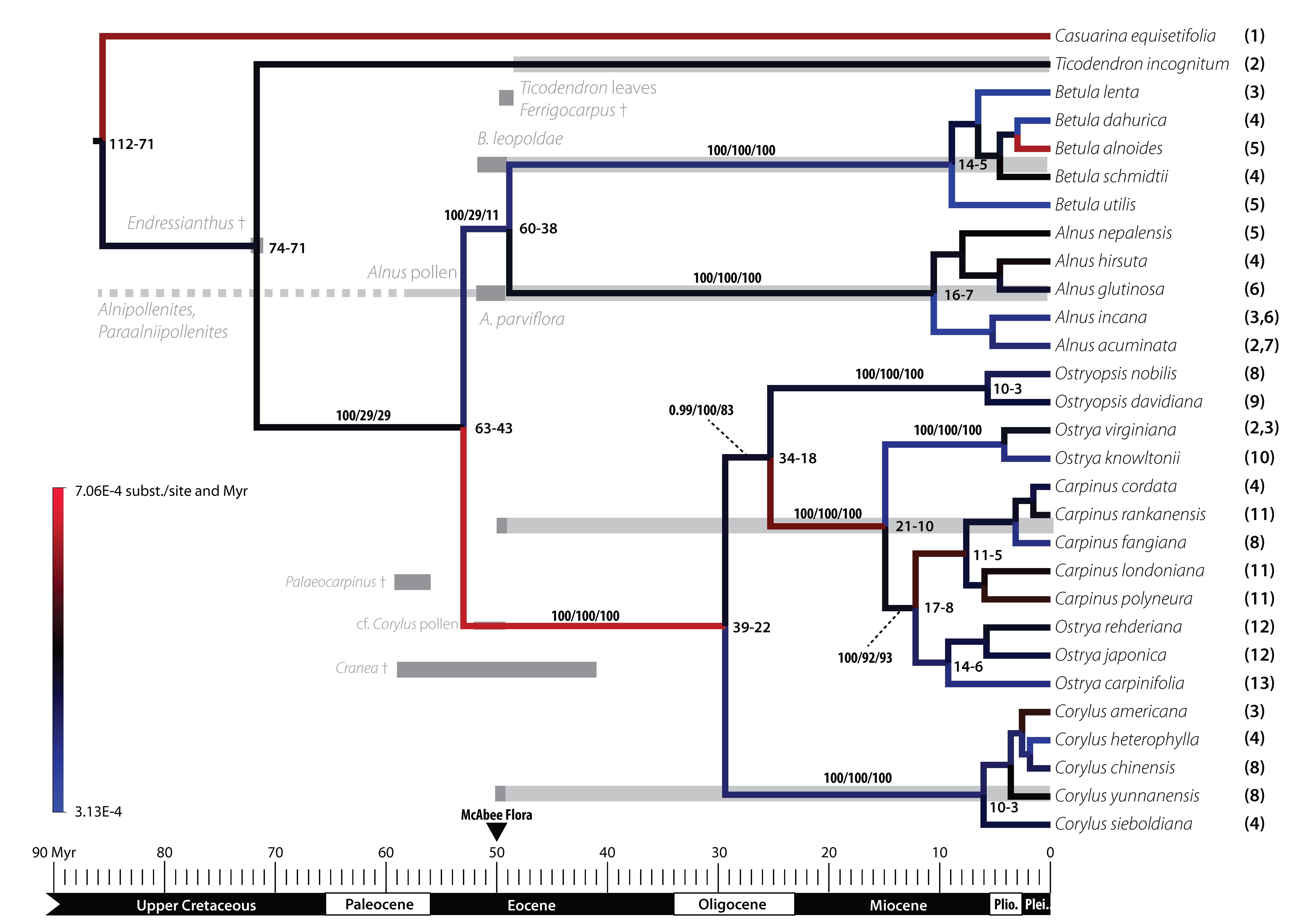 |
|
| Denk T, Grimm GW, Röseler A-K. 2012. When field botany meets history: taxonomy of Platanus mexicana in Mexico. Willdenowia 42: 99–115. — Open access — | 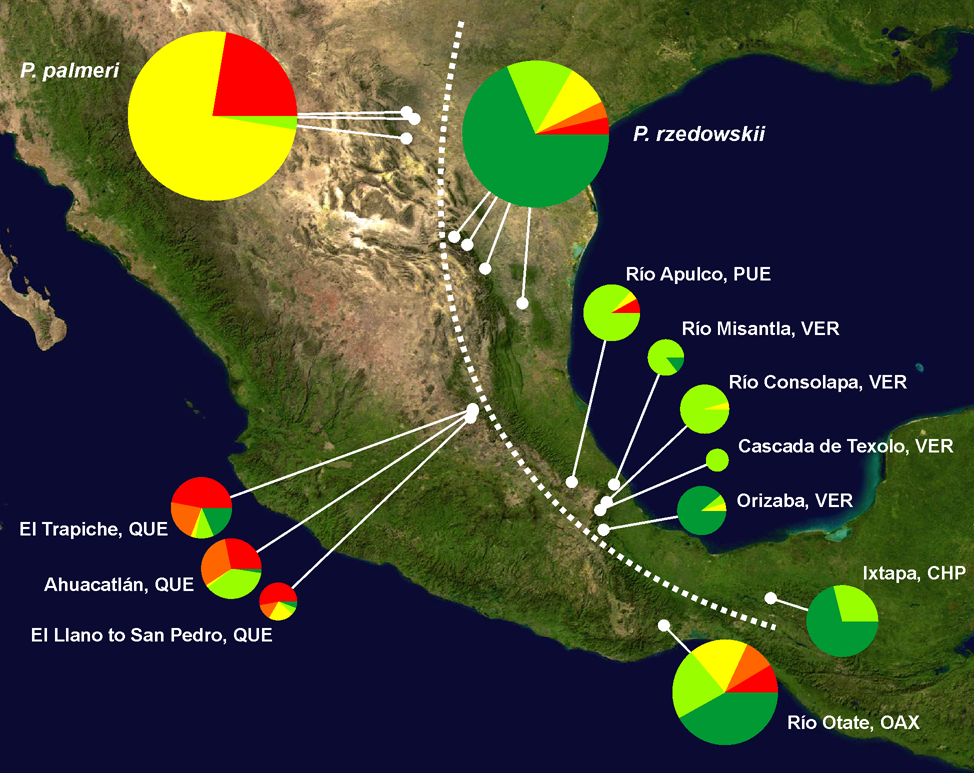 |
|
|
Grimm GW, Denk T. 2012. Reliability and resolution of the coexistence approach - a revalidation
using modern-day data.
Review of Palaeobotany & Palynology 172: 33–47.
— Comprehensive Electronic supplement including GIS files [8 MB] — Without GIS files, only including spread sheets ES1–9 and GoogleEarth location file [3 MB] This paper has been harshly attacked by one of the original reviewers, and in Hoorn et al. (2012). Find the details here. | 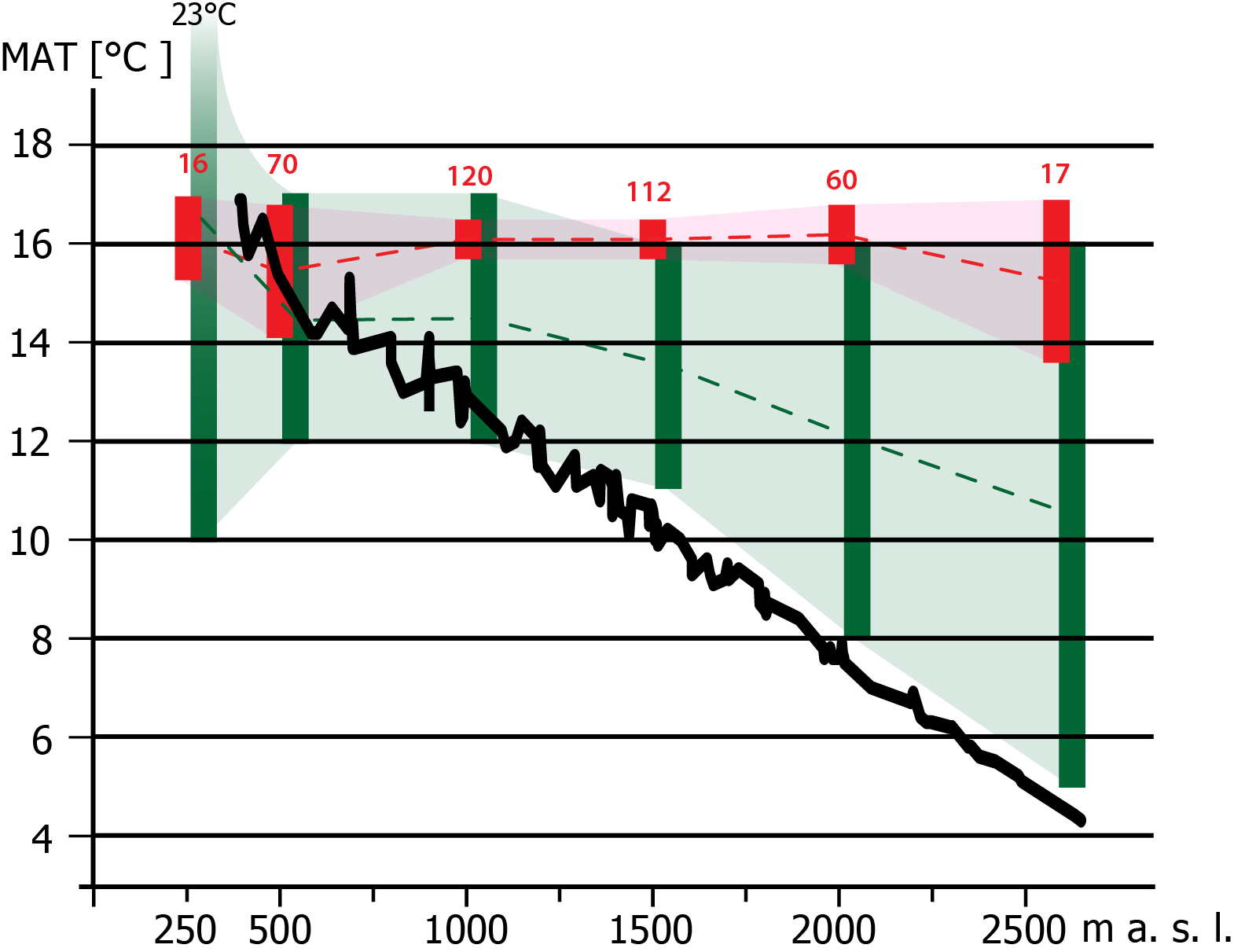 |
|
|
Schlee M, Göker M, Grimm GW, Hemleben V. 2011. Genetic patterns in the Lathyrus pannonicus
complex (Fabaceae) reflect ecological differentiation rather than biogeography and traditional subspecific
division.
Botanical Journal of the Linnean Society 165: 402–421.
— Comprehensive data (ITS matrix, relevé data, etc.) is included in the electronic supplement on the journal's homepage. | 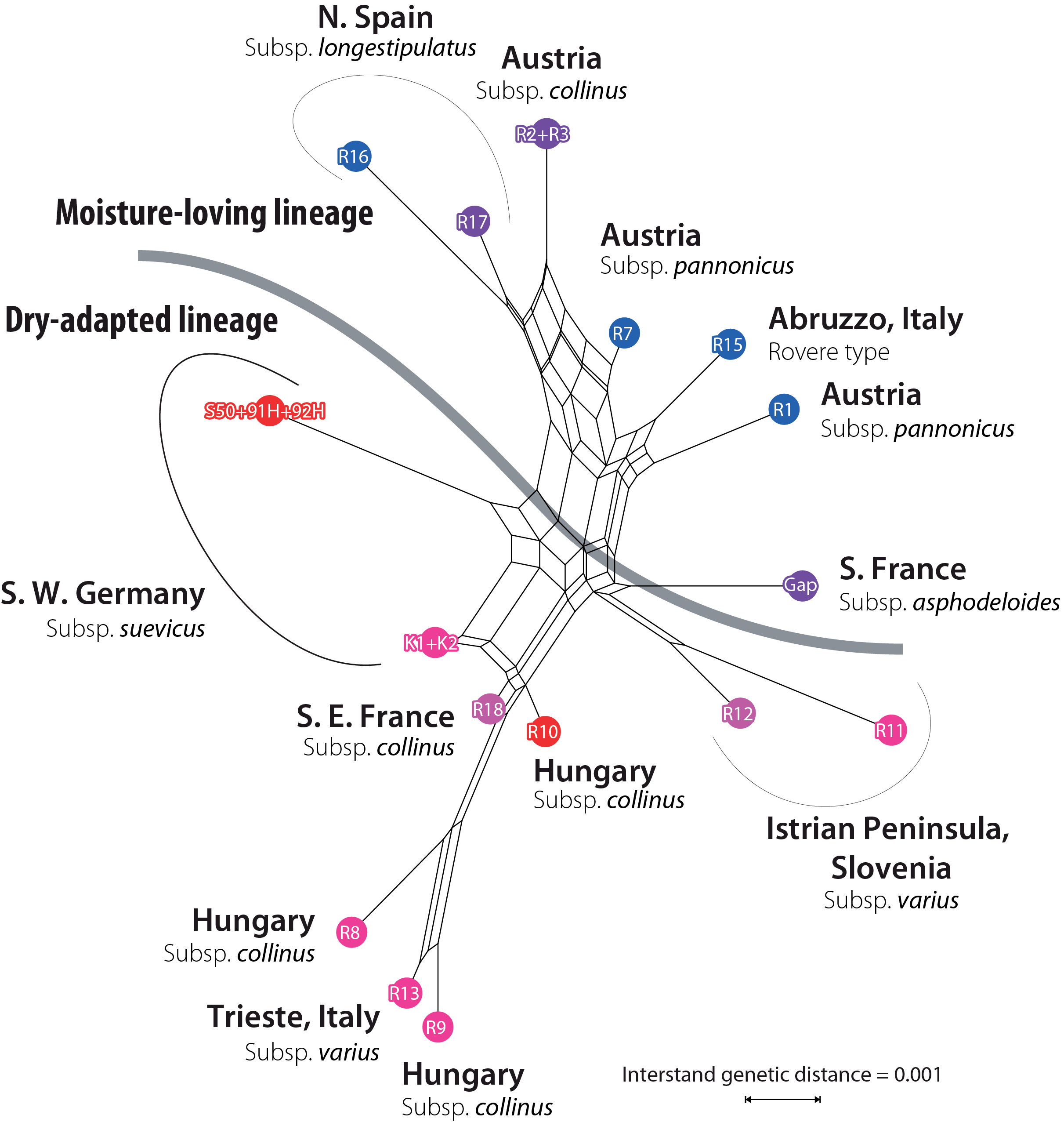 |
|
| Denk T, Grimm GW. 2010.
The oaks of western Eurasia: Traditional classifications and evidence from two nuclear markers.
Taxon 59: 351–366.
— Get data, networks and trees. | 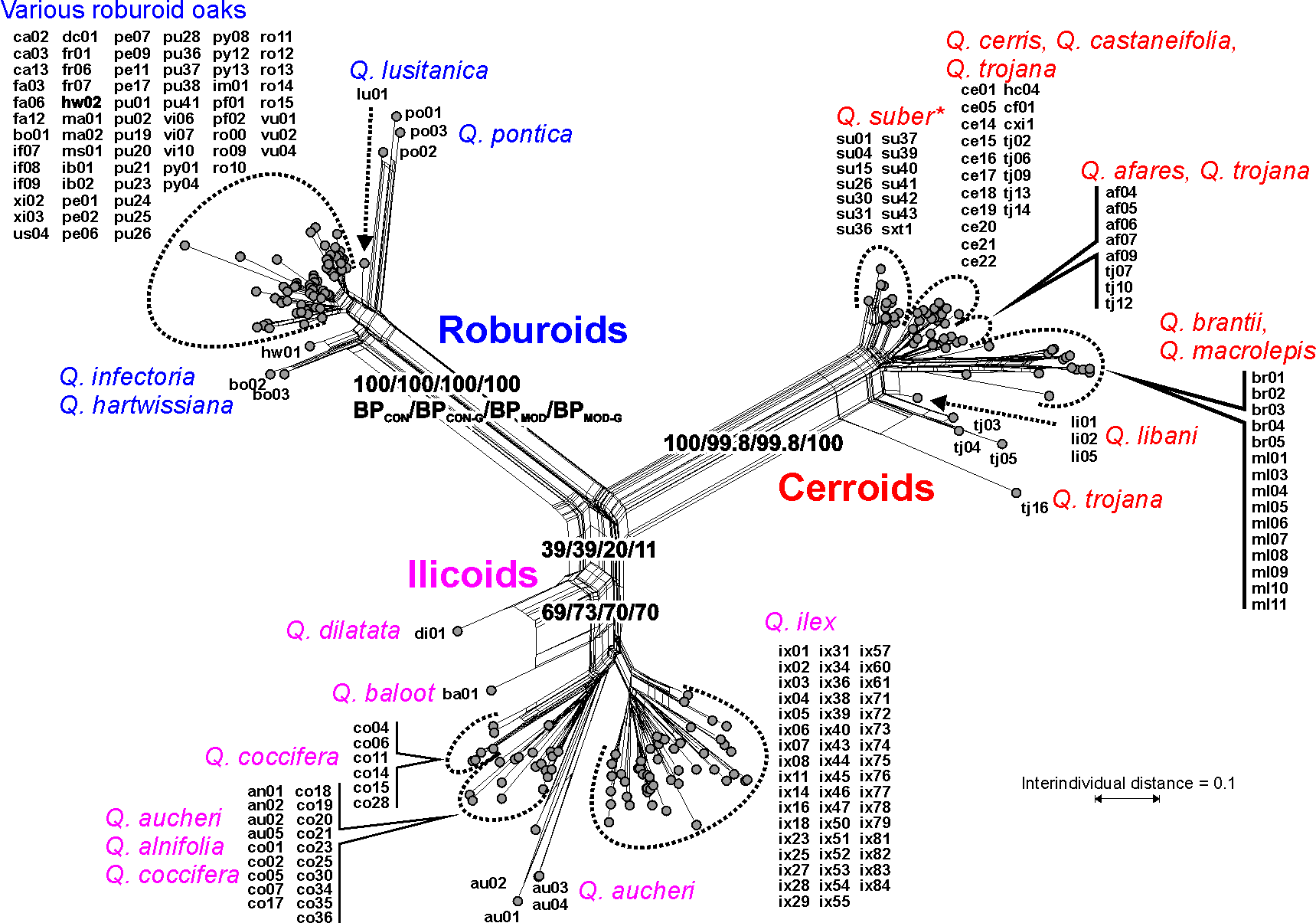 |
|
| Göker M, Grimm GW, Auch AF, Aurahs R, Kučera M. 2010. A clustering optimization strategy for molecular taxonomy and its application to planktonic foraminifera SSU rDNA. Evolutionary Bioinformatics 6: 97–112. — Open access — | 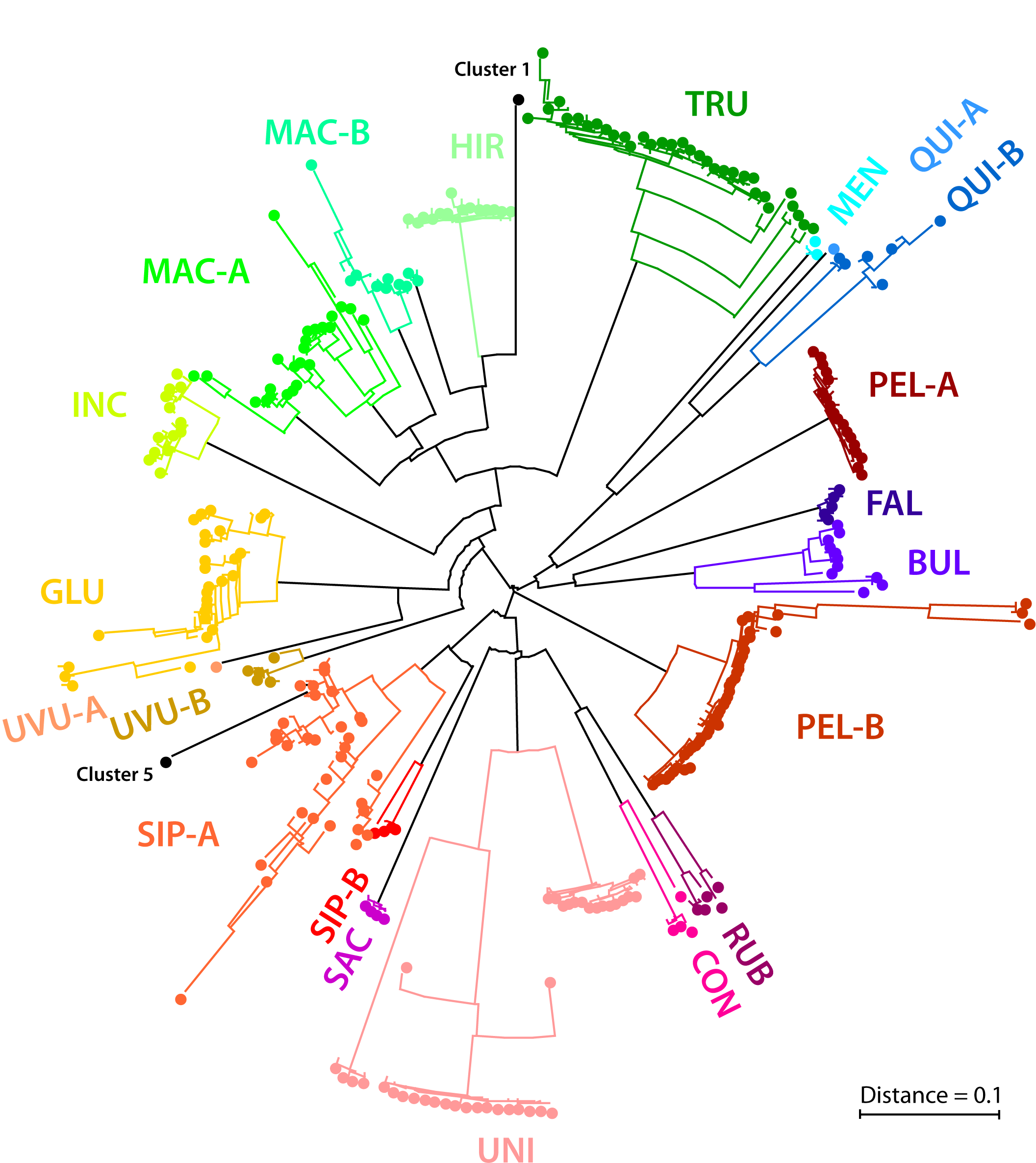 |
|
|
Grimm GW, Denk T. 2010. The reticulate origin of modern plane trees
(Platanus, Platanaceae) - a nuclear marker puzzle.
Taxon 59: 134–147.
— Here's the data (and more). | 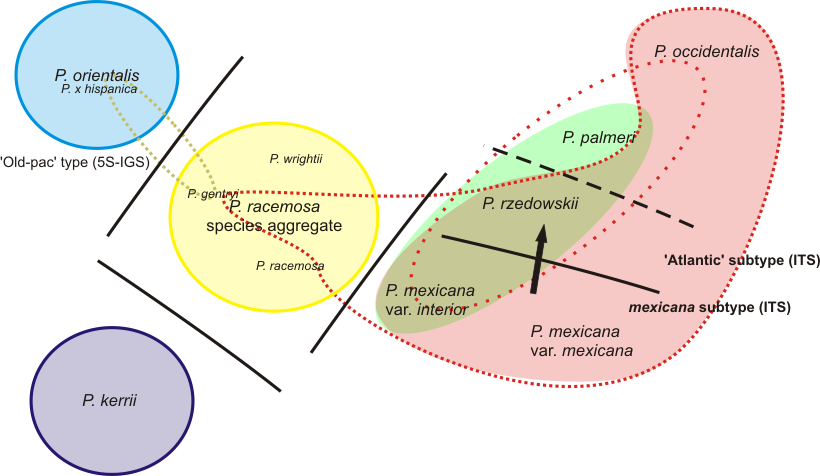 |
|
| Schlee M, Göker M, Grimm GW, Hemleben V. 2010. Relicts within the genus complex
Astragalus/ Oxytropis (Fabaceae), and the comparison of diversity by objective means.
In: JC Habel &
T Assmann (eds): Relict Species. Springer, Heidelberg, New York,p. 105–118.
— Take a look at the poster presented in Leipzig. | 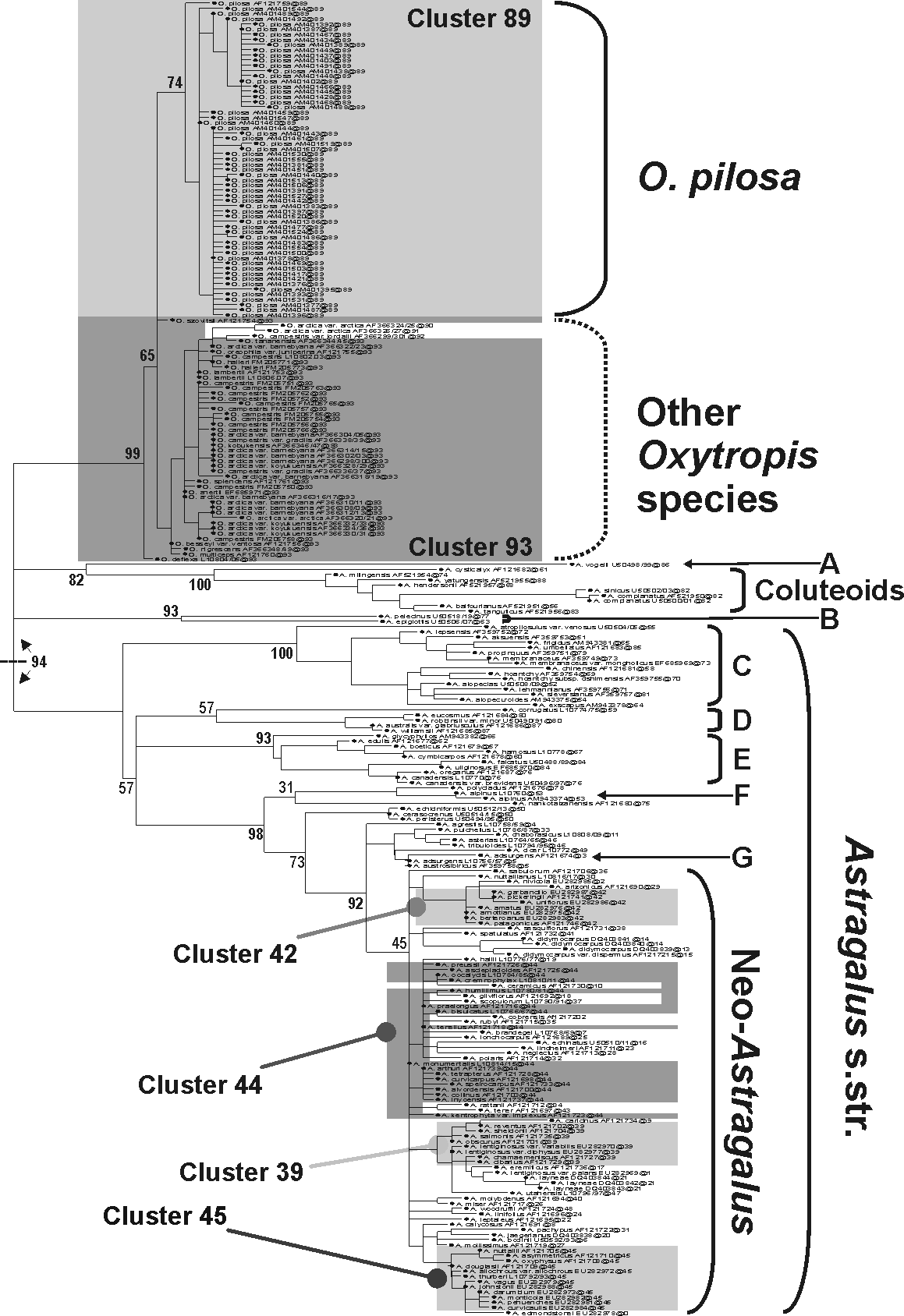 |
|
| Stamatakis A, Göker M,
Grimm GW. 2010. Maximum likelihood analysis of 3,490 rbcL sequences: Scalability of comprehensive
inference versus group-specific taxon sampling.
Evolutionary Bioinformatics 6: 73–90. — Open access —
— nexus- and phylip -formatted alignments can be found here. | 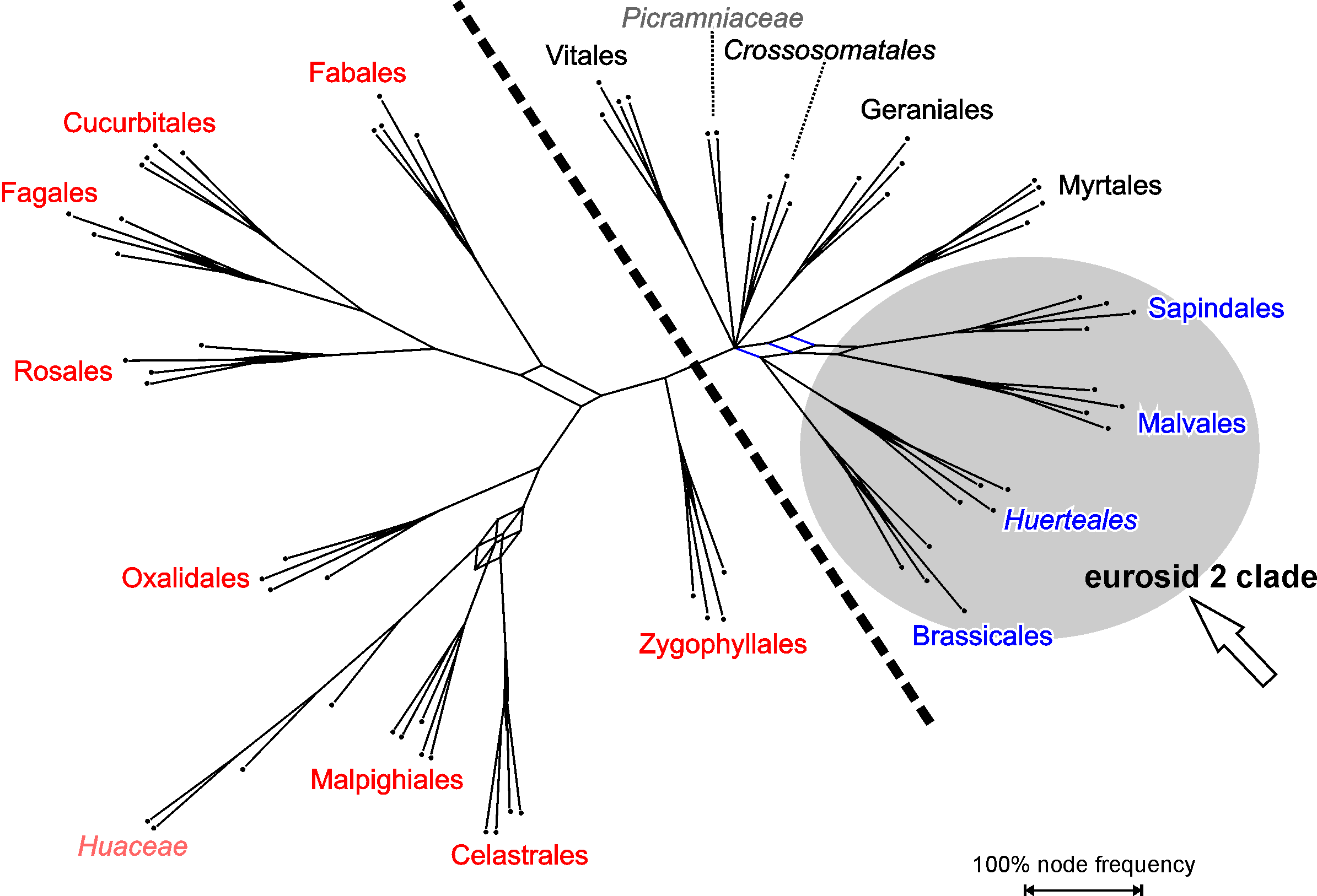 |
|
| Aurahs R, Göker M, Grimm GW, Hemleben V, Hemleben C, Schiebel R, Kučera M. 2009. Using the multiple analysis approach to reconstruct phylogenetic relationships among planktonic Foraminifera from highly divergent and length-polymorphic SSU rDNA sequences. Bioinformatics & Biology Insights 3: 155–177. — Open access — | 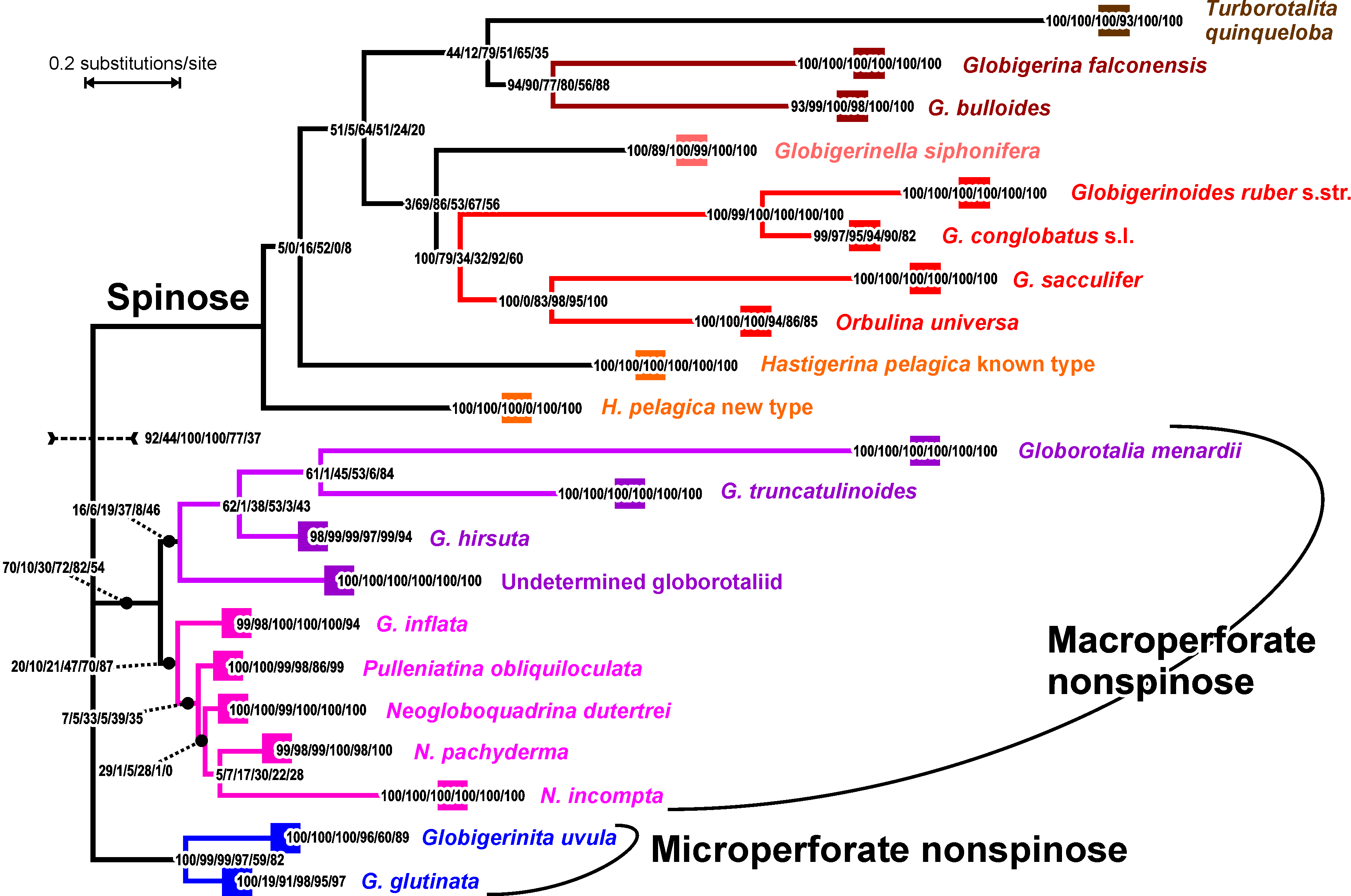 |
|
| Aurahs R, Grimm GW, Hemleben V, Hemleben C, Kučera M.. 2009. Geographical distribution patterns of cryptic genetic types in the planktonic foraminifer Globigerinoides ruber. Molecular Ecology 18: 1692–1706. | 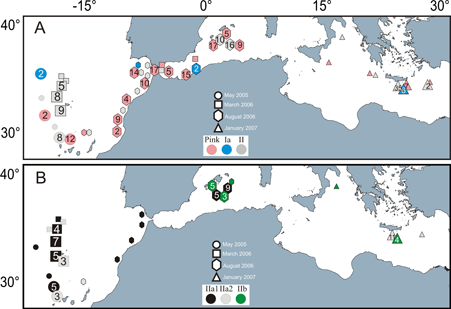 |
|
| Denk T, Grimm GW. 2009. Significance of pollen characteristics for infrageneric classification and phylogeny in Quercus (Fagaceae). International Journal of Plant Science 170: 926–940. | 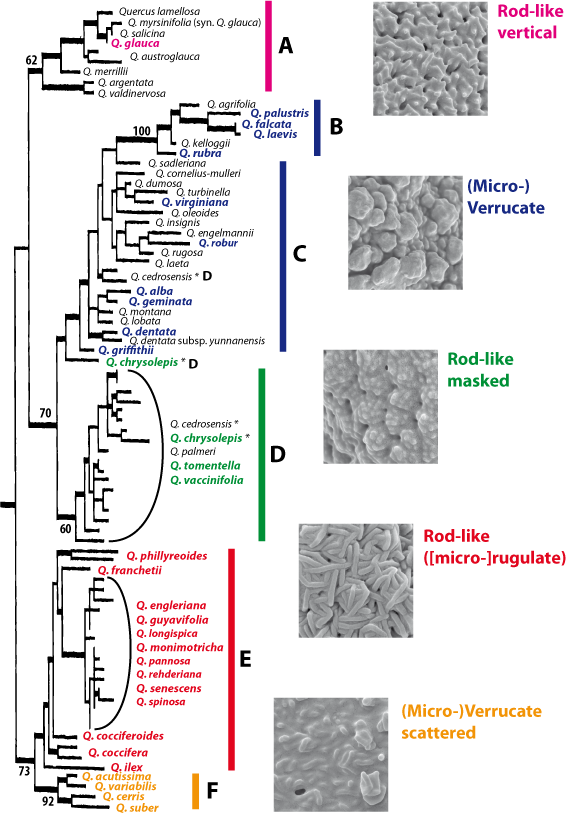 |
|
| Denk T,
Grimm GW. 2009. The biogeographic history of beech trees.
Review of Palaeobotany & Palynology 158: 83–100.
— Get the data. Use it wisely! — Related post @ Res.I.P. The challenging and puzzling ordinary beech – a (hi)story |  |
|
| Friis EM, Pedersen KR, von Balthazar M, Grimm GW, Crane PR. 2009. Monetianthus mirus gen. and sp. nov., a nymphaealean flower from the early Cretaceous of Portugal. International Journal of Plant Sciences 170: 1086–1101. | 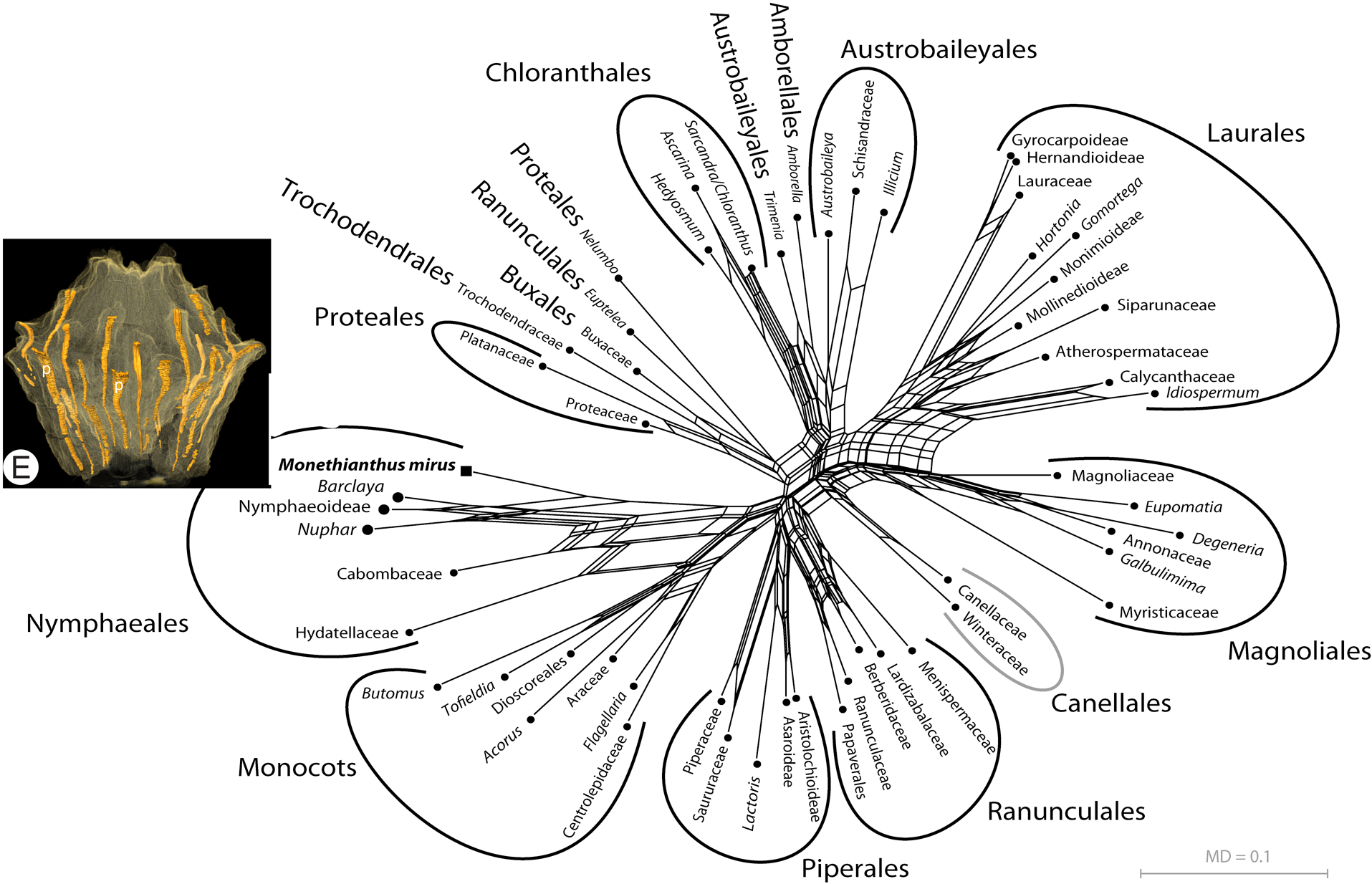 |
|
| Tsuchiya M, Grimm GW, Heinz P, Stögerer K, Ertan KT, Collen J, Brüchert V, Hemleben C, Hemleben V, Kitazato H. 2009. Ribosomal DNA shows extremely low genetic divergence in a world-wide distributed, but disjunct and highly adapted marine protozoan (Virgulinella fragilis, Foraminiferida. Marine Micropaleontology 70: 8–19. | 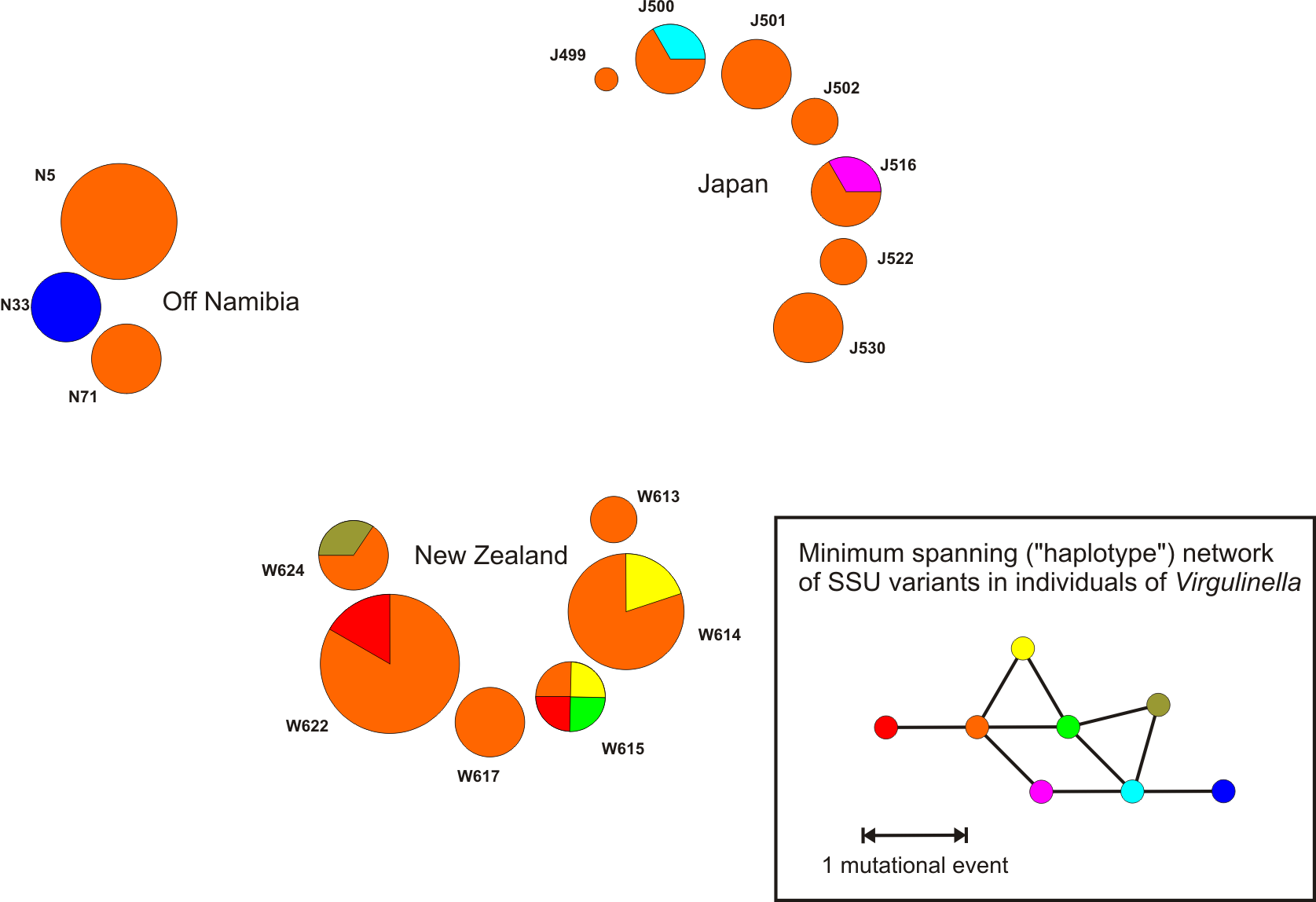 |
| Göker M, Grimm GW. 2008. General functions to transform associate data to host data, and their use in phylogenetic inference from sequences with intra-individual variability. BMC Evolutionary Biology 8: 86. — Open access — | 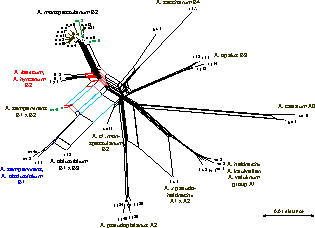 |
| Grimm GW, Denk T. 2008. ITS evolution in Platanus: homoeologues, pseudogenes, and ancient hybridisation. Annals of Botany 101: 403–419. | 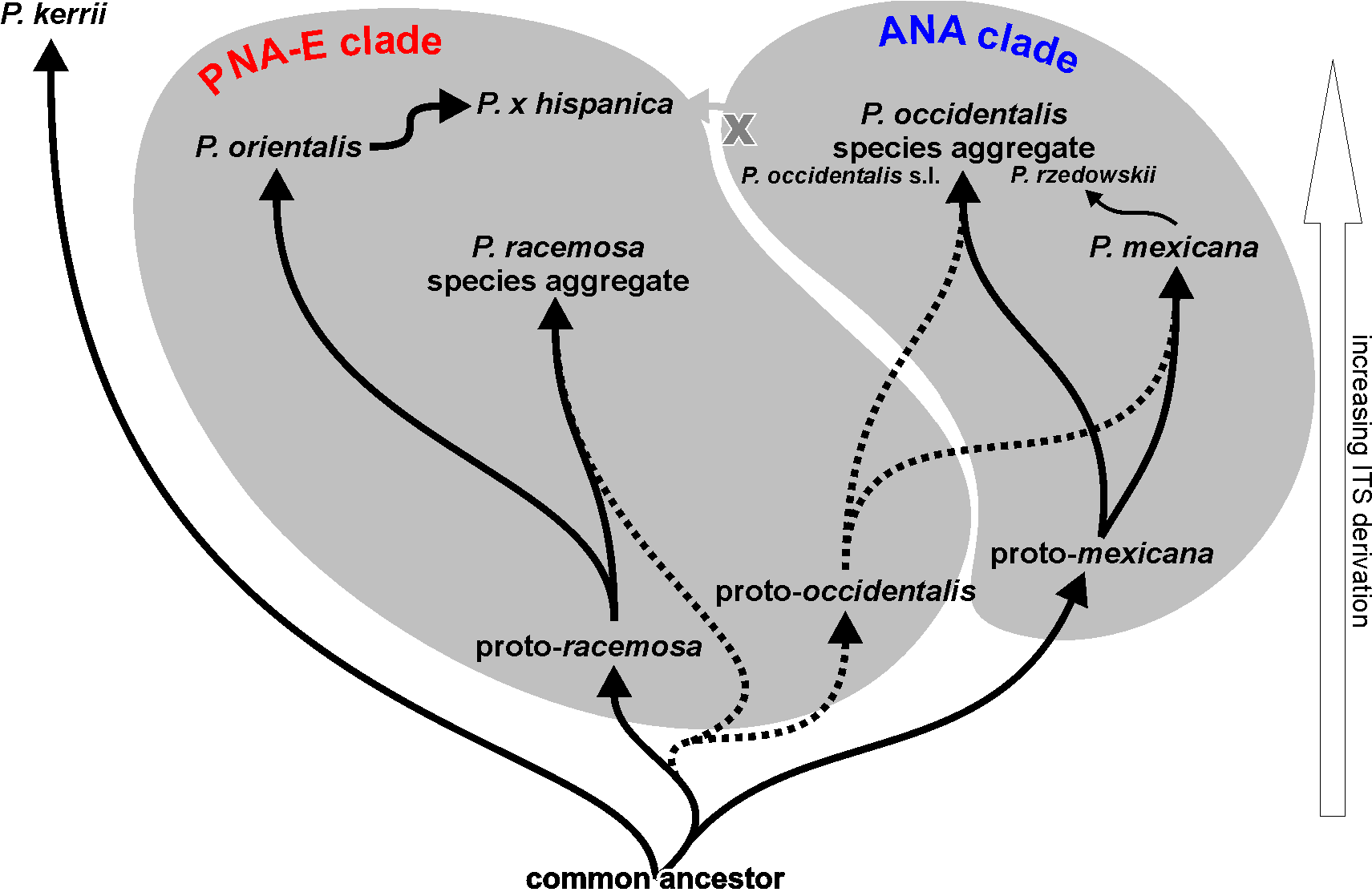 |
| Komarova NY, Grimm GW, Hemleben V, Volkov RA. 2008. Molecular evolution of 35S rDNA and taxonomic status of Lycopersicon within Solanum sect. Petota. Plant Systematics and Evolution 276: 59–71. | 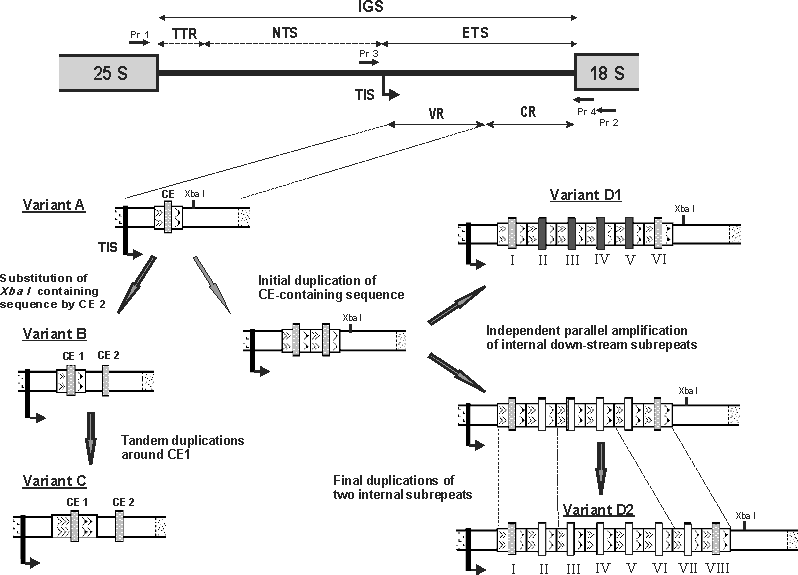 |
| Renner SS, Grimm GW, Schneeweiss GM, Stuessy TF, Ricklefs RE. 2008. Rooting and dating maples (Acer) with an uncorrelated-rates molecular clock: Implications for North American/Asian range disjunctions. Systematic Biology 57: 795–808. | 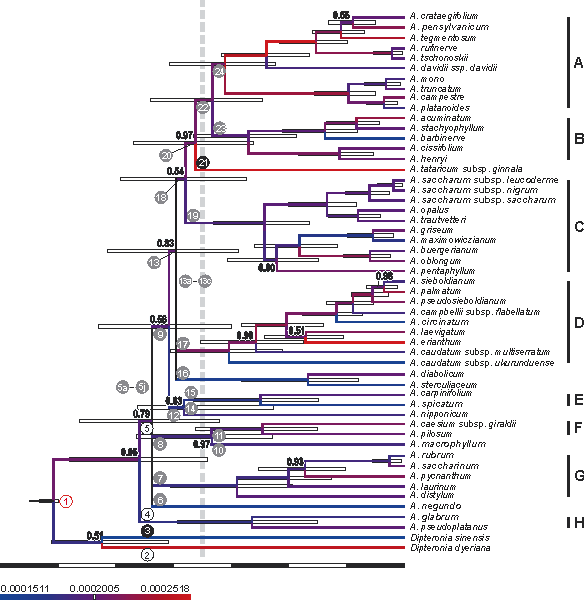 |
| Draper I, Hedenäs L and Grimm GW. 2007. Molecular and morphological incongruence in European species of Isothecium(Bryophyta). Molecular Phylogenetics and Evolution 42: 700–716. | 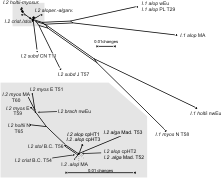 |
| Friis EM, Crane PR,
Pedersen KR, Bengtson S, Donoghue PCJ, Grimm GW, Stampanoni M. 2007. Phase-contrast X-ray
microtomography links Cretaceous seeds with Gnetales and Bennettitales.
Nature 450: 549–552.
— Related post @ Res.I.P.: What I was not allowed to show #1: A neighbour-net of seed plants. | 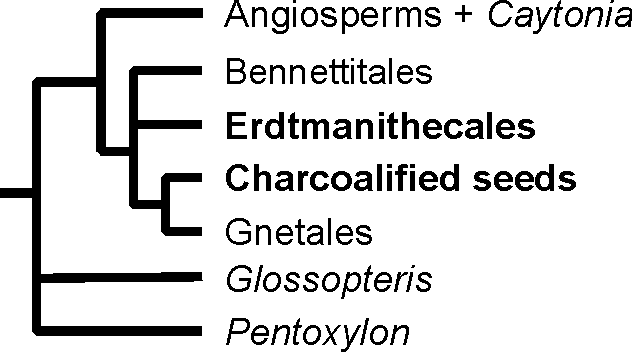 |
| Grimm GW, Denk T, Hemleben V. 2007. Evolutionary history and systematics of Acer section Acer - a case study of low-level phylogenetics. Plant Systematics and Evolution 267: 215–253. | 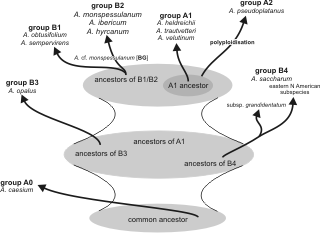 |
| Grimm GW, Denk T,
Hemleben V. 2007.Coding of intraspecific nucleotide polymorphisms: a tool to resolve reticulate
evolutionary relationships in the ITS of beech trees (Fagus L., Fagaceae).
Systematics and Biodiversity 5 (3): 291–309.
[PDF] © Systematics and Biodiversity,
The Natural History Museum
— Related post @ Res.I.P. The challenging and puzzling ordinary beech – a (hi)story |
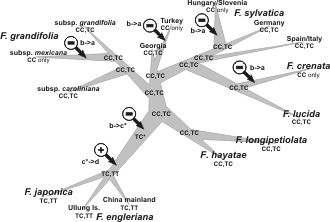 |
| Grimm GW, Stögerer K, Ertan KT, Kitazato H, Kučera M, Hemleben V, Hemleben C. 2007. Diversity of rDNA in Chilostomella: molecular differentiation patterns and putative hermit types. Marine Micropaleontology 62: 75–90. | 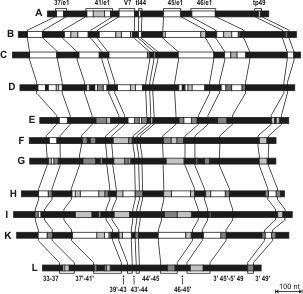 |
| Renner SS, Beenken L, Grimm GW, Kocyan A, Ricklefs RE. 2007. The evolution of dioecy, heterodichogamy, and labile sex expression in Acer. Evolution 61: 2701-2719. | 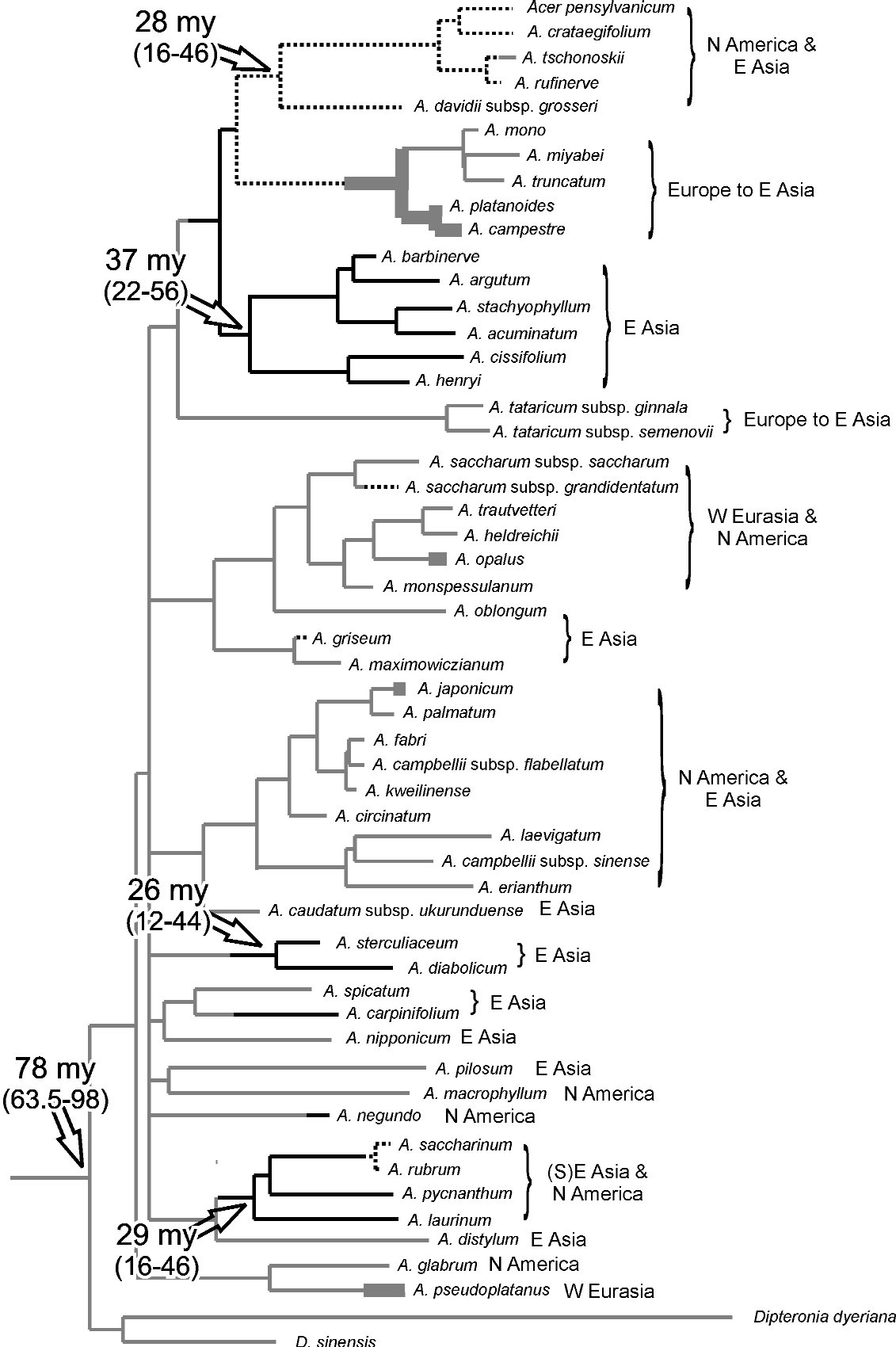 |
|
Grimm GW, Renner SS, Stamatakis A, Hemleben V. 2006. A nuclear ribosomal DNA phylogeny of
Acer inferred with maximum likelihood, splits graphs, and motif analyses of 606 sequences.
Evolutionary Bioinformatics 2: 7-22 [279-294†].
— Open access —
† Page numbers changed in 2007, originally pp. 279-294. | 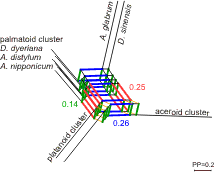 |
| Denk T, Grimm GW. 2005. Phylogeny and biogeography of Zelkova (Ulmaceae s.str.) as inferred from leaf morphology, ITS sequence data and the fossil record. Botanical Journal of the Linnean Society 147: 129-157. | 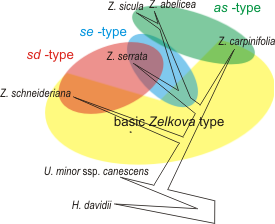 |
|
Denk T, Grimm GW, Hemleben V. 2005. Patterns of molecular and morphological differentiation
in Fagus: implications for phylogeny.
American Journal of Botany 92: 1006-1016. — Open access —
— Related post @ Res.I.P. The challenging and puzzling ordinary beech – a (hi)story | 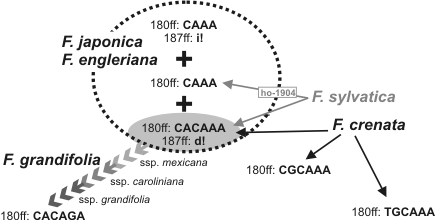 |
| Grimm GW, Schlee M, Komarova NY, Volkov RA, Hemleben V. 2005. Low-level taxonomy and intrageneric evolutionary trends in higher plants. Nova Acta Leopoldina NF Vol. 92, no. 342, p. 129-145. [PDF] (hi-res scan). | 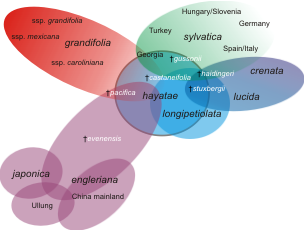 |
|
Grimm GW. 2003. Tracing the Mode and Speed of Intrageneric evolution - A phylogenetic case study
on genus Acer L. (Aceraceae) and genus Fagus L. (Fagaceae) using fossil, morphological, and
molecular data. D.Sc. thesis, Eberhard-Karls-Universität, Tübingen, Germany, 159 pp + appendices.
http://nbn-resolving.de/urn:nbn:de:bsz:21-opus-15744 [URI]
— Open access —
— Related post @ Res.I.P. The challenging and puzzling ordinary beech – a (hi)story | 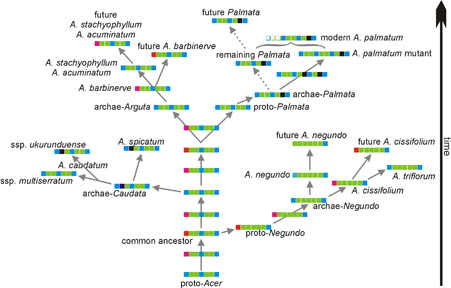 |
| Denk T, Grimm G,
Stögerer K, Langer M, Hemleben V. 2002. The evolutionary history of Fagus in western Eurasia:
Evidence from genes, morphology and the fossil record.
Plant Systematics and Evolution 232: 213-236.
— Related post @ Res.I.P. The challenging and puzzling ordinary beech – a (hi)story | 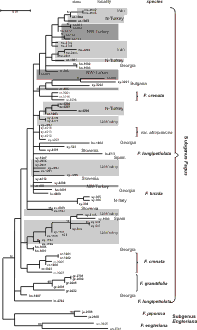 |
| Grimm GW. 2000. Mapping report and geological map of the north-eastern part of the Radicondoli Basin, Radicondoli, Tuscany, Italy. Eberhard-Karls-Universität, Tübingen, Germany, 27 pp. |  |
| Roth-Nebelsick A, Grimm G, Mosbrugger V, Hass H, Kerp H. 2000. Morphometric analysis of Rhynia and Asteroxylon: testing functional aspects of early land plant evolution. Paleobiology 26(3): 405-418. |  |
| Roth-Nebelsick A, Mosbrugger V, Grimm G. 2000. Evolution of Water Transport Systems in Early Land Plants - A trade-off between fabricational cost and functional performance. In: H-C Spatz & T. Speck (eds): Plant Biomechanics. Thieme Verlag, Stuttgart, p.123-128. |  |
| Grimm GW. 1999. Phylogenie der Cycadales. Graduation-Thesis, Eberhard-Karls-Universität, Tübingen, Germany, 82 pp. | Translated abstract |
| Access to full text |
Blogs, comments, shared figures (published as CC-BY)
Grimm G. Posted 23/11/2022. Comment on ResearchGate to the flawless study of Stubbs et al. (2022) "Whole genome analyses disentangle reticulate evolution of primroses in a biodiversity hotspot" (published in New Phytologist, Gold OA).Grimm GW. Posted 6/10–00/11/2022. Big Data = No Brain? Res.I.P. long-read. In three parts; about Acer phylogenomics (maples).
Part 2: Digging deeper.—The interesting little differences, and real novelities, so easy to overlook.
Part 3: Addressing the mammoth in the room.—Fraudulent dated phylogenies (Gao et al. 2020, Sci. Reports; Areces-Berazain et al. 2021; Genomics) and a species coral of Acer.
Grimm GW. Posted 9/9/2022. How predatory is MDPI? Or: The 50 shades of scientific grey. Res.I.P.. https://researchinpeace.blogspot.com/2022/09/how-predatory-is-mdpi-or-50-shades-of.html
Grimm GW. Posted 7/9/2022. ML, MP, NJ — what's the difference? Res.I.P.. https://researchinpeace.blogspot.com/2022/09/ml-mp-nj-whats-difference.html
Grimm GW. Posted 1/7/2022. Just a single, easily overlooked tip. Res.I.P.. https://researchinpeace.blogspot.com/2022/07/just-single-easily-overlooked-tip.html
Grimm GW. Posted 31/3/2022. Artkonzepte, in Bildern.
Res.I.P..
https://researchinpeace.blogspot.com/2022/03/artkonzepte-in-bildern.html
— related popular-science paper: Alles Bastarde [Bastards everywhere],
available in German (original) and English (translated with DeepL, edited by the authors).
Grimm GW. Posted 21/1/2022. Scientia-ex-machina: explicit biogeographic inferences and the phylogenomic age. Res.I.P.. https://researchinpeace.blogspot.com/2022/01/scientia-ex-machina-explicit.html
Grimm GW. Posted 6/1/2022. Searching for a new research object? Why not maples! Res.I.P.. https://researchinpeace.blogspot.com/2022/06/searching-for-research-object-why-not.html
Grimm GW. Posted 15/12/2021. Monophyletic species. Res.I.P.. https://researchinpeace.blogspot.com/2021/12/monophyletic-species.html
Grimm GW. Posted 29/9/2021. A fully resolved, and perfectly misleading, species tree.
Res.I.P..
https://researchinpeace.blogspot.com/2021/09/a-fully-resolved-and-perfectly.html
— discussed data included in my figshare Fagaceae collection.
Grimm G. Posted 29/1/2021. Comment on ResearchGate to Areces-Berazain et al. (2021) "Genome-wide supermatrix analyses of maples (Acer, Sapindaceae) reveal recurring inter-continental migration, mass extinction, and rapid lineage divergence" (published in Genomics). [Link to tweet]
Grimm G. Posted 20/12/2020. Comment on ResearchGate to Grossoni et al. (2021) "The taxonomic interpretation of Mediterranean oaks of Quercus sect. Quercus (Fagaceae): uncertainties and diverging concepts" (published in Flora Mediterranea).
Grimm GW. Posted 19/10/2020. Xenoplasy. The Genealogical World of Phylogenetic Networks (ed. by D. Morrison). http://phylonetworks.blogspot.fr/2020/10/xenoplasy.html
Grimm GW. Posted 5/10/2020. Rogue dinosaurs, an example from the Aetosauria. The Genealogical World of Phylogenetic Networks (ed. by D. Morrison). http://phylonetworks.blogspot.fr/2020/09/rogue-dinosaurs-example-from-aetosauria.html
Grimm GW. Posted 14/9/2020. Exploring the oak phylogeny. The Genealogical World of Phylogenetic Networks (ed. by D. Morrison). http://phylonetworks.blogspot.fr/2020/09/exploring-oak-phylogeny.html
Grimm GW. Posted 7/9/2020. Fossils and networks 3 – (deleting and) adding one tip. The Genealogical World of Phylogenetic Networks (ed. by D. Morrison). http://phylonetworks.blogspot.fr/2020/09/fossils-and-networks-3-deleting-and.html
Grimm GW. Posted 10/8/2020. Fossils and networks 2 – deleting (and adding) one tip. The Genealogical World of Phylogenetic Networks (ed. by D. Morrison). http://phylonetworks.blogspot.fr/2020/08/fossils-and-networks-2-deleting-and.html
Grimm GW. Posted 22/6/2020. Can we dig too deep? Signal conflict in mitochondrial genes of land plants. The Genealogical World of Phylogenetic Networks (ed. by D. Morrison). http://phylonetworks.blogspot.fr/2020/06/can-we-dig-too-deep-signal-conflict-in.html
Grimm GW. Posted 15/6/2020. How would I (realistically) analyze CoV-2 (or similar) data. The Genealogical World of Phylogenetic Networks (ed. by D. Morrison). http://phylonetworks.blogspot.fr/2020/06/how-i-would-realistically-analyze-cov-2.html
Grimm GW. Posted 8/6/2020. Hack and fish ... for recombination in the SARS group. The Genealogical World of Phylogenetic Networks (ed. by D. Morrison). http://phylonetworks.blogspot.fr/2020/06/hack-and-fish-for-recombination-in-sars.html
Grimm GW. Posted 1/6/2020. To what degree are Median-joining networks phylogenetic? The Genealogical World of Phylogenetic Networks (ed. by D. Morrison). http://phylonetworks.blogspot.fr/2020/06/to-what-degree-are-median-joining.html
Grimm GW. Posted 18/5/2020. Supernetworks and gene tree incongruence. The Genealogical World of Phylogenetic Networks (ed. by D. Morrison). http://phylonetworks.blogspot.fr/2020/05/supernetworks-and-gene-tree-incongruence.html
Grimm GW. Posted 4/5/2020. Finding the CoV-2 root. The Genealogical World of Phylogenetic Networks (ed. by D. Morrison). http://phylonetworks.blogspot.fr/2020/05/finding-cov-2-root.html
Grimm GW. Posted 20/04/2020. Using Median Networks to study SARS-CoV-2. The Genealogical World of Phylogenetic Networks (ed. by D. Morrison). http://phylonetworks.blogspot.fr/2020/04/using-median-networks-to-study-sars-cov.html
Morrison D, Grimm GW. Posted 6/4/2020. Consensus networks: cluster union or edge union?. The Genealogical World of Phylogenetic Networks (ed. by D. Morrison). http://phylonetworks.blogspot.fr/2020/04/consensus-networks-cluster-union-or_6.html
Grimm GW, Morrison D. Posted 30/3/2020. Trees and viruses: the SARS group.
The Genealogical World of Phylogenetic Networks.
http://phylonetworks.blogspot.fr/2020/03/trees-and-viruses-sars-group.html
— relevant data available via figshare.
Grimm GW. Posted 9/3/2020. Sneak peek into SplitsTree5 The Genealogical World of Phylogenetic Networks (ed. by D. Morrison). http://phylonetworks.blogspot.fr/2020/03/sneak-peek-into-splitstree5.html
Grimm GW. Posted 17/2/2020. Large morphomatrices – trivial signal. The Genealogical World of Phylogenetic Networks (ed. by D. Morrison). http://phylonetworks.blogspot.fr/2019/02/large-morphomatrices-trivial-signal.html
Grimm GW. Posted 10/2/2020. Fossils and networks 1 – Farris and Felsenstein. The Genealogical World of Phylogenetic Networks (ed. by D. Morrison). http://phylonetworks.blogspot.fr/2019/02/fossils-and-networks-1-farris-and.html
Grimm G. Posted 29/1/2020 on RAxML google group. Tips for analysing ternary data, why total evidence may not be a good choice (for plants) and some references/links.
Grimm G. 2020. Fagaceae collection. File set, figshare doi: 10.6084/m9.figshare.11603547
Grimm GW. Posted 13/1/2019. Why we may want to map trait evolution on networks, pt. 2 – Topological ambiguity. The Genealogical World of Phylogenetic Networks (ed. by D. Morrison). http://phylonetworks.blogspot.fr/2019/12/why-we-may-want-to-map-trait-evolution2.html
Grimm GW. Posted 6/1/2019. Why we may want to map trait evolution on networks, pt. 1 – Introduction. The Genealogical World of Phylogenetic Networks (ed. by D. Morrison). http://phylonetworks.blogspot.fr/2019/12/why-we-may-want-to-map-trait-evolution.html
Grimm GW. Posted 23/12/2019. Evolutionary processes hidden in Christmas clip arts. The Genealogical World of Phylogenetic Networks (ed. by D. Morrison). http://phylonetworks.blogspot.fr/2019/12/evolutionary-processes-hidden-in.html
Grimm GW. Posted 09/12/2019. The Science of Spices by S. Farrimond — in networks. The Genealogical World of Phylogenetic Networks (ed. by D. Morrison). http://phylonetworks.blogspot.fr/2019/12/the-science-of-spice-by-s-farrimond-in.html
Grimm GW. Posted 02/12/2019. Trees informing networks explaining trees. The Genealogical World of Phylogenetic Networks (ed. by D. Morrison). http://phylonetworks.blogspot.fr/2019/12/trees-informing-networks-explaining.html
Grimm GW. Posted 18/11/2019. Why the emperor has no clothes on – conflict or not? The Genealogical World of Phylogenetic Networks (ed. by D. Morrison). http://phylonetworks.blogspot.fr/2019/11/why-emporer-has-no-clothes-on-conflict.html
Grimm GW, Morrison D. Posted 11/11/2019. A new playground for networks and exploratory data analysis. The Genealogical World of Phylogenetic Networks (ed. by D. Morrison). http://phylonetworks.blogspot.fr/2019/11/a-new-playground-for-networks-and.html
Grimm GW. Posted 4/11/2019. Why the emperor has no clothes on – a thicket of trees. The Genealogical World of Phylogenetic Networks (ed. by D. Morrison). http://phylonetworks.blogspot.fr/2019/11/why-emperor-has-no-clothes-on-thicket.html
Grimm GW. Posted 21/10/2019. Why the emperor has no clothes on – the mighty matK.
The Genealogical World of Phylogenetic Networks (ed. by D. Morrison).
http://phylonetworks.blogspot.fr/2019/10/why-emperor-has-no-clothes-on-mighty.html
— used data matrix (taxon-reduced for the post) has been published on figshare.
Grimm GW. Posted 18/10/2020. When dating is futile – plastome-based chronograms for oaks. Res.I.P.. https://researchinpeace.blogspot.com/2019/10/when-dating-is-futile-plastome-based.html
Grimm G. Posted 10/10/2019. Comment on ResearchGate to Bazhenova & Bazhenov (2019) "Stems of a New Osmundaceous Fern from the Middle Jurassic of Kursk Region, European Russia" (published in Paleontological Journals).
Grimm G. Posted 16/9/2019. Online comment (limited to 4000 digits) to Li et al. (2019) "Landscape Features and Climatic Forces Shape the Genetic Structure and Evolutionary History of an Oak Species (Quercus chenii) in East China" (published in Frontiers in Plant Science).
Grimm GW. Posted 19/9/2019. When dating is futile – plastome-based chronograms for oaks.
Res.I.P..
https://researchinpeace.blogspot.com/2019/09/why-you-never-should-do-single-species.html
Morrison D, Grimm GW. Posted 16/9/2019. A network of happiness, by ranks.
The Genealogical World of Phylogenetic Networks (ed. by D. Morrison).
http://phylonetworks.blogspot.fr/2019/09/a-network-of-happiness-by-ranks.html
Grimm G. Posted 17/7/2019.
Comment on ResearchGate to Liu et al. (2019) "Complete chloroplast genome sequence and phylogenetic analysis of Quercus bawanglingensis
Huang, Li et Xing, a vulnerable oak tree in China" (published in Forests).
Grimm GW. Posted 8/7/2019. Character cliques and networks – mapping haplotypes of manual alphabets.
The Genealogical World of Phylogenetic Networks (ed. by D. Morrison).
http://phylonetworks.blogspot.fr/2019/character-cliques-and-networks-mapping.html
Grimm GW. Posted 1/7/2019. Stacking networks based on sign language manual alphabets.
The Genealogical World of Phylogenetic Networks (ed. by D. Morrison).
http://phylonetworks.blogspot.fr/2019/07/stacking-networks-based-on-sign.html
Grimm GW. Posted 17/6/2019. Ockham's Razor applied but not used: can we do DNA-scaffolding with seven characters?
The Genealogical World of Phylogenetic Networks (ed. by D. Morrison).
http://phylonetworks.blogspot.fr/2019/06/ockhams-razor-applied-but-not-used-can.html
Grimm GW. Posted 22/4/2019. The 2nd Amendment does more than keeping King George away.
The Genealogical World of Phylogenetic Networks (ed. by D. Morrison).
http://phylonetworks.blogspot.fr/2019/04/the-2nd-amendment-does-more-than.html
Grimm GW. Posted 8/4/2019. Next-generation neighbor-nets.
The Genealogical World of Phylogenetic Networks (ed. by D. Morrison).
http://phylonetworks.blogspot.fr/2019/04/next-generation-neighbor-nets.html
Grimm GW. Posted 21/3/2019. How to interpret bootstrap values.
Res.I.P..
https://researchinpeace.blogspot.com/2019/03/how-to-interpret-bootstrap-values.html
Grimm GW. Posted 4/3/2019. Has homoiology been neglected in phylogenetics?
The Genealogical World of Phylogenetic Networks (ed. by D. Morrison).
http://phylonetworks.blogspot.fr/2019/03/has-homoiology-been-neglected-in.html
Grimm G. Posted 22/2/2018.
Comment on ResearchGate to Suc et al. (2019) "Reconstruction of Mediterranean flora, vegetation and climate for the
last 23 million years based on an extensive pollen dataset"
(published in Ecologia Mediterranea).
Grimm GW. Posted 18/2/2019. Can we depict the evolution of highly conserved genes, such as the ribosomal RNA genes?
The Genealogical World of Phylogenetic Networks (ed. by D. Morrison).
http://phylonetworks.blogspot.fr/2019/02/can-we-depict-evolution-of-highly.html
Grimm GW. Posted 4/2/2019. Should we bother about character independence?
The Genealogical World of Phylogenetic Networks (ed. by D. Morrison).
http://phylonetworks.blogspot.fr/2019/02/should-we-bother-about-character.html
Grimm GW. Posted 31/1/2019. There's no need to do what you can't. A comment to Yang et al. (PeerJ, 2019)
with some tips for biogeographic analyses.
Res.I.P..
https://researchinpeace.blogspot.com/2019/01/theres-no-need-to-do-what-you-cant.html
Grimm G. Posted 14/1/2019.
Feedback to pre-print of Worth et al. (2019) "The complete chloroplast genome of Fagus crenata (subgenus Fagus)
and comparison with F. engleriana (subgenus Engleriana)"
(published in PeerJ Preprints).
Grimm GW. Posted 14/1/2018. Phylogenetic ambiguity: data gaps, indifference and internal conflict.
The Genealogical World of Phylogenetic Networks (ed. by D. Morrison).
http://phylonetworks.blogspot.fr/2019/01/phylogenetic-ambiguity-data-gaps.html
Grimm G. Posted 10/1/2019.
Comment on ResearchGate to Ivanov & Lazarova "Past climate and vegetation in Southeast Bulgaria — a study based on the late Miocene pollen record from the Tundzha
Basin"
(published in J. Palaeogeogr.)
Grimm GW. Posted 24/12/2018. A jolly, holly network ... of Christmas carols.
The Genealogical World of Phylogenetic Networks (ed. by D. Morrison).
http://phylonetworks.blogspot.fr/2018/12/a-jolly-holly-network-of-christmas.html
Grimm G. Posted 10/12/2018.
Comment on ResearchGate to Altolaguirre et al. (2018) "An environmental scenario for the early hominins in the Iberian
Peninsula: Early Pleistocene palaeovegetation and palaeoclimate"
(published in Rev. Palaeobot. Palynol.)
Grimm GW. Posted 10/12/2018. Please stop using cladograms!
The Genealogical World of Phylogenetic Networks (ed. by D. Morrison).
http://phylonetworks.blogspot.fr/2018/12/please-stop-using-cladograms.html
List J-M, Grimm GW. Posted 26/11/2018. How languages lose body parts: once more about structural data in historical
linguistics.
The Genealogical World of Phylogenetic Networks (ed. by D. Morrison).
http://phylonetworks.blogspot.fr/2018/11/how-languages-lose-body-parts-once-more.html
Grimm GW. Posted 12/11/2018. More heretic bits: networks for (more) recent matrices published in Cladistics.
The Genealogical World of Phylogenetic Networks (ed. by D. Morrison).
http://phylonetworks.blogspot.fr/2018/11/more-heretic-bits-networks-for-more.html
Grimm GW. Posted 8/11/2018. Cladistics vs Phylogenetics. What's the difference?
Res.I.P..
https://researchinpeace.blogspot.com/2018/11/cladistics-vs-phylogenetics-whats.html
Grimm GW. Posted 5/11/2018. A bit of heresy: networks for matrices used in Cladistics studies.
The Genealogical World of Phylogenetic Networks (ed. by D. Morrison).
http://phylonetworks.blogspot.fr/2018/10/a-bit-of-heresy-networks-for-matrices.html
Grimm G. Posted 16/10/2018. Need for a stringent classification concept, also in palynological studies.
Online comment to Lu et al., PLoS ONE, 2018, Morphological diversity of Quercus fossil pollen
in the northern South China Sea during the last glacial maximum and its paleoclimatic implication.
Grimm GW. Posted 15/10/2018. Jumping political parties in Germany's state elections.
The Genealogical World of Phylogenetic Networks (ed. by D. Morrison).
http://phylonetworks.blogspot.fr/2018/10/jumping-political-parties-in-germanys.html
Grimm G.
2018. Collection of morphological matrices (some including extinct taxa) and related phylogenetic inferences. File set.
figshare doi: 10.6084/m9.figshare.7067369.v2.
Grimm GW. Posted 03/09/2018. More on networks for placing fossils, such as Eocene lantern fruits. The Genealogical World of Phylogenetic Networks (ed. by D. Morrison).
http://phylonetworks.blogspot.fr/2018/09/more-on-networks-for-placing-fossils.html
Grimm GW. Posted 06/08/2018. Trivial data, but not so trivial graphs. The Genealogical World of Phylogenetic Networks (ed. by D. Morrison).
http://phylonetworks.blogspot.fr/2018/08/trivial-data-but-not-so-trivial-graphs.html
Grimm GW, Morrison D. Posted 16/07/2018. A network of World happiness. The Genealogical World of Phylogenetic Networks (ed. by D. Morrison).
http://phylonetworks.blogspot.fr/2018/07/a-network-of-world-happiness.html
Grimm GW. Posted 02/07/2018. Reticulation at its best, an example of the oaks. The Genealogical World of Phylogenetic Networks
(ed. by D. Morrison).
http://phylonetworks.blogspot.fr/2018/07/reticulation-at-its-best-example-from.html
Grimm GW, Holt TR. Posted 18/06/2018. To boldy go where no one has gone before – networks of moons.
The Genealogical World of Phylogenetic Networks (ed. by D. Morrison).
http://phylonetworks.blogspot.fr/2018/06/to-boldy-go-where-no-one-has-gone.html
Related data via figshare.
Related data can be found on GitHub
Looking for the data and NEXUS-files to place yourself: It's on figshare
— Accompanying analysis files are provided @ figshare
Grimm GW. Posted 11/06/2018. Want to place a fossil in a minute? Just use neighbour-nets. The Genealogical World of
Phylogenetic Networks (ed. by D. Morrison).
http://phylonetworks.blogspot.fr/2018/06/want-to-place-fossil-in-minute-just-use.html
— used matrix of Doyle & Endress (2018; NEXUS-formatted instead of supplementary figure) and graphs (raw, drawn)
can be found on figshare
Grimm GW, Morrison D. Posted 07/05/2018. Keeping it simple in phylogenetics. The Genealogical World of Phylogenetic Networks. http://phylonetworks.blogspot.fr/2018/05/keeping-it-simple-in-phylogenetics.html
Grimm G. Posted 23/04/2018. Comment on ResearchGate to Liu et al. (2018) "Historical biogeography of Loranthaceae (Santalales): Diversification agrees with emergence of tropical forests and radiation of songbirds" (published in Mol. Phylogenet. Evol.)
Grimm GW. Posted 23/04/2018. A (wal)nut to crack – what a network tells you that no tree can. The Genealogical World of Phylogenetic Networks (ed. by D. Morrison). http://phylonetworks.blogspot.fr/2018/04/a-walnut-to-crack-what-network-tells.html
Grimm GW, Morrison D. Posted 09/04/2018. The curious case(s) of tree-like matrices with no synapomorphies. The Genealogical World of Phylogenetic Networks. http://phylonetworks.blogspot.fr/2018/04/the-curious-cases-of-tree-like-matrices.html
Grimm GW. Posted 02/04/2018. Things you can learn in a blink about your data. The Genealogical World of
Phylogenetic Networks (ed. by D. Morrison).
http://phylonetworks.blogspot.fr/2018/04/things-you-can-learn-in-blink-about.html
— matrices and graphs (raw, drawn) have been published on figshare
Grimm GW. Posted 19/03/2018. Comparing neighbour-nets and PCA graphs – the example of Mediterranean oaks. The Genealogical World of Phylogenetic Networks (ed. by D. Morrison). http://phylonetworks.blogspot.fr/2018/03/comparing-neighbour-nets-and-pca-graphs.html
Grimm G. 2018. A basic total evidence matrix for basal angiosperms — combining Soltis et al. (2011) with Doyle & Endress (2010). Fileset, figshare doi: 10.6084/m9.figshare.5997656.v1.
Grimm G. 2018. Signals in the Aetosauria matrix by W. G. Parker (2016). figshare doi: 10.6084/m9.figshare.5956435.v2.
Grimm GW. Posted 5/3/2018. Visualizing U.S. gun laws. The Genealogical World of Phylogenetic
Networks (ed. by D. Morrison).
http://phylonetworks.blogspot.fr/2018/03/visualizing-us-gun-laws.html
— data matrix and graphs (raw, drawn) have been published on figshare
Grimm GW, Morrison D. Posted 19/2/2018. We want to publish our phylogenetic data – including networks, but where? The Genealogical World of Phylogenetic Networks (ed. by D. Morrison). http://phylonetworks.blogspot.fr/2018/02/we-want-to-publish-our-phylogenetic.html
Grimm G. Posted 6/2/2018. Online comment (limited to 4000 characters) to Yang et al. (2018) "Plastid comparative and phylogenetic analysis of the key genera in Fagaceae: highlighting the effect of codon composition bias in phylogenetic inference" published in Frontiers in Plant Science
Grimm GW. Posted 5/2/2018. All solved a decade ago: the asterisk branch in the Fagales phylogeny. The Genealogical World of Phylogenetic Networks (ed. by D. Morrison). http://phylonetworks.blogspot.fr/2018/01/all-solved-decade-ago-asterisk-branch.html
Grimm GW. Posted 22/1/2018. Using median networks to understand the evolution of genera. The Genealogical World of Phylogenetic Networks (ed. by D. Morrison). http://phylonetworks.blogspot.fr/2018/01/using-median-networks-to-understand.html
Grimm GW. Posted 2/1/2018. Summarizing non-trivial Bayesian tree samples for dating? Just use support consensus networks. The Genealogical World of Phylogenetic Networks (ed. by D. Morrison). http://phylonetworks.blogspot.fr/2018/01/summarizing-non-trivial-bayesian-tree.html
Grimm GW. Posted 12/12/2017. Using consensus networks to understand poor roots. The Genealogical World of Phylogenetic Networks (ed. by D. Morrison). http://phylonetworks.blogspot.fr/2017/12/using-consensus-networks-to-understand.html
Grimm G. 2017. Over-the-edge tables and reconstructions linked to the slimmed-down paper by Wanntorp et al. (2014), published in Taxon. figshare doi:10.6084/m9.figshare.5688181.v1.
List J-M & Grimm GW. Posted 28/11/2017. And man gave names to all those animals: sheep and goats. The Genealogical World of Phylogenetic Networks (ed. by D. Morrison). http://phylonetworks.blogspot.fr/2017/11/man-gave-names-to-all-those-animals.html
List J-M & Grimm GW. Posted 23/10/2017. And man gave names to all those animals: cats and dogs. The Genealogical World of Phylogenetic Networks (ed. by D. Morrison). http://phylonetworks.blogspot.fr/2017/10/man-gave-names-to-all-those-animals.html
Grimm GW. Posted 17/10/2017. Networks, not trees, identify “weak spots” in phylogenetic trees. The Genealogical World of Phylogenetic Networks (ed. by D. Morrison). http://phylonetworks.blogspot.fr/2017/10/networks-not-trees-identify-weak-spots.html [data]
Grimm G. 2017. Classification of mosasaurs - using networks. figshare doi:10.6084/m9.figshare.5497903.v1.
Grimm GW. Posted 3/10/2017. Clades, cladograms, cladistics, and why networks are inevitable. The Genealogical World of Phylogenetic Networks (ed. by D. Morrison). http://phylonetworks.blogspot.fr/2017/10/clades-cladograms-cladistics-and-why.html
Grimm GW. Posted 12/9/2017. A network of political parties competing for the 2017 Bundestag. (ed. by D. Morrison). http://phylonetworks.blogspot.fr/2017/09/^a-network-of-political-parties.html
Grimm GW. Posted 29/8/2017. More non-treelike data forced into trees: a glimpse into the dinosaurs The Genealogical World of Phylogenetic Networks (ed. by D. Morrison). http://phylonetworks.blogspot.com/2017/08/more-non-treelike-data-forced-into.html
Grimm GW. Posted 1/8/2017. Stacking neighbour-nets: a real-world example. The Genealogical World of Phylogenetic Networks (ed. by D. Morrison). http://phylonetworks.blogspot.fr/2017/08/stacking-neighbour-nets-real-world.html
Grimm G. 2017. Osmundales diversity through time: stacking networks. figshare doi:10.6084/m9.figshare.5255014.v1.
Grimm GW. Posted 18/7/2017.Stacking neighbour-nets: ancestors and descendants. The Genealogical World of Phylogenetic Networks (ed. by D. Morrison). http://phylonetworks.blogspot.com/2017/07/stacking-neighbour-nets-ancestors-and.html
Grimm G. Posted 7/7/2017. Comment to paper by Rothwell & Stockey (2016), shared on ResearchGate
Grimm G. Posted 7/7/2017. Answer to "How does RAxML handle a variable number of character states for the Mk model"
Grimm GW. Posted 4/7/2017. Should we infer trees on treeunlikely matrices? The Genealogical World of Phylogenetic Networks (ed. by D. Morrison). http://phylonetworks.blogspot.fr/2017/07/should-we-try-to-infer-trees-on.html
Grimm G. 2017. Morphology-based neighbour-net of seed plants: quick exploratory data analysis of the matrix of Rothwell &amb; Stockey (2016). figshare doi:10.6084/m9.figshare.5143732.v1.
Grimm G. Posted 15/6/2017. Comment(s) on the pre-print shared on RG by Coiro et al., bioRxiv, doi: 10.1101/134262
Grimm G. 2017. Morphology-based neighbour-net of seed plants. figshare doi:10.6084/m9.figshare.5111062.v1
Grimm GW. 2015. Interactive comment on “Strong winter monsoon wind causes surface cooling over India and China in the Late Miocene” by H. Tang et al. Climates of the Past Discussions 11, C116–C122. [Response to the author's response to my original comment]
Grimm GW. 2015. Interactive comment on “Strong winter monsoon wind causes surface cooling over India and China in the Late Miocene” by H. Tang et al. Climates of the Past Discussions 11, C81–C86.
Grimm G. Posted 27/11/2014 and 9/12/2014. Comments regarding substantial amount of misidentified sequences used for
Tripathi et al., 2013,
PLoS ONE 8:e57934
Workshops
Grimm G, Potts A. Phylogenetic networks. Two 2-day workshops held at Kirstenbosch Botanical Gardens, December 2013
Presentations
2016
Grimm G. A life under the bridge: tales of a geologist-geneticist. Lecture. Topics of Palaeontology III. Seminar series of the University of Vienna, Institute of Palaeontology. Wien, Januar 2016.Similar talk given at Institute of Botany, Wien, April 2016
Grímsson F, Bouchal JM, Zetter R, Grimm GW. Evaluating the mid-Miocene paleoclimate of Lower Carinthia (Austria) based on high resolution palynological studies from the Lavanttal Basin. EGU General Assembly, Wien, April 2016. [abstract]
2015
Grimm G. The two towers: What do genes and fossils tell us about evolutionary history (of plants).
Invited lecture. Third Summer School in Molecular Biophysics and System Biology. Nove Hrady, July 2015.
[abstract]
Same lecture given at Nelson Mandela Metropolitan University, Port Elizabeth, November 2015
Hipp AL, Manos P, McVay JD, Cavender-Bares J, Gonzalez Rodriguez A, Romero-Severson J, Hahn M, Brown BH, Budaitis B, Deng M, Grimm G, Fitzek E, Cronn RC, Jenning TL, Avishai M, Simeone MC. A phylogeny of the world’s oaks. Botany 2015, Edmonton, July 2015. [Abstract]
2014
Grímsson F, Højgaard B, Hofmann CC, Pott C, Grimm G, Friðgeirsson GR, Denk T, Zetter R. Revisiting the late Paleocene Mykines macrofossil site, Faroe Islands. 9th European Palaeobotany – Palynology Conference, Padova, August 2014. [abstract]
Pott C, Grímsson F, Højgaard B, Hofmann CC, Grimm G, Friðgeirsson GR, Denk T. First Ginkgo leaf fossils from the Faroe Islands. 9th European Palaeobotany – Palynology Conference, Padova, August 2014. [poster]
Sanem Koç Ç, Denk T, Grimm G, Güner HT. New palaeobotanical records for the Miocene of Turkey and their significance for the palaeobiogeography of the East Mediterranean region. 9th European Palaeobotany – Palynology Conference, Padova, August 2014. [poster]
Zetter R, Grímsson F, Hofmann CC, Grimm G. Paleogene Loranthaceae pollen from West Greenland and Eurasia. 9th European Palaeobotany – Palynology Conference, Padova, August 2014. [abstract]
2012
Grimm GW. Fagus and Quercus – a tale of two unequal sisters. Keynote. IUFRO Meeting "Genetics of the Fagaceae", Bordeaux, October 2012.
Grimm GW. Phylogenetic tools in reconstructing past evolutionary patterns. Oral presentation. 31st IUBS General Assembly and Conference on Biological Sciences and Bioindustry, Suzhou, Juli 2012.
2011
Wanntorp L, Grimm GW, Forster PI, Grudinski M, Muellner A. The genus Hoya (Apocynaceae) and its contribution to the understanding of the diversification of the Indomalesian archipelago. International Botanical Conference, Melborne, July 2011.
2010
Grimm GW. Clearing up the "thicket of life": How to include fossils in phylogenetic reconstructions. 8th European Palaeobotany – Palynology Conference, Budapest, July 2010. Oral presentation. [abstract]
Grimm GW, Denk T. The role of the North Atlantic Land Bridge for Neogene transatlantic plant migration: Morphological, molecular and fossil evidence. Oral presentation. 8th European Palaeobotany – Palynology Conference, Budapest, July 2010. [abstract]
2009
Schlee M, Göker M, Grimm GW, Hemleben V. Molecular phylogeny and species definition within the species rich Astragalus/Oxytropis complex (Fabaceae). Yearly meeting of the German Botanical Society, Leipzig, September 2009. [poster]
Denk T, Grimm GW. Phylogenetics and the palaeobotanical revolution. Yearly meeting of the German Palaeontological Society, Bonn, October 2009.
2008
Renner SS, Grimm GW. Estimating the ages of extant Gnetales. 8th conference of the International Organisation of Palaeobotany (IOPC-VIII), Bonn, August/September 2008. [abstract]
2007
Schlee M, Grimm GW, Sauer W, Hemleben V. Broad data from nuclear spacers fill the gap between population studies and phylogenetics - A case study of Lathyrus and Oxytropis (Fabaceae). Popbio 2007, Basel, May 2007. [abstract]
Aurahs R, Grimm G, Hemleben V, Hemleben C, Kučera M. Genetic types of Globigerinoides ruber in the Eastern Atlantic and the Mediterranean Sea. The Foraminiferal and Nanofossil Groups joint Spring Meeting 2007, Angers, June 2007.
Renner SS, Grimm GW, Schneeweiß GM, Stuessy TF, Ricklefs R. Rooting and dating maples via Bayesian evolutionary analyses: Implications for Asian/North American range disjunctions. Botany & Plant Biology 2007 Joint Congress, Chicago, July 2007. Link to abstract.
Grimm GW, Denk T. ITS evolution in Platanus: Homoeologues, pseudogenes, and ancient hybridisation. Oral presentation, abstract. ESEB XI Congress, Uppsala, August 2007.
Grimm G, Denk T, Hemleben V. Farewell to dichotomous models of phylogeny: Reconstructing patterns of low-level evolution in maples. Poster presentation, abstract. Meeting of the German Botanical Society, Hamburg, September 2007.
Hemleben V, Komarova N, Grimm G, Volkov R. Origin and taxonomic status of Lycopersicon: Evidence from the evolution of the rDNA 5#146; external transcribed spacer. Meeting of the German Botanical Society, Hamburg, September 2007. Link to abstract.
Schlee M, Göker M, Grimm G, Sauer W, Hemleben V. Ecological adaptation leading to speciation in Lathyrus: Combining nuclear spacer data and phytosociologic surveys using phylogenetic networks. Meeting of the German Botanical Society, Hamburg, September 2007. Link to abstract.
2006
Grimm GW, Sprenger D, Hemleben C, Hemleben V. Molecular evolution of the foraminiferal SSU rDNA: prospects and pitfalls. Oral presentation, abstract. FORAMS 2006, Natal, September 2006.
Hemleben V, Grimm GW, Kitazato H, Hemleben C. Diversity of rDNA in Chilostomella: molecular differentiation pattern and putative hermit types. FORAMS 2006, Natal, September 2006. Link to abstract.
2005
Denk T, Grimm GW, Tekleva, MV. Morphology, genes, and fossils to infer evolution in Platanaceae. XVII International Botanical Congress, Vienna, July 2005.
Schlee M, Grimm GW, Hemleben V. Molecular defined migration pathways of rare species of the genera Lathyrus and Oxytropis (Fabaceae). XVII International Botanical Congress, Vienna, July 2005.
2004
Grimm GW, Hemleben V.. Low-level taxonomy and intrageneric evolutionary trends in higher plants. Invited speech. Symposion "From plant taxonomy to molecular systematics" of the "Deutschen Akademie der Naturforscher Leopoldina". Reichelsheim, Germany, June 2004.
Grimm GW, Schlee M, Hemleben V. Ancient and recent hybridisation - the ITS as tool to reconstruct reticulate evolution. Oral presentation. Biannual meeting of the German Botanical Society (DBG), Braunschweig, August 2004.
2002
Grimm GW, Hemleben V. Tracing the molecular evolution and phylogenetic relationships of maples (genus Acer, Aceraceae). Poster presentation. Biannual meeting of the German Botanical Society (DBG). Freiburg i. Br., September 2002.
2001
Grimm G, Denk T, Stögerer K, Langer M, Hemleben V. Species differentiation in Fagus (Fagaceae): Evidence from nuclear ribosomal DNA (ITS1,ITS2), morphometric analyses, and palaeobotanical data. Poster presentation, abstract. 15th International Symposium, German Botanical Society, Section Biodiversity und Evolutionary Biology. Bochum, September 2001.
2000
Grimm GW. Cladistic analyses of fossil and recent Cycadales based on morphological and molecular data. Oral presentation. 6th Conference of the International Organization of Paleobotany (IOPC-VI). Qinhuangdao, August 2000.
last updated: 06/2025